I help Peter Calveley in his
request for the reexamination of the Amazon One-click patent.
In 1-click patent family I analyze the family of the One Click patent, and for each
application, its examination and the prior art that was considered in said examination.
Amazon 1-click analysis aims to
- analyze the subject matter claimed by 1-click;
- identify prior art;
- identify keywords to find prior art.
In this page I analyze patent prior art identified in Amazon 1-click analysis.
Note that Peter is still looking for donations to pay the reexamination fee. Click on the Paypal button of this
page to donate.
I created a mailing list, https://lists.sourceforge.net/lists/listinfo/pagebox-intellectualp.
For questions related to this work. For information that could be of interest for parties whose objectives are different from ours send a mail to support@pagebox.net.
I added Google search and AdSense advertising to the site in the hope to get money for the reexamination expenses.
To support us go to advertiser sites from this page or from the answer pages returned when you use the search button above.
5,729,594 is entitled "On-line secured
financial transaction system through electronic media." It was filed on June 7, 1996 by Edwin E. Klingman.
5,729,594 was identified by Peter Calveley and used in his
reexamination request.
| Limitation |
5,729,594 |
| under control of a client system (1) | providing a
local subsystem disposed at a local location accessible to a user and responsive to a user input [claim 1] |
| displaying information identifying the item (2) |
said remote location having at least one identifiable product remotely selectable by the user [claim 1] |
| in response to only a single action being performed (3) |
see FIG. 9 below |
| sending a request to order the item [...] to a server system (4) |
said local subsystem being responsive to a user input and operative to generate
communicative data corresponding thereto; means establishing a first communication link for communicating said communicative
data to a remote location [claim 14] |
| a receiving component for receiving requests to order an item [...], the request being
sent in response to only a single action being performed (8) | a remote subsystem located
at said remote location for receiving said communicative data [claim 14] |
| fulfilling the generated order to complete purchase of the item whereby the item is
ordered without using a shopping cart ordering model (12) | downloading the selected
product through the second communication link from the remote subsystem to the local subsystem [claim 1] |
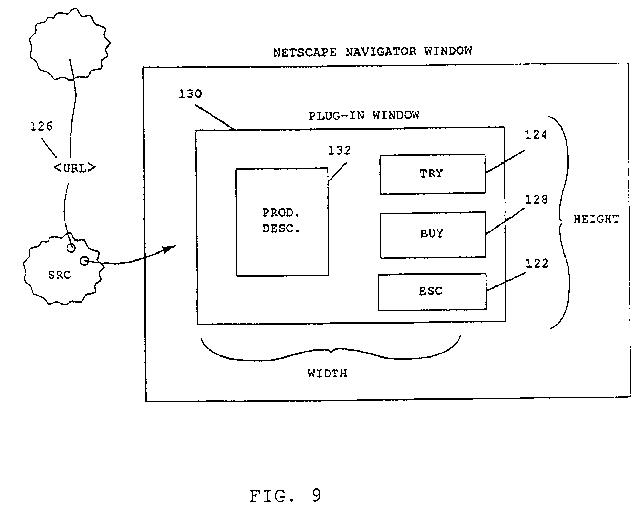
5,729,594 refers to four patents:
- 5,262,860 entitled "Method and system
communication establishment utilizing captured and processed visually perceptible data within a broadcast video signal"
filed by IBM on April 23, 1992
- 5,283,731 entitled "Computer-based
classified ad system and method" filed on December 23, 1992;
- 5,594,789 entitled "Transaction
implementation in video dial tone network" filed on October 13, 1994;
- 5,615,110 entitled "Security system for
non-cash transactions" filed on August 22, 1994 and whose priority date is May 19, 1994.
5,729,594 is referenced by 119 patents including:
- 5,995,626 entitled "Electronic shopping
method, electronic shopping system and document authenticating method relating thereto" filed on April 2, 1998 by Hitachi
but whose priority date is August 4, 1995;
- 5,991,738 entitled "Automated credit card
processing" filed on November 12, 1997 but whose priority date is February 5, 1996;
- 5,987,140 entitled "System, method and
article of manufacture for secure network electronic payment and credit collection" filed on April 26, 1996 by Verifone;
- 5,987,132 entitled "System, method and article of manufacture for conditionally accepting a
payment method utilizing an extensible, flexible architecture" filed on June 17, 1996 by Verifone;
- 5,983,208 entitled "System, method and
article of manufacture for handling transaction results in a gateway payment architecture utilizing a multichannel,
extensible, flexible architecture" filed on June 17, 1996 by Verifone.
- 5,963,924 entitled "System, method and
article of manufacture for the use of payment instrument holders and payment instruments in network electronic commerce"
filed on April 26, 1996 by Verifone;
- 5,963,917 entitled "Financial system of
computers" filed on October 5, 1998 and whose priority date is February 5, 1996;
- 5,946,665 entitled "On line shopping system
using a communication system" filed on July 16, 1996 by Fujitsu and whose priority date is February 26, 1996;
- 5,943,424 entitled "System, method and
article of manufacture for processing a plurality of transactions from a single initiation point on a multichannel,
extensible, flexible architecture" filed on June 17, 1996 by HP;
- 5,930,777 entitled "Method of charging for
pay-per-access information over a network" filed on May 23, 1997 and whose priority date is April 15, 1997;
- 5,930,767 entitled "Transaction methods
systems and device" filed by Motorola on May 28, 1997; disclose a "transaction method comprising steps of receiving a first
data element indicating an item in a transaction, receiving a second data element indicating a party of the transaction,
approving the transaction based upon the second data, and creating a record of the transaction.
- 5,889,863 entitled "System, method and
article of manufacture for remote virtual point of sale processing utilizing a multichannel, extensible, flexible architecture"
filed on June 17, 1996 by Verifone;
- 5,822,737 entitled "Financial transaction system"
filed on February 5, 1996.
5,708,780 is entitled "Internet server access
control and monitoring systems." It was filed by OpenMarket on June 7, 1995.
5,708,780 was identified by Barnes and Nobles and regarded by the appeal court as relevant prior art.
| Limitation |
5,708,780 |
| under control of a client system (1) |
A method of processing service requests from a client to a server system through a network [claim 1] |
| displaying information identifying the item (2) |
see FIG. 4 below |
| in response to only a single action being performed (3) |
see FIG. 4 below; "When a cursor 414 is positioned over link text 412b, the page which
would be retrieved by clicking a mouse;" the first request is redirected to the authentication server as depicted on FIG. 5;
subsequent requests are served in one action |
| sending a request to order the item [...] to a server system (4) |
"By clicking on the link text, the user causes the browser to generate a URL GET request"
|
| the request including the identifier so that the server system can locate additional
information needed to complete the order and so that the server system can fulfill the generated order to complete purchase
of the item (5) | "appending as part of a path name in a uniform resource locator the
session identifier to the request and to subsequent service requests from the client to the server system within a session of
requests" [claim 1]; "wherein the session identifier includes a user identifier" [claim 2]; |
| a data storage medium storing information for a plurality of users (7) |
"the authentication server queries an account database 216 to determine whether the user
is authorized 218 to access the requested document. A preferred account database may contain a user profile which includes
information for identifying purposes, such as client IP address and password, as well as user demographic information, such
as user age, home address, hobby, or occupation, for later use by the content server." |
| a receiving component for receiving requests to order an item [...], the request being
sent in response to only a single action being performed (8) | "The browser forwards the
request to a content server 120, which processes the request" |
| a request including an indication of one of the plurality of users (9) |
"One aspect of the invention involves forwarding a service request from the client to the
server and appending a session identification (SID) to the request and to subsequent service requests from the client to the
server within a session of requests." |
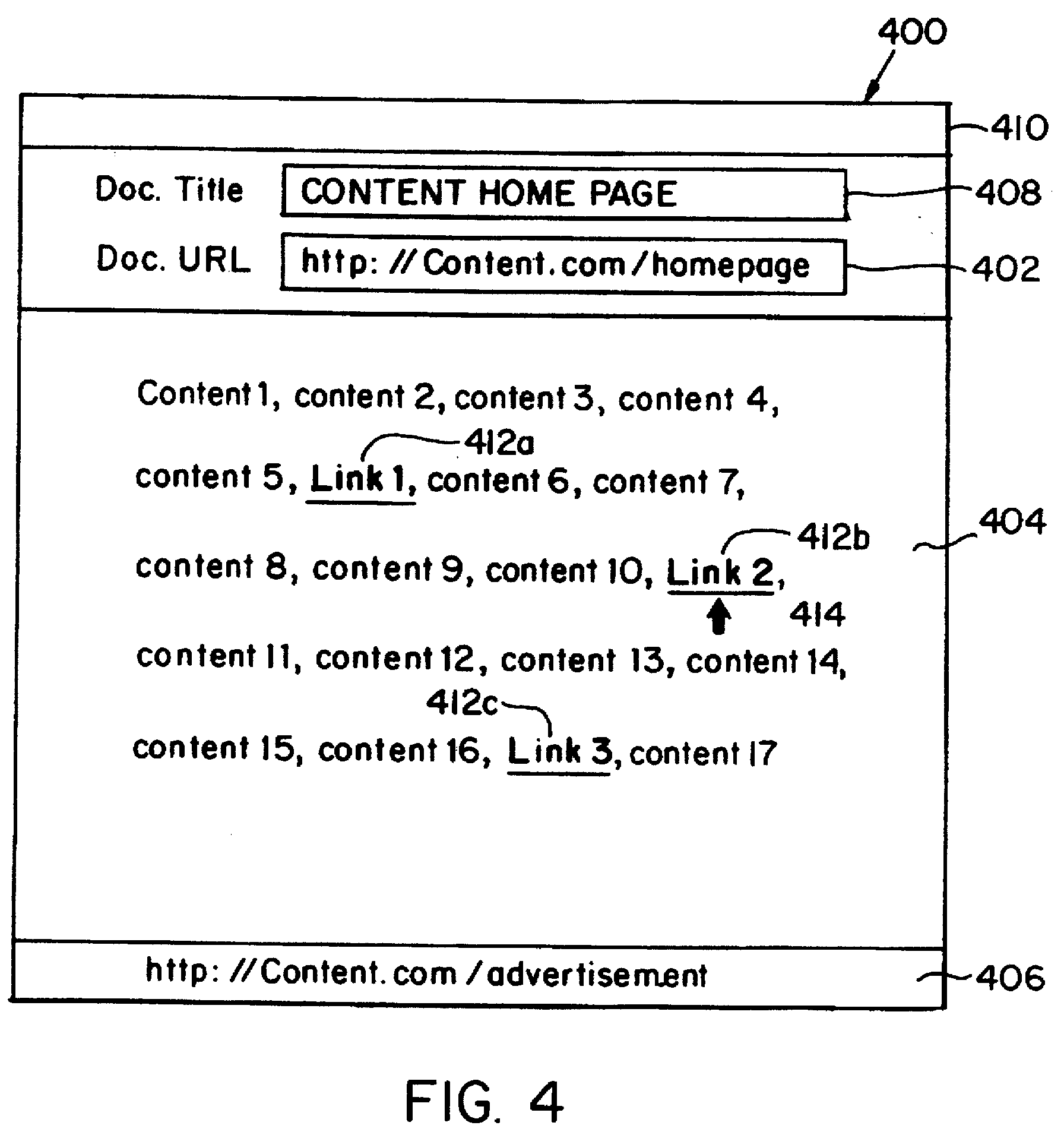
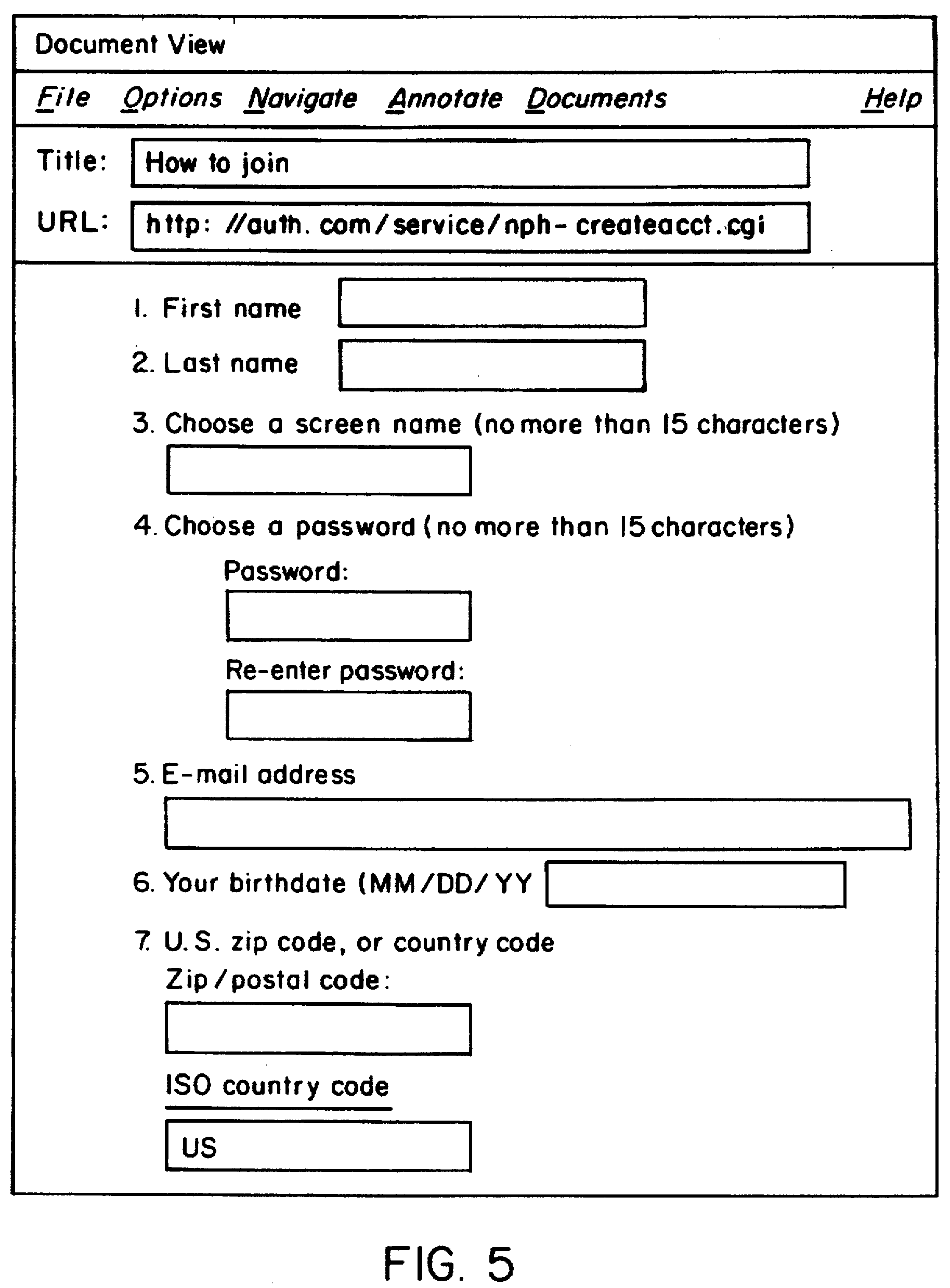 5,708,780 refers to seven patents:
5,708,780 refers to seven patents:
- 5,347,632 entitled "Reception system for
an interactive computer network and method of operation" filed by Prodigy on July 28,
1989 and whose priority date is July 15, 1988;
- 5,544,322 entitled "System and method for
policy-based inter-realm authentication within a distributed processing system" filed by IBM on May 9, 1994;
- 5,560,008 entitled "Remote authentication
and authorization in a distributed data processing system" filed by IBM on May 15, 1989;
- 5,577,209 entitled "Apparatus and method for
providing multi-level security for communication among computers and terminals on a network" filed by ITT on July 5, 1994;
- EP0456920 entitled "Remote authentication and
authorisation in a distributed data processing system" filed by IBM on May 15, 1989; a.k.a.
5,560,008 (see above);
- EP0645688 entitled "Method for the
identification of users of telematics servers" filed by the Nederland PTT on September 21, 1993;
- WO9403859 entitled "APPARATUS AND METHOD FOR
PROVIDING NETWORK SECURITY" by International Standard Electric Corp on July 31, 1992.
5,708,780 is referenced by 355 patents including
- 6,023,698 entitled "System and method for
transparently registering and updating information over the internet" filed by IBM on December 5, 1996;
- 6,009,412 entitled "Fully integrated on-line
interactive frequency and award redemption program" filed by Netcentives, Inc on June 25, 1998 but whose priority date is
December 14, 1995;
- 6,006,334 entitled "Method and system for
authentication over a distributed service to limit password compromise" filed by IBM on May 1, 1997;
- 5,987,480 entitled "Method and system for
delivering documents customized for a particular user over the internet using imbedded dynamic content" filed on July 25,
1996;
- 5,930,777 entitled "Method of charging for
pay-per-access information over a network" filed on May 23, 1997;
- 5,907,621 entitled "System and method for
session management" filed on November 15, 1996 by IBM;
- 5,875,296 entitled "Distributed file system
web server user authentication with cookies" filed by IBM on January 28, 1997;
4,734,858 is entitled "Data terminal and system
for placing orders " filed on November 26, 1984. Its priority date is December 5, 1983. 4,734,858 was identified by BountyQuest.
| Limitation |
4,734,858 |
| under control of a client system (1) |
a user located handholdable data terminal having a keyboard, a display, a memory, input/output means for establishing data
communication between the data terminal and the central processor through a telephone line [claim 10] |
| displaying information identifying the item (2) |
"In response to visually displayed prompts, the user selects, for example, the nature of the goods or services desired."
I understand that the display, an LCD displays the item number (see FIG. 2 below and "means for causing on said display a display
[...] representative of predetermined data of a particular order" [claim 1]). |
| in response to only a single action being performed (3) |
See FIG. 3. "Once the item has been specified it can be reviewed and modified or it can be stored in a send memory at 92 and later
caused to be sent at 94 by automatic dialing of the local processor center 14." |
| sending a request to order the item [...] to a server system (4) | "transmitting all of the data accumulated in the send memory to said local processing center," the send memory
containing the "user identification code" and the order [claim 1]. |
| the request including the identifier so that the server system can locate additional
information needed to complete the order and so that the server system can fulfill the generated order to complete purchase of the
item (5) | See row above and FIG. 6 |
| a data storage medium storing information for a plurality of users (7) |
See FIG. 6. "If this is an order for merchandise, the local processor center first appends additional
information available in its storage medium. Thus the user identification number is used to retrieve information such as the full name
of the user, the address, and credit information." |
| a receiving component for receiving requests to order an item [...], the request being sent in
response to only a single action being performed (8) | local processor center |
| a request including an indication of one of the plurality of users (9) | user identification number |
| an order placement component that retrieves from the data storage medium information for the
indicated user (10) | "If this is an order for merchandise, the local processor center first appends
additional information available in its storage medium. Thus the user identification number is used to retrieve information such as the
full name of the user, the address, and credit information." |
| uses the retrieved information to place an order for the indicated user for the item (11) |
"Thus, at 110 the LPC confirms that the user identification number entered at 84 in FIG. 3 and the
terminal number associated with the terminal seeking to place an order are correct or correspond and that suitable credit arrangements
have been identified. At 112 the data defining the item being ordered is confirmed as to availability of the service requested and as
to the data format and at 114 an appropriate message is composed to be returned to the data terminal at 116. |
| fulfilling the generated order to complete purchase of the item whereby the item is ordered
without using a shopping cart ordering model (12) | Upon verification, the LPC returns an
appropriate message for visual display at the terminal and processes the order to suppliers of the requested goods or services. |
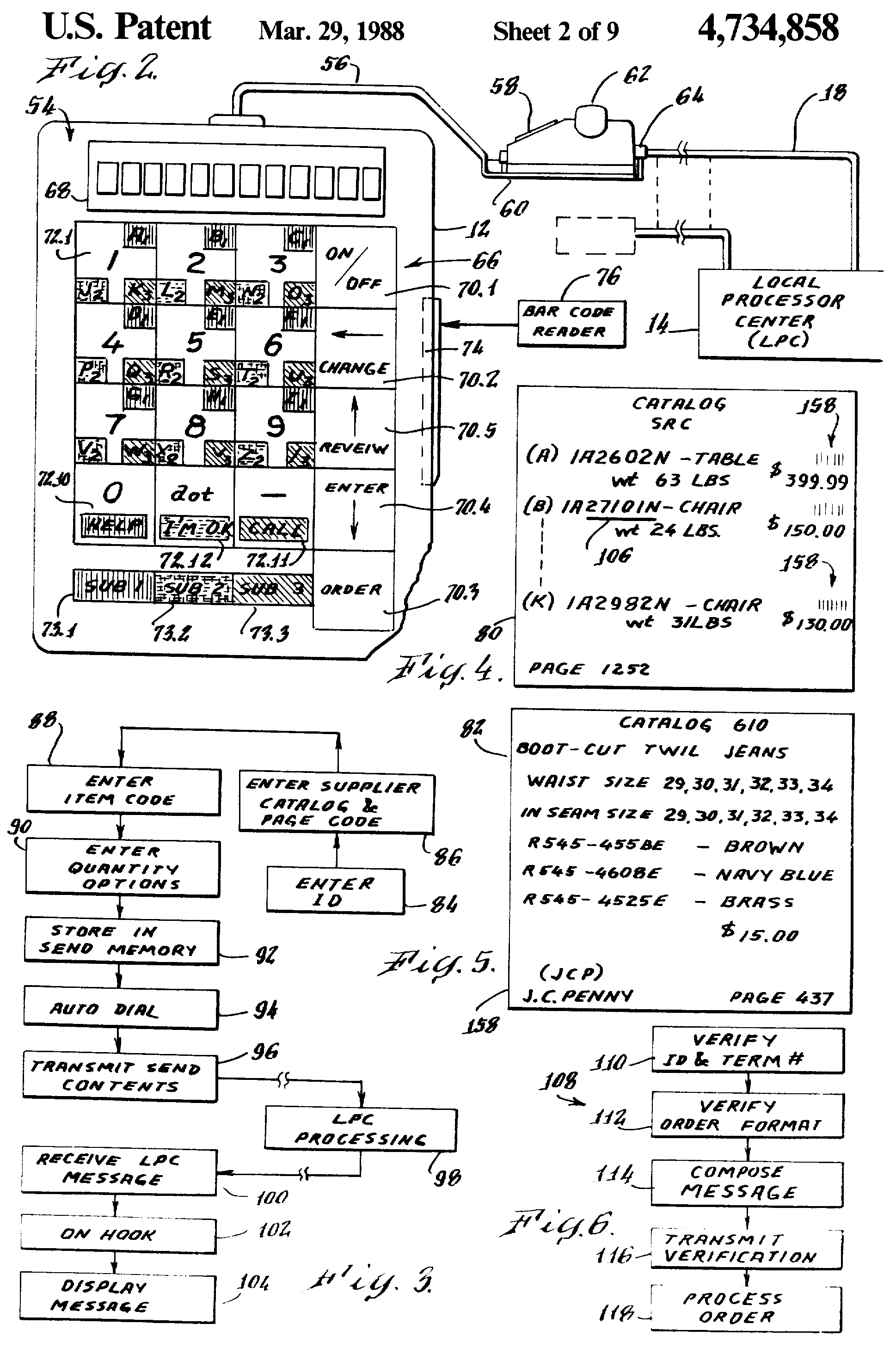
4,734,858 refers to ten patents:
- 3,719,927 entitled "Credit control system"
and filed on December 28, 1970;
- 4,115,870 entitled "Hand-held data
processing terminal" and filed on November 18, 1976;
- 4,266,271 entitled "Reconfigurable cluster
of data-entry terminals" and filed on October 10, 1978;
- 4,277,837 entitled "Personal portable terminal
for financial transactions" filed by IBM on February 11, 1980;
- 4,341,951 entitled "Electronic funds transfer
and voucher issue system" filed on July 2, 1980;
- 4,361,851 entitled "System for remote
monitoring and data transmission over non-dedicated telephone lines" filed on January 4, 1980;
- 4,415,065 entitled "Restaurant or retail
vending facility" filed on November 17, 1980;
- 4,460,965 entitled "Device for the use of and
easily carried by an individual" filed on February 6, 1981 and whose priority date is March 02, 1979;
- 4,511,970 entitled "Portable terminal device"
filed by Hitachi on March 31, 1982 and whose priority date is Apr 08, 1981;
- 3,719,927 entitled "Transaction device"
filed on December 20, 1979.
4,734,858 is referenced by 134 patents including:
- 6,091,823 entitled "Transaction processing
system utilizing teletext broadcasting system and terminal used in the transaction processing systems" filed by Fujitsu on
February 11, 1997 (the priority date being August 6, 1992);
- 5,909,492 entitled "Network sales system"
filed by OpenMarket on June 18, 1997 (the priority date being October 24, 1994);
- 5,808,894 entitled "Automated ordering
method" filed by Optipat on October 26, 1994 whose abstract reads:
"A method for automated ordering by a customer at a remote location to a vendor in a central location, comprises the steps
of composing an order at the remote location and entering the order into a customer computer; initiating a connection
between the customer computer and a vendor computer at the central location across a communications media; transmitting at
least the order and customer information identifying the customer to the vendor computer by the customer computer; verifying
the order in the vendor computer and transmitting a job number from the vendor computer to the customer computer; comparing
the customer information in the vendor computer with previously-stored customer database information; entering the order for
further processing in a first manner if the comparing step produces a match between the customer information and the
previously-stored customer database information; and entering the order for further processing in a second manner if the
comparing step does not produce a match between the customer information and the previously-stored customer database
information;"
- 5,715,314 entitled "Network sales system"
filed by OpenMarket on October 24, 1994;
- 5,440,479 entitled "Apparatus and method
for purchasing floral arrangements" filed on March 22, 1994;
- 5,438,355 entitled "Interactive system for
processing viewer responses to television programming" filed on April 16, 1993 whose abstract reads
"a viewer, upon seeing a TV program of interest, actuates a button, and the console transmits to the central exchange an
uniquely identifying console code together with the program code currently being read by the code reader";
- 4,984,155 entitled "Order entry system
having catalog assistance" filed on August 29, 1988;
5,303,393 is entitled "Integrated radio
satellite response system and method". It was filed by Radio Satellite Corporation on April 12, 1991. The priority date of
some parts is Nov. 6, 1990. 5,303,393 was identified by BountyQuest.
5,303,393 does not belong to the same online sale domain (not to mention Internet and HTTP) as 1-click.
Nevertheless first claim teaches something similar:
A radio response system for user with a processing center comprising:
- transmitter-means for broadcasting a program signal;
- a plurality of mobile stations, each mobile station including,
- receiver-means for receiving the program signal;
- interface means for communicating the program signal to a user; [~ displaying information identifying the item]
- controller means for processing program identification information from the program signal and for generating from the
processed program identification information and a user-input signal, a user-data signal; and
- data-transmitter means for transmitting the user-data signal as a transmitted-data signal;
[sending a request to order the item along with an identifier of a purchaser of the item to a server system]
- repeater means responsive to receiving the transmitted-data signal for relaying the user-data signal to said processing
center [routing]; and
- location means responsive to receiving the transmitted-data signal through at least two of the repeater means for
determining a location of said mobile station.
So patents refered by 5,303,393 and referencing 5,303,393 are not necessarily of interest.
| Limitation |
5,303,393 |
| under control of a client system (1) |
mobile station |
| displaying information identifying the item (2) |
"The method further includes communicating at the mobile terminal 401 the program signal to a user. The program signal can be
music with advertisements or solicitations periodically placed between music selections. The program signal is communicated to
the user through a audio device such as a speaker. Additionally, the program signal may communicate to the user video
information which would be displayed on a visual display.
The user has the option of inputting to the mobile terminal 401 a user-input signal. The user can generate the user-input
signal by speaking into a microphone which converts the user's voice to a digital signal processes the converted voice signal
to generate a user-input signal. For example, the user might speak the word ORDER which indicates to place an order of the item
being advertised in the advertisement of the program signal. The spoken word ORDER is converted to a digital signal, identified
and recognized. The resulting output is the user-input signal. Alternatively, the user may place an order by pushing a button
or touching a touch screen on a display." |
| in response to only a single action being performed (3) | "The method further includes using the identification information and the user-input signal to generate a user-data
signal." "The user-data signal is modulated on a carrier signal at a carrier frequency, and the modulated carrier frequency is
transmitted by data transmitter 404 as a transmitted-data signal. The transmitted-data signal is relayed through a satellite 421
to the processing center 422." |
| sending a request to order the item [...] to a server system (4) | server system = processing center; see FIG. 4 below. |
| the request including the identifier so that the server system can locate additional
information needed to complete the order and so that the server system can fulfill the generated order to complete purchase of
the item (5) | "The satellite 421 relays the transmitted-data signal to the processing center
422. The processing center 422, which receives the user-data signal from the satellite 421, demodulates the user-data signal from
the transmitted-data signal, and processes information from the user-data signal, and determines identification information." |
| a data storage medium storing information for a plurality of users (7) |
"A user may input a credit card number for placing an order, or a user's credit card number may
be stored at the processing center." |
| a receiving component for receiving requests to order an item [...], the request being sent
in response to only a single action being performed (8) | receiving component = processing
center; see FIG. 4 below. |
| a request including an indication of one of the plurality of users (9) |
"The method further includes using the identification information and the user-input signal to
generate a user-data signal." |
| an order placement component that retrieves from the data storage medium information for the
indicated user (10) | "The processing center 422, which receives the user-data signal from the
satellite 421, demodulates the user-data signal from the transmitted-data signal, and processes information from the user-data
signal, and determines identification information." |
| uses the retrieved information to place an order for the indicated user for the item (11)
| "order goods or services offered for sale." "For example, the user might speak the word
ORDER which indicates to place an order of the item being advertised in the advertisement of the program signal;" "the processing
center 422 can [...] process an order by a user." |
| fulfilling the generated order to complete purchase of the item whereby the item is ordered
without using a shopping cart ordering model (12) | The response, for example, might be ordering
something which is being offered for sale. The music which was most recently played and sent over the program signal, for example,
might be offered for sale on a compact disc. The user has the option of ordering the compact disc by inputting a user-input signal
using input device 416. The user might generate the user-input signal by speaking into a microphone. In this case, the controller 403
is programmed to recognize the user's voice and the command. For example, the command might be ORDER. In response to ORDER, the
user-input signal would send this information to order the compact disc. Alternatively, the input device 416 might be a push button
or a touch screen of a display. The user merely would push the push button or touch the appropriate place on the display screen for
ordering the compact disc.
The controller 403 generates a user-data signal which includes the order information generated from the input device 416. The
controller 403 also may process identification information from the program signal which was received from the broadcast receiver 402.
The identification information may include identification of the advertisement which offered the compact disc, for example, for sale,
an identification of the broadcast transmitter 411, the carrier frequency of the program signal, or any other information which would
identify the advertisement, solicitation, or other communication inviting a response. Additionally, the controller 403 may also have
location information as to the location and positioning of the mobile terminal 401. The identification information and user-input
signal is combined in the controller 403 as a user-data signal. |
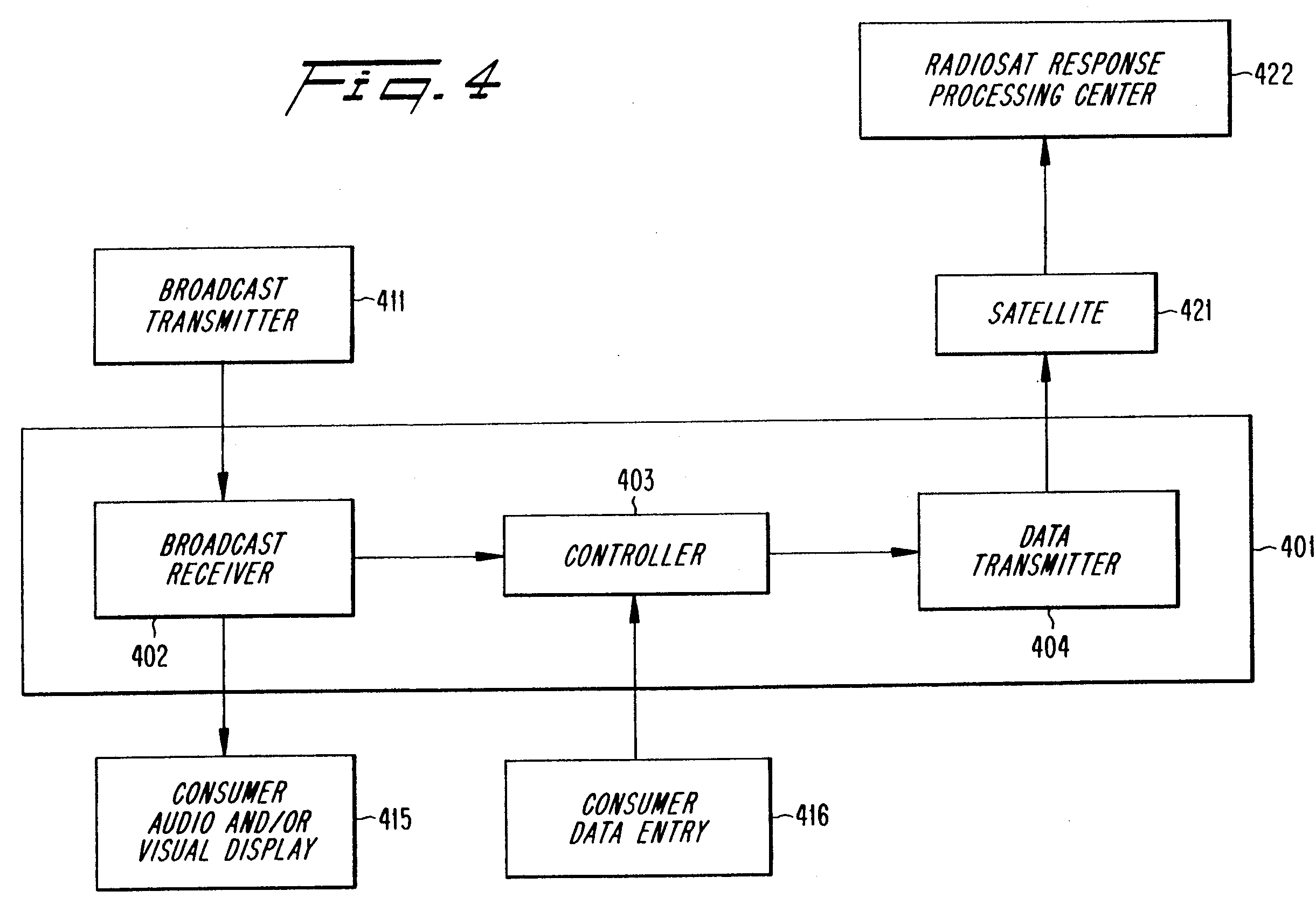
5,303,393 was a brillant idea thoroughly developed. There were still work around it in
1999.
5,303,393 refers to 25 patents:
- 3,683,116 entitled "Terrestrial interface
unit" filed on July 16, 1969;
- 4,425,639 entitled "Satellite communications
system with frequency channelized beams" filed by Bell Labs on January 12, 1981;
- 4,437,183 entitled "Method and apparatus for
distributing control signals" filed on January 12, 1981;
- 4,501,002 entitled "Offset QPSK demodulator
and receiver" filed on February 28, 1983;
- 4,599,734 entitled "Space diversity
communications system for multi-direction time division multiplex communications" filed by NEC on April 5, 1985 and whose
priority date is April 10, 1984;
- 4,635,247 entitled "High-speed burst signal
monitoring device" filed by NEC on February 22, 1985 and whose priority date is February 24, 1984;
- 4,635,285 entitled "Communication system with
voice priority for remote stations" filed by Motorola on April 12, 1984;
- 4,660,196 entitled "Digital audio satellite
transmission system" filed on January 27, 1986 and whose priotity date is August 8, 1983;
- 4,742,512 entitled "Multipoint communication
system having polling and reservation schemes" filed by NEC on July 18, 1986 and whose priority date is July 19, 1985;
- 4,754,465 entitled "Global positioning system
course acquisition code receiver" filed on May 7, 1984;
- 4,759,016 entitled "TDMA communication system
having common local path medium and local time slot for intraoffice calls" filed by NEC on May 4, 1987 and whose priority date
is May 09, 1986;
- 4,837,786 entitled "Technique for mitigating
rain fading in a satellite communications system using quadrature phase shift keying" filed on August 7, 1986;
- 4,852,090 entitled "TDMA communications system
with adaptive equalization" filed by Motorola on April 13, 1988;
- 4,860,352 entitled "Satellite communication
system and method with message authentication suitable for use in financial institutions" filed on May 20, 1985;
- 4,868,811 entitled "Multiple access
communication system" filed by Toshiba on February 29, 1988 and whose priority date is Mar 10, 1987;
- 4,870,660 entitled "Variable frequency rate
receiver" filed by Unisys on December 28, 1987;
- 4,882,730 entitled "TDMA communication system
having common time slots for system maintenance" filed by NEC on November 30, 1987 and whose priority date is November 28,
1986;
- 4,903,320 entitled "Apparatus for selecting
control channel in mobile communication system" filed by Fujitsu on March 18, 1988 and whose priority date is March 20,
1987;
- 4,951,279 entitled "Transceiver for use in
earth station in satellite communications system" filed by NEC on October 19, 1988 and whose priority date is October 20,
1987;;
- 4,979,170 entitled "Alternating sequential
half duplex communication system" filed by Qualcomm on January 19, 1988;
- 4,987,486 entitled "Automatic interactive
television terminal configuration" filed on December 23, 1988;
- 5,027,400 entitled "Multimedia bidirectional
broadcast system" filed by Hitachi on August 16, 1989 and whose priority date is August 19, 1988;
- 5,036,389 entitled "Satellite controlled
audience polling system" filed on July 14, 1989;
- 5,057,915 entitled "System and method for
attracting shoppers to sales outlets" filed on October 25, 1990 and whose priority date is Mar. 10, 1986;
- 5,119,504 entitled "Position aided subscriber
unit for a satellite cellular system" filed by Motorola on July 19, 1990.
5,303,393 is referenced by 99 patents.
5,819,034 is entitled "Apparatus for
transmitting and receiving executable applications as for a multimedia system". It was filed on April 28, 1994.
EP680185 / 5,819,034 was identified by BountyQuest.
EP680185 / 5,819,034 relates to interactive TV. The description reads:
"When a viewer wishes to order an item, a button is pressed on the TV remote control. This button signals the client computer
22 to display a series of instructions and menus necessary to solicit the information necessary to place the order, e.g. the
item number, name and address of the viewer, the method of payment, the credit card number (if needed), etc. These
instructions are generated in the client computer as graphics which are overlaid on the television video image. It is also
possible for a computer generated voice to be generated and combined with the television audio either by voice-over, or by
replacing the television audio. The viewer responds to the instruction by providing the requested information via the TV
remote control. When the information requested by the on-screen display and/or voice instructions has been entered by the
viewer, it is sent to a central computer via the modem in the client computer. An order confirmation may be sent in the other
direction from the central computer.
It is also possible that permanent information about the viewer (i.e. the name, address, method of payment and credit card
number) may be preentered once by the viewer, so it is not necessary to solicit that information each time an order is
placed. The information is stored in permanent memory in the client computer. In such a case, when an order is placed, that
information is retrieved from the permanent memory, appended to the item number and transmitted to the central computer."
| Limitation |
5,819,034 |
| under control of a client system (1) |
"a client computer, which includes a packet selector connected to said source for selecting and directing packets containing
said auxiliary data representing said video program to a video signal processor and selecting and directing packets containing
said associated distributed computing application to a further processor" [claim 1] |
| displaying information identifying the item (2) |
"The client computer 22 interacts with a user 80 by providing information to the user via a display screen or other output
device and by accepting information from the user via a keyboard or other input device." "When a viewer wishes to order an item,
a button is pressed on the TV remote control. This button signals the client computer 22 to display a series of instructions and
menus necessary to solicit the information necessary to place the order, e.g. the item number, name and address of the viewer,
the method of payment, the credit card number (if needed), etc. These instructions are generated in the client computer as
graphics which are overlaid on the television video image." "t is further possible that, by means of time codes, or other
commands, inserted into the data stream, the client computer will know which item is currently being offered for sale. In such a
case, the viewer will be able to order it by simply pressing one button on the TV remote control. |
| in response to only a single action being performed (3) | "permanent information about the viewer (i.e. the name, address, method of payment and credit card number) may be
preentered once by the viewer, so it is not necessary to solicit that information each time an order is placed. |
| sending a request to order the item [...] to a server system (4) | "permanent information about the viewer (i.e. the name, address, method of payment and credit card number)" is
"appended to the item number and transmitted to the central computer." |
| the request including the identifier so that the server system can locate additional
information needed to complete the order and so that the server system can fulfill the generated order to complete purchase of
the item (5) | see above |
| a receiving component for receiving requests to order an item [...], the request being sent
in response to only a single action being performed (8) | receiving component = central
computer |
| a request including an indication of one of the plurality of users (9) |
"permanent information about the viewer (i.e. the name, address, method of payment and credit
card number)" is "appended to the item number and transmitted to the central computer." |
5,819,034 refers to 17 patents:
- 3,803,491 entitled "Communication system"
filed on January 26, 1972;
- 3,891,792 entitled "Television character
crawl display method and apparatus" filed on June 25, 1972;
- 4,264,925 entitled "Interactive cable
television system" filed on August 13, 1979;
- 4,323,922 entitled "Television coding
system with channel level identification" filed on December 17, 1979;
- 4,528,589 entitled "Method and system for
subscription television billing and access" filed on February 1, 1984;
- 4,937,784 entitled "Distributed interactive
processing method in complex system including plural work stations and plural host computers and apparatus using the same"
filed by Hitachi on June 2, 1987 and whose priority date is June 02, 1986;
- 4,965,825 entitled "Signal processing
apparatus and methods" filed on September 11, 1987 that partly has a priority date of November 3, 1981;
- 5,129,080 entitled "Method and system
increasing the operational availability of a system of computer programs operating in a distributed system of computers"
filed by IBM on October 17, 1990;
- 5,168.356 entitled "Apparatus for segmenting
encoded video signal for transmission" filed by General Electric on December 20, 1991 and whose priority date is February 27,
1991;
- 5,191,573 entitled "Method for transmitting
a desired digital video or audio signal" filed on September 18, 1990 and whose priority date is June 13, 1988;
- 5,233,654 entitled "Signal processing
apparatus and methods" filed on March 10, 1992 and whose priority date is November 3, 1981;
- 5,343,238 entitled "Wide-screen television
receiver with aspect ratio conversion function and method of displaying a range to be magnified and displayed" filed by
Hitachi on May 22, 1992 and whose priority date is May 23, 1991;
- 5,440,744 entitled "Methods and apparatus
for implementing server functions in a distributed heterogeneous environment" filed by Digital on November 15, 1994 and whose
priority date is Aug. 14, 1990;
- 5,548,532 entitled "Apparatus and method for
formulating an interactive TV signal" filed on April 28, 1994;
- 5,600,364 entitled "Network controller for
cable television delivery systems" filed on December 2, 1993 and whose some parts have a priority date of Dec. 9, 1992;
- EP0145063 entitled "Cable television network"
filed by International Standard Electric Corp on November 18, 1983;
- EP0570683 aka
5,642,515 entitled "Network server for local
and remote resources" filed on April 17, 1992.
5,819,034 is referenced by 17 patents.
5,809,483 is entitled "Online transaction
processing system for bond trading". It was filed on November 14, 1997 as a continuation of an application filed on
May 13, 1994. I identified this application.
Users first sign-in:
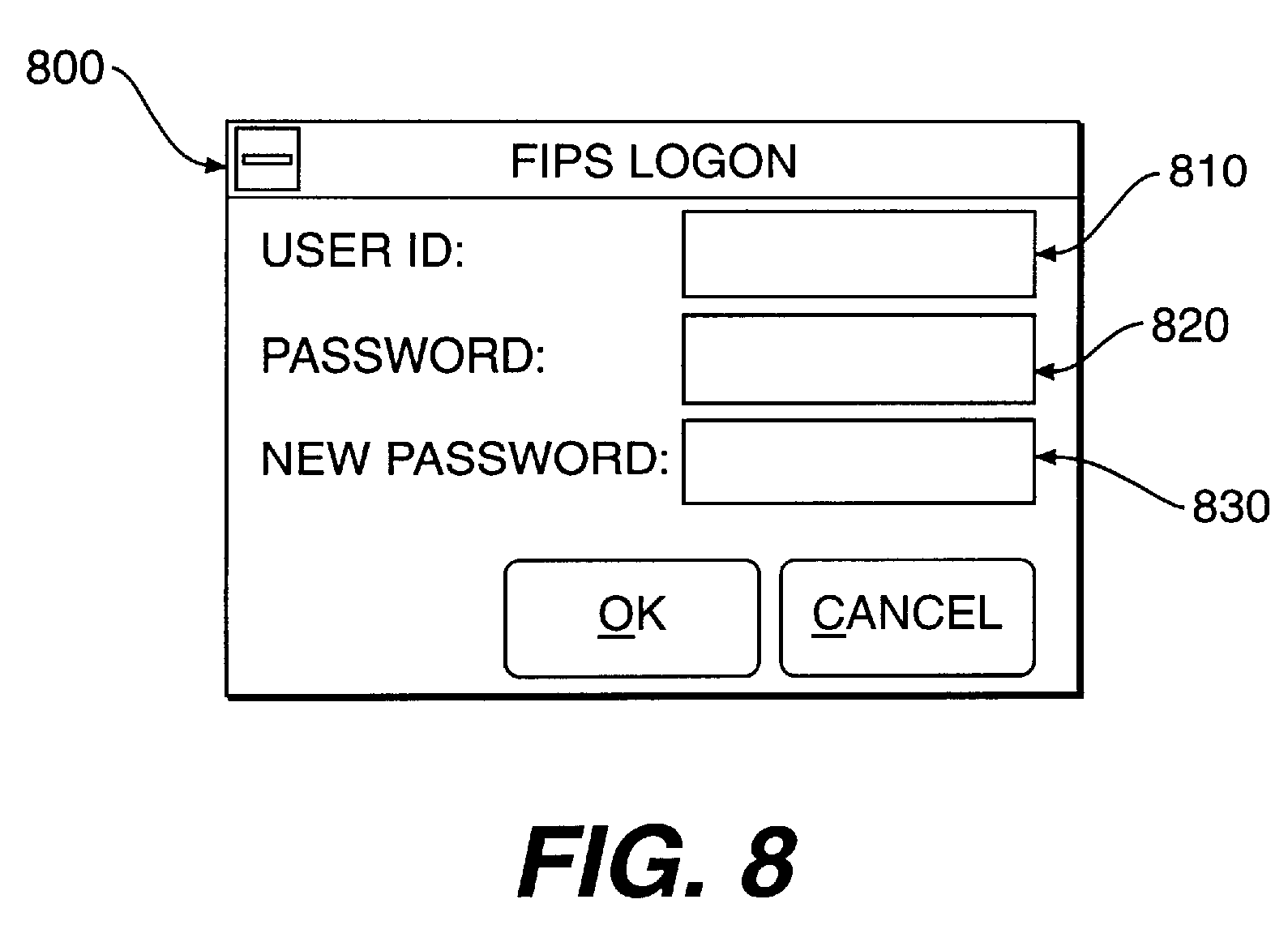
Users enters their user identification (ID) into field 810, and then password into password field 820. Users also have
the option of entering a new password in field 830.
Then they can buy or sell in one action:
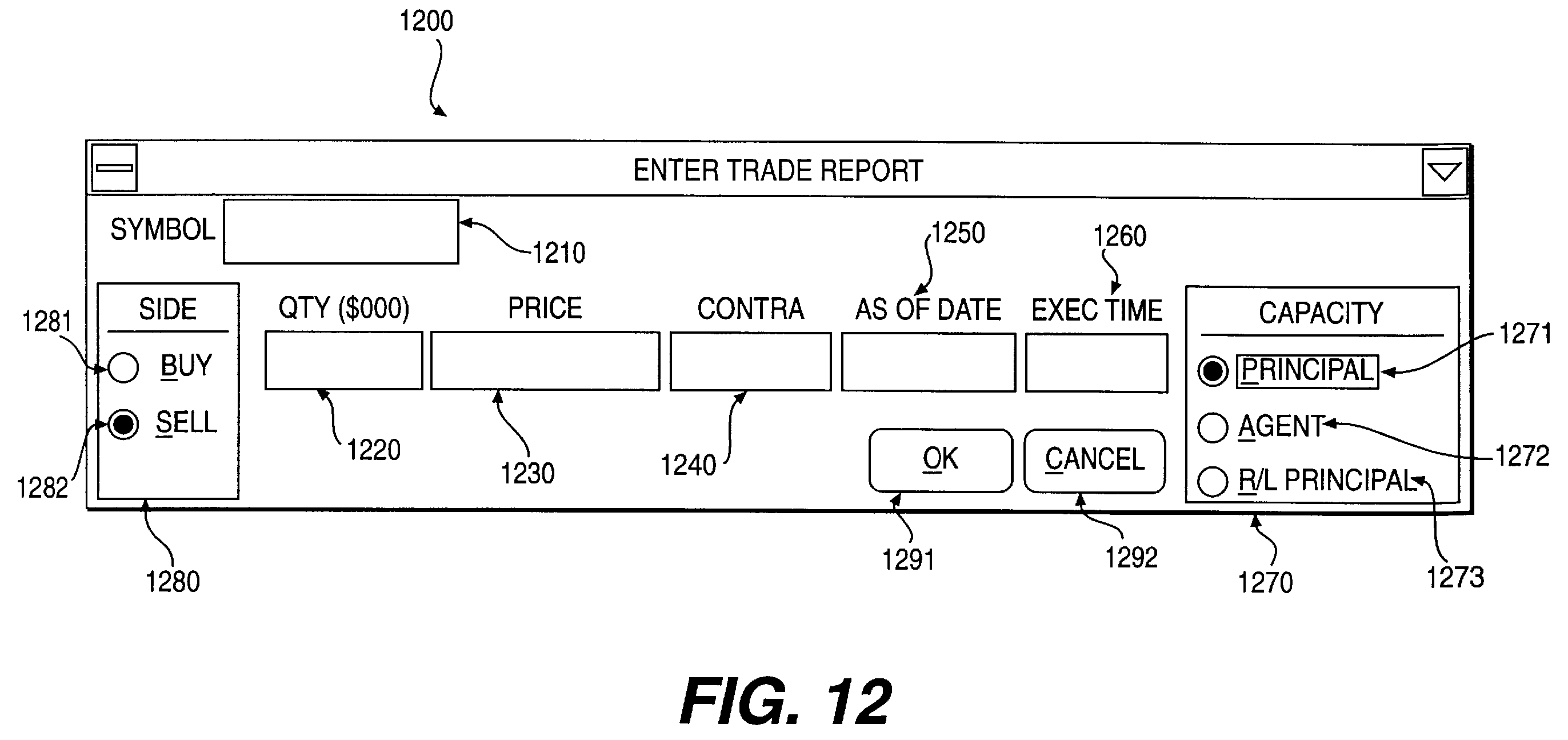
FIPS supplies the Enter Trade Report window 1200 shown in FIG. 12. Window 1200 allows dealers to input the necessary
information about a trade, including quantity, price, the other party to the trade, the type of trade, the execution date
and time of the trade, and the capacity of the dealer.
Next, the user selects either a Buy or Sell trade report using button 1281 for a buy report, and button 1282 for a sell
report. Buttons 1281 and 1282 appear in side box 1280. If user is a dealer, the default trade type is "sell."
There is a next step (buy or sell report) related to bond trading. So this is not one click though a item sell equivalent
would be 1-click.
The system of the invention is called "the Fixed Income Pricing System or FIPS".
"Users may interface with the FIPS host is by way of a FIPS workstation, such as a Sun Workstation running the UNIX
operating system, or a 386/486 personal computer running Windows 3.X. The workstation includes a Graphical User Interface
(GUI), a full communication interface with a FIPS host, and distributed processing functionality. The FIPS workstation can
access the FIPS host using leased or asynchronous lines."
"A second way users may access the host is through an application programming interface, API. The API allows users to
create their own customized interface for trade reports, bond quotes, and other FIPS function. The API is a library of
procedures an application programmer can use to access the various features and systems of FIPS."
The invention uses a TCP/IP network and routing means exposed in detail. Therefore as exposed in the
1-click analysis each message sent to the server contains the combination (source IP
address, destination IP address, source port, destination port) that uniquely identifies a user at a given time.
| Limitation |
5,809,483 |
| under control of a client system (1) | user
station |
| displaying information identifying the item (2) |
"the display means of each user station includes means for displaying data from the quote databases" [claim 11] |
| in response to only a single action being performed (3) | see the discussion and drawings above |
| sending a request to order the item [...] to a server system (4) |
"host processor comprising [...] communications means, coupled to the memory means, for
receiving from the plurality of user stations user inputs about quotes for the issues to be traded, for receiving requests
for data from the issue databases and the quote databases, for providing the requested data to the requesting one of the
plurality of user stations, and for receiving from the plurality of user stations data indicating actual trade executions"
[claim 5] |
| the request including the identifier so that the server system can locate additional
information needed to complete the order and so that the server system can fulfill the generated order to complete purchase
of the item (5) | "A method for reporting the trading of debt issues comprising the steps,
executed by a data processing system and a plurality of user stations, of [...] providing to the data processing system user
inputs about a current user of the system" [claims 16, 18]. FIG. 8 shows how the user logs in. The preferred embodiment uses
a client/server architecture with a TCP network and Cisco routers. So TCP packets contain an identifiers allowing the host
processing system to retrieve the current user. |
| a data storage medium storing information for a plurality of users (7) |
"the host processing system includes participant databases having information about the
users of the system" [claim 3] |
| a receiving component for receiving requests to order an item [...], the request being
sent in response to only a single action being performed (8) | For instance "The user
inputs the dollar price of the issue that it is willing to pay to purchase the issue" and "If the user selects the OK button,
the information indicated by the user is sent to the FIPS host 210 for processing." |
| a request including an indication of one of the plurality of users (9) |
See explanation above. TCP/IP (user address, user port, host address, host port) in
client/server implementation, session cookie in a HTTP implementation. |
| an order placement component that retrieves from the data storage medium information
for the indicated user (10) | Claim 3 reads:
The system of claim 1 wherein
- the host processing system includes participant databases having information about the users of the system, and wherein
- the input means includes means for providing to the host processing system user inputs about the current user of the
system.
|
| uses the retrieved information to place an order for the indicated user for the item (11)
| "communications means, coupled to the memory means, for receiving from the plurality
of user stations user inputs about quotes for the issues to be traded, for receiving requests for data from the issue
databases and the quote databases, for providing the requested data to the requesting one of the plurality of user stations,
and for receiving from the plurality of user stations data indicating actual trade executions" [claim 11] |
| fulfilling the generated order to complete purchase of the item whereby the item is
ordered without using a shopping cart ordering model (12) | "trades of debt issues are
made through broker's brokers" [claim 12] |
The difference with 1-click is that 5,809,483 brokers make offers and bids and settle deals in one action whereas 1-click
users issue orders.
5,809,483 refers to ten patents:
- 4,903,201 entitled "Automated futures
trading exchange" filed on November 3, 1983;
- 5,003,473 entitled "Trading ticket output
system" filed by Reuter on October 24, 1988;
- 5,077,665 entitled "Distributed matching
system" filed by Reuter on May 25, 1989;
- 5,101,353 entitled "Automated system for
providing liquidity to securities markets" filed on May 31, 1989;
- 5,227,967 entitled "Security instrument data
system without property inapplicable nulls" filed on March 20, 1989;
- 5,230,048 entitled "Data processing system
with tree and list data structure" filed by Wang on February 15, 1991 and whose priority date is September 3, 1986;
- 5,231,571 entitled "Personal financial
assistant computer method" and whose priority date is August 14, 1990;
- 5,245,535 entitled "System for demonstrating
financial concepts and displaying financial data" filed by Citybank on April 5, 1991;
- 5,270,922 entitled "System for distributing,
processing and displaying financial information" filed by Merrill Lynch on June 27, 1991 and whose priority date is Jun. 29,
1984;
- 5,375.055 entitled "Credit management for
electronic brokerage system" filed on February 3, 1992.
5,809,483 is referenced by 42 patents.
5,754,939 is entitled "System for generation of
user profiles for a system for customized electronic identification of desirable objects". It was filed on October 31, 1995
and its priority date is November 28, 1994. I identified this application.
Claim 1 reads:
"A method for providing a user with access to selected ones of a plurality of target objects and sets of target object
characteristics that are accessible via an electronic storage media, where said users are connected via user terminals and
data communication connections to a target server system which accesses said electronic storage media, said method comprising
the steps of:
- automatically generating at least one user target profile interest summary for a user at a user terminal, each of said
user target profile interest summary being indicative of ones of said target objects and sets of target object
characteristics accessed by said user; and
- storing said at least one user target profile interest summary in a memory.
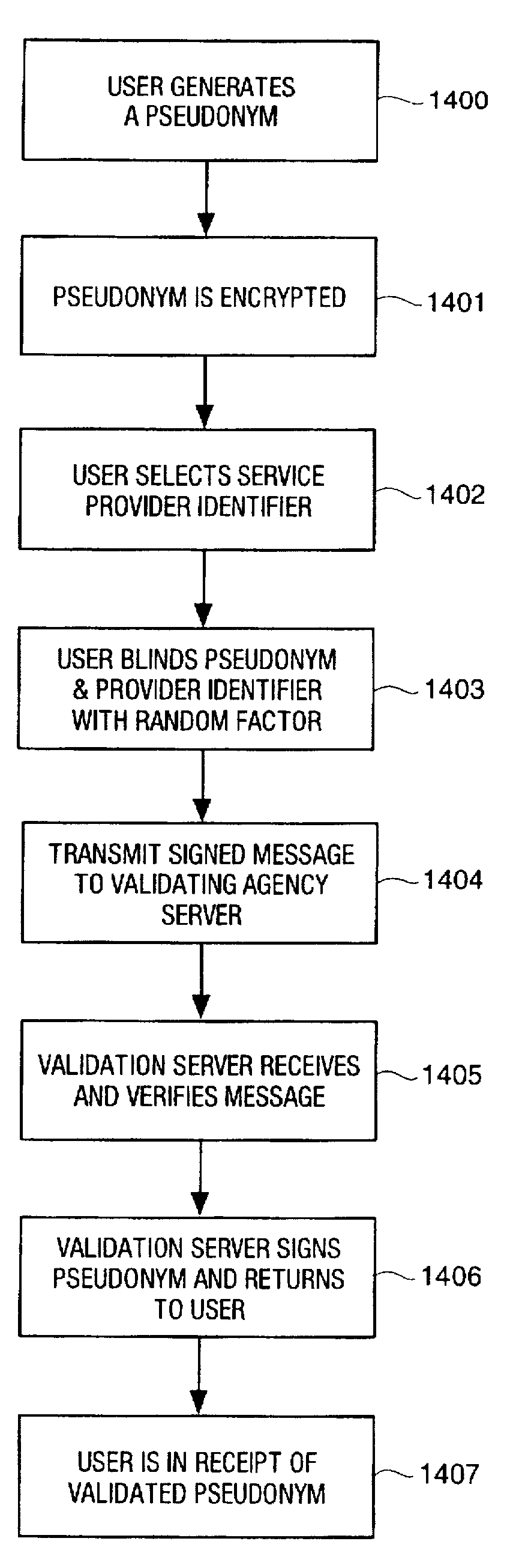
FIG. 14. The user authenticates. The server assigns and returns an identifier to the user.
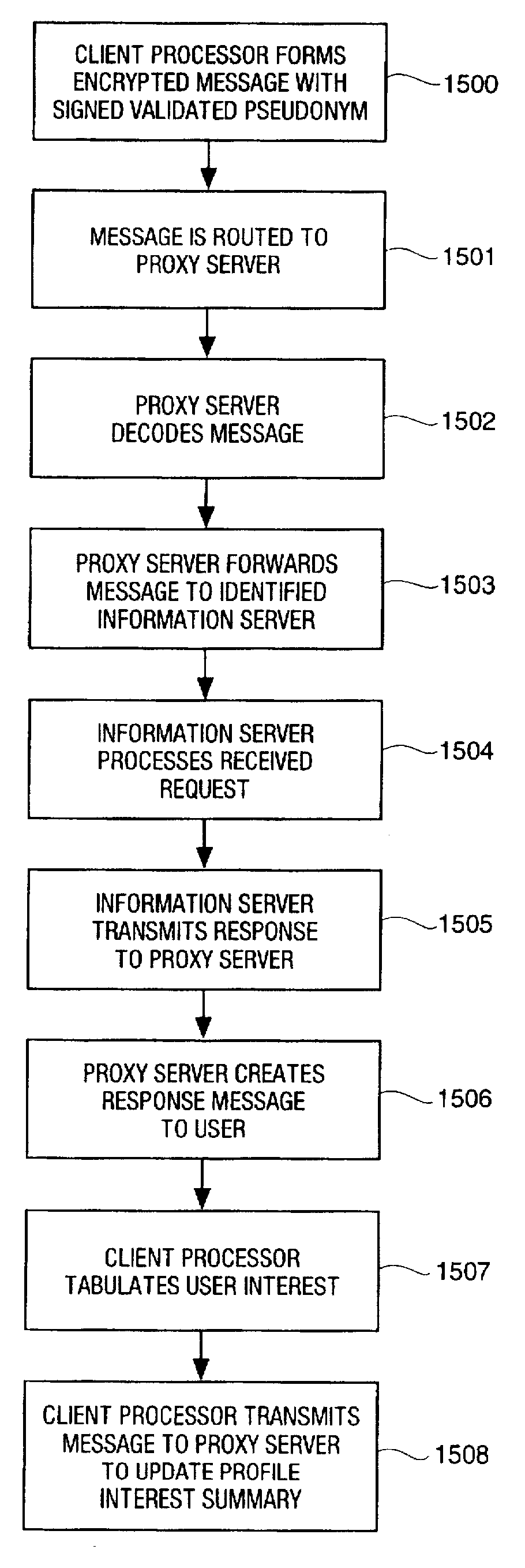
FIG. 15. The client processor forms a request with said identifier. The server fulfills the request.
One may question the relationship between customer profile update and ordering. The original titled of this invention is
"SYSTEM AND METHOD FOR SCHEDULING BROADCAST OF AND ACCESS TO VIDEO PROGRAMS AND OTHER DATA USING CUSTOMER PROFILES." So the
presentation relates to a kind of negotiated ordering: "Here are my preferences. Please broadcast me the programs that best
match said preferences."
| Limitation |
5,754,939 |
| under control of a client system (1) | "A method
for providing a user with access to selected ones of a plurality of target objects and sets of target object characteristics
that are accessible via an electronic storage media, where said users are connected via user terminals and data communication
connections to a target server system which accesses said electronic storage media" [claim 1] |
| displaying information identifying the item (2) |
Claim 4 reads: "The method of claim 3 wherein said step of enabling access further comprises: transmitting a list, that
identifies at least one of said identified ones of said plurality of target objects and sets of target object characteristics,
to said user; and
providing access to a selected one of said plurality of target objects and sets of target object characteristics stored on
said electronic storage media in response to said user selecting an item from said list." |
| in response to only a single action being performed (3) | "transmitting data, in response to said user activating said user terminal to identify said selected item on
said list, indicative of said user's selection of said selected item from said user terminal to said target server via a one
of said data communication connections" [claim 5] |
| sending a request to order the item [...] to a server system (4) |
aforementioned claim 5 |
| the request including the identifier so that the server system can locate additional
information needed to complete the order and so that the server system can fulfill the generated order to complete purchase
of the item (5) | see FIG. 14 and 15 |
| a data storage medium storing information for a plurality of users (7) |
"A pseudonym is an artifact that allows a service provider to communicate with users and
build and accumulate records of their preferences over time, while at the same time remaining ignorant of the users' true
identities, so that users can keep their purchases or preferences private." "A second function of the proxy
server is to record user-specific information associated with user U. This user-specific information includes a user profile
and target profile interest summary for user U, as well as a list of access control instructions specified by user U, as
described below, and a set of one-time return addresses provided by user U that can be used to send messages to user U
without knowing user U's true identity. All of this user-specific information is stored in a database that is keyed by user
U's pseudonym (whether secure or non-secure) on the proxy server." [in this invention proxy cannot be construed as HTTP
proxy] |
| a receiving component for receiving requests to order an item [...], the request being
sent in response to only a single action being performed (8) | service provider.
"The target objects may be published articles, purchasable items." "Examples of target objects can include, but are not
limited to: a newspaper story of potential interest, a movie to watch, an item to buy." For single action see FIG. 15. |
| a request including an indication of one of the plurality of users (9) |
the client processor forms a message with signed validated pseudonym (Fig. 15) and
"At any time after database entry for Pseudonym P is established, the user U may provide proxy server S2 with credentials on
that pseudonym, provided by third parties." "The proxy server [...] may also store those credentials, so that it can present
them to service providers on the user's behalf." |
| an order placement component that retrieves from the data storage medium information for
the indicated user (10) | the service provider checks credentials presented above |
| uses the retrieved information to place an order for the indicated user for the item
(11) | inherent. When the target object is an item to buy use presented credentials.
|
| fulfilling the generated order to complete purchase of the item whereby the item is
ordered without using a shopping cart ordering model (12) | inherent for instance when
the target object is a movie to watch or an item to buy |
5,754,939 refers to 23 patents:
- 4,529,870 entitled "Cryptographic
identification, financial transaction, and credential device" filed on June 25, 1982 and whose priority date is October 3,
1980;
- 4,706,080 entitled "Interconnection of
broadcast networks" filed on August 26, 1985;
- 4,759,063 entitled "Blind signature systems"
filed on August 22, 1983;
- 4,914,698 entitled "One-show blind signature
systems" filed on July 24, 1989 and whose priority date is March 16, 1988;
- 4,926,480 entitled "Card-computer moderated
systems" filed on May 24, 1988; parts of the subject matter have a priority date of August 22, 1983;
- 4,947,430 entitled "Undeniable signature
systems" on November 23, 1987;
- 4,987,593 entitled "One-show blind signature
systems" filed on April 5, 1990;
- 5,131,039 entitled "Optionally moderated
transaction systems" filed on November 5, 1990 and whose priority date is January 29, 1990;
- 5,136,501 entitled "Anonymous matching
system" filed by Reuter on May 26, 1989;
- 5,245,656 entitled "Security method for
private information delivery and filtering in public networks" filed on September 9, 1992;
- 5,251,324 entitled "Method and apparatus for
generating and collecting viewing statistics for remote terminals in a cable television system" file on March 19, 1991,
the priority date of some parts being March 20, 1990;
- 5,276,736 entitled "Optionally moderated
transaction systems" filed on July 13, 1992 and whose priority date is January 29, 1990;
- 5,301,109 entitled "Computerized
cross-language document retrieval using latent semantic indexing" filed on July 17, 1991, the priority of some parts being
June 11, 1990;
- 5,321,833 entitled "Adaptive ranking system
for information retrieval" filed on August 29, 1990;
- 5,331,554 entitled "Method and apparatus for
semantic pattern matching for text retrieval" filed by Ricoh on December 10, 1992;
- 5,331,556 entitled "Method for natural
language data processing using morphological and part-of-speech information" filed by General Electric on June 28, 1993;
- 5,373,558 entitled "Desinated-confirmer
signature systems" filed on May 25, 1993;
- 5,410,344 entitled "Apparatus and method of
selecting video programs based on viewers' preferences" filed on September 22, 1993;
- 5,469,206 entitled "System and method for
automatically correlating user preferences with electronic shopping information" filed on June 1, 1993, the priority date of
some parts being May 27, 1992;
- 5,483,278 entitled "System and method for
finding a movie of interest in a large movie database" filed on September 28, 1993, the priority date of
some parts being May 27, 1992;
- 5,534,911 entitled "Virtual personal channel
in a television system" filed on November 2, 1994;
- 5,541,638 entitled "User programmable
entertainment method and apparatus" filed by ATT on June 28, 1994;
- 5,600,364 entitled "Network controller for
cable television delivery systems" filed on December 2, 1993, the priority date of some parts being December 9, 1992.
5,754,939 is referenced by 244 patents, including:
- 6,076,109 entitled "Simplified-file hyper
text protocol" filed by Lextron, Systems, Inc on January 30, 1997; this invention teaches an "Internet server adapted for
transposing data files to alternative, low-information-density form, preferably comprising simplified or single files
suitable for rapid processing and display by connected portable and other low-end computers," which implies sending
the low-end computer id along with the request, a function also provided by HTTP;
- 6,065,047 entitled "System for providing
subscriber with access to a content area customized for the combination of subscriber's responses to topic prompt, subtopic
prompt, and action prompt" filed by AOL on January 24, 1996;
- 6,052,714 entitled "Information filtering
apparatus and method for retrieving a selected article from information sources" filed by Toshiba on December 13, 1996 and
whose priority date is December 14, 1995;
- 6,034,680 entitled "Supplying supplementary
information for printed books" filed on April 30, 1997 and whose priority date is April 25, 1997;
- 6,014,696 entitled "Method of restricting
data access to WWW server so as to permit specific user to refer to successive pages while entrance page is freely acquired
by any user" filed by NTT on April 7, 1998 but whose priority date is April 07, 1997;
5,710,887 is entitled "Computer system and
method for electronic commerce" and was filed by Broadvision on August 29, 1995. I identified this patent.
For an presentation of Broadvision you can look at
answers.com. Broadvision was an important actor in eCommerce time.
I knew Broadvision for its One-To-One family of products that popularized the idea of displaying a content depending on
the user (personalization.)
Claim 1 reads:
A system for facilitating commercial transactions, between a plurality of customers and at least one supplier of items,
over a computer driven network capable of providing communications between the supplier and at least one customer site
associated with each customer and including an input means and a display, the system comprising:
- means for causing at least one supplier to be represented on the display for selection by the customer using the input
means;
- means for effecting presentation of items on the display for customer observation;
- an item database associated with a supplier and including information on presented items;
- pricing means for receiving information from the item database to determine the cost associated with a presented item;
- a customer information database for storing information relating to a customer; and
- means for creating a customer monitoring object for each customer by referencing information, relating to that customer,
which had been stored in the customer information database and upon the customer selecting at least one supplier such that
the customer monitoring object is configured to operate by
- responding to customer enquiries, communicated through the input means, regarding a presented item by accessing the
item database to retrieve information relating to said item and to present said information to the customer by means of the
display,
- receiving a customer's selection of a presented item through the input means,
- communicating with the pricing means to have the cost of the item determined,
- presenting the cost to the customer by means of the display,
- receiving customer communications, through the input means, indicating a desire to receive the item, and
- passing a delivery initiation communication to initiate the delivery of the item to the customer.
| Limitation |
5,710,887 |
| under control of a client system (1) | "customer
site associated with each customer and including an input means and a display" [claim 1]. "Each site includes an associated
display such as a personal computer, set-top box, a touch sensitive screen, a touch tone telephone or any other device capable
of reproducing to audio or video information to a human being. Each site typically also includes an input means such as a
keyboard or computer "mouse" through which the customer can input information into the system." |
| displaying information identifying the item (2) |
"The system of the invention facilitates the presentation of at least one supplier on the display for selection by the
customer using the input means. Similarly items from a supplier can be displayed for the customer to observe." |
| in response to only a single action being performed (3) | "The customer monitoring object is configured to operate by [...] receiving a customer's selection of a
presented item; receiving customer communications, indicating a desire to receive the item; and passing a communication to
initiate the delivery of the item to the customer;" [abstract] "maintaining a list of selected items and present the customer
with a cost of the selected items for approval by the customer before the customer monitoring object passes the delivery
initiation communication." [claim 2] See discussion below. |
| sending a request to order the item [...] to a server system (4) | "a participant or customer 12 interacts with the system 10 by way of a user interface." As depicted on FIG. 5
the participant sends order requests to the electronic storefront. |
| the request including the identifier so that the server system can locate additional
information needed to complete the order and so that the server system can fulfill the generated order to complete purchase
of the item (5) | "the Participant Program Object 112 that represents the customer 12 in the
commerce system. The Participant Program Object 112 contains information that identifies the participant 12, and additional
information about the participant, for example, the participant's name, address, privacy controls, demographic data, and
methods available to the participant for payment." Here is there is inherency. The invention applying to "personal computer,
set-top box, a touch sensitive screen, a touch tone telephone or any other device capable of reproducing to audio or video
information to a human being" the way a participant and her user interface are uniquely associated to a Participant Program
Object is not specified. A TCP connection or a HTTP session using cookies is the known art recommended way in respectively
client/server and HTTP programming. |
| a shopping cart ordering component and a single-action ordering component (6) |
the specification uses almost interchangeably item and items. See for instance
"maintaining a list of selected items and present the customer with a cost of the selected items." |
| a data storage medium storing information for a plurality of users (7) |
"a customer information database stores information relating to the customer" [abstract].
See also the customer or household database on FIG. 5. |
| a receiving component for receiving requests to order an item [...], the request being
sent in response to only a single action being performed (8) | configured to operate by
[...] receiving a customer's selection of a presented item; receiving customer communications, indicating a desire to receive
the item" [claim 2] |
| a request including an indication of one of the plurality of users (9) |
"the Participant Program Object 112 that represents the customer 12 in the commerce system.
The Participant Program Object 112 contains information that identifies the participant." See discussion of limitation 5 |
| an order placement component that retrieves from the data storage medium information
for the indicated user (10) | "The system of claim 2, further comprising means for
accessing the customer information database and for creating a participant program object including information specific to
the customer retrieved from the information database and in communication with and for passing customer specific information
the customer monitoring object." [claim 18] |
| uses the retrieved information to place an order for the indicated user for the item (11)
| "a list of selected items and present the customer with a cost of the selected items
for approval by the customer before the customer monitoring object passes the delivery initiation communication." [claim 2]
"order fulfillment initiation means, responsive to the delivery initiation communication from the customer monitoring object,
for initiating proceedings to cause the item desired by the customer delivered to the customer." [claim 4] |
| fulfilling the generated order to complete purchase of the item whereby the item is
ordered without using a shopping cart ordering model | "the order fulfillment means
includes an interface with a shipping facility for facilitating the shipping of the desired item to the customer" [claim 6]
"the payment handler means is responsive to communications from the customer monitoring object and receives information from
the customer identification database in order to initiate customer payment" [claim 7] |
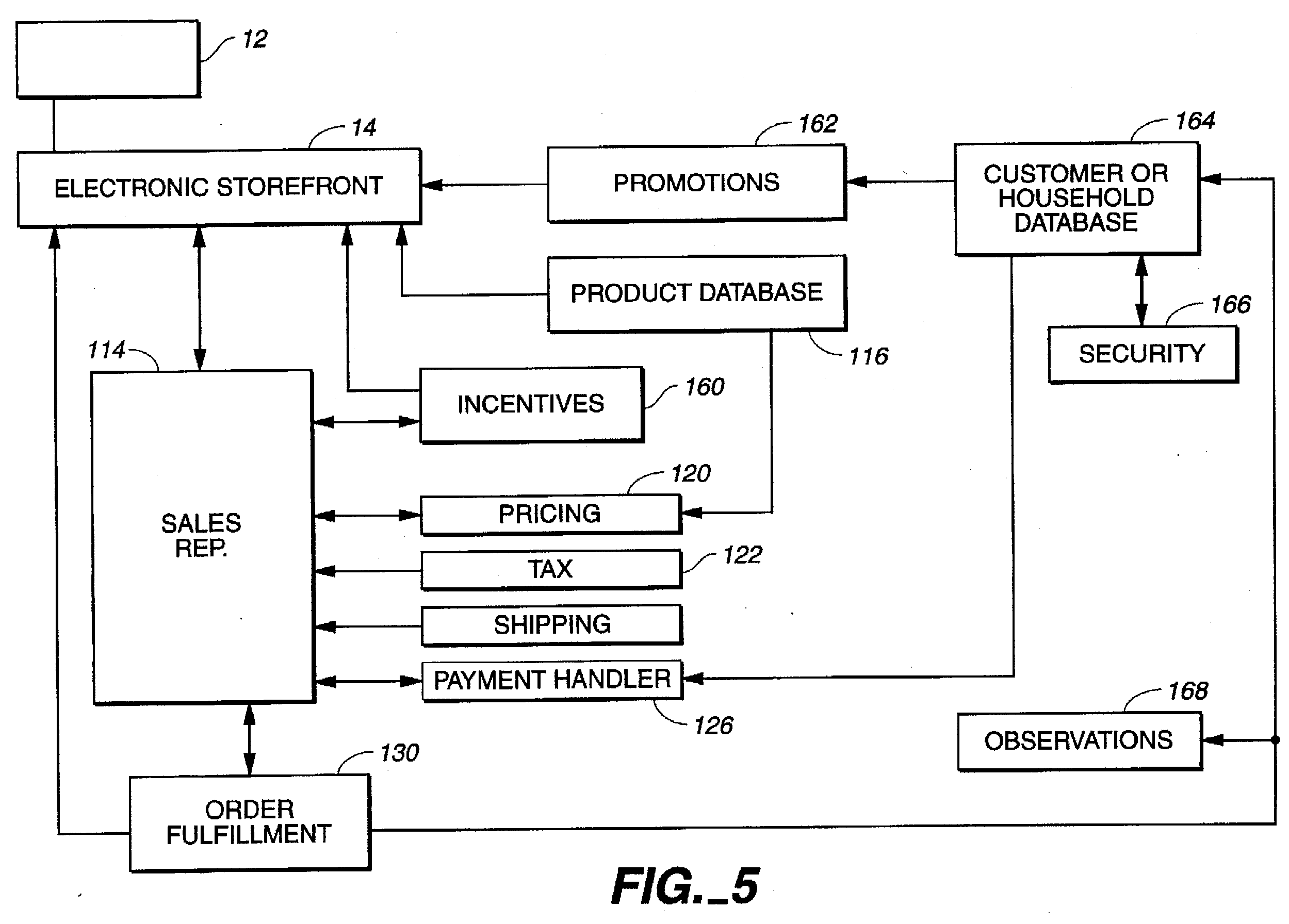
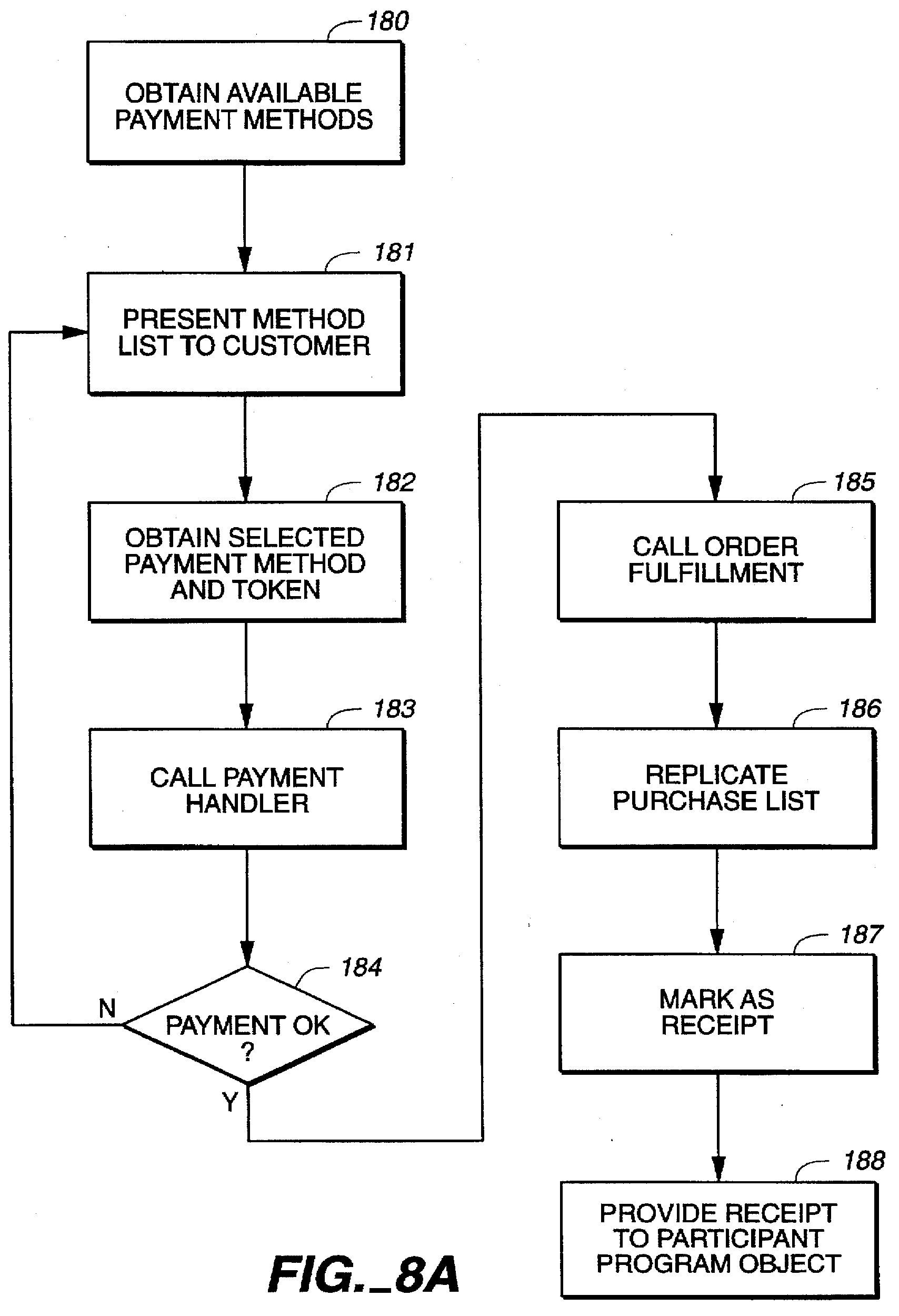
I read that 5,710,887 is one action. Nevertheless claim 9 reads:
"The system of claim 2, further comprising a payment validation system including:
- means for causing the customer monitoring object to receive the information related to the forms of payment available to
the customer and to present the customer with a selection of the forms of payment;
- means for receiving a first security code, related to a selected form of payment, from the customer; and
- means for validating the first security code by comparison to a second security code available to the customer monitoring
object;
- whereby payment for the item is initiated if the first security code is validated.
The same construction is repeated with claim 33 v. claim 27.
To show that 5,710,887 anticipate 1-click we use claims 1, 2, 4, 6 and 18. None of these claims depend on claim 9.
The description is unconclusive. It shows in "Obtaining Payment Alternatives/Selection of Payment Method" that the Participant
Program Object returns a list of predefined payment methods with associated challenges, that the user may have to select a
preferred payment method and then to meet the corresponding challenge (perhaps enter a password).
5,710,887 refers to three patents:
- 5,347,632 entitled "Reception system for
an interactive computer network and method of operation" filed by Prodigy on July 28,
1989 and whose priority date is July 15, 1988;
- 5,442,771 entitled "Method for storing data
in an interactive computer network" filed Prodigy on November 26, 1993, the priority date
of some parts being July 15, 1988;
- 5,455,903 entitled "Object oriented customer
information exchange system and method" filed on May 31, 1991.
5,710,887 is referenced by 324 patents, including:
- 6,282,522 entitled "Internet payment system
using smart card" and filed by VISA international on October 16, 1997 but whose priority date is April 30, 1997 (provisional
application);
- 6,249,772 entitled "Systems and methods
wherein a buyer purchases a product at a first price and acquires the product from a merchant that offers the product for
sale at a second price" filed on July 8, 1997 [this was later popularized as conditional purchase order by Priceline - this
is a kind of reverse auction;]
- 6,058,373 entitled "System and method for
processing electronic order forms" filed by Microsoft on October 16, 1996;
- 5,982,445 entitled "Hypertext markup
language protocol for television display and control" filed by October 21, 1996;
- 5,963,915 entitled "Secure, convenient
and efficient system and method of performing trans-internet purchase transactions" filed by InfoSeek on February 21, 1996;
- 5,905,973 entitled "Shopping basket
presentation method for an online shopping system" filed by Hitachi on September 29, 1997 but whose priority date is
September 30, 1996;
- 5,903,878 entitled "Method and apparatus
for electronic commerce" filed on August 20, 1997;
- 5,826,242 from Netscape and described below.
5,878,141 is entitled "Computerized purchasing
system and method for mediating purchase transactions over an interactive network" and was filed on August 25, 1995 by
Microsoft. I dentified this patent.
I analyze the delta in the 1-click analysis.
| Limitation |
5,878,141 |
| under control of a client system (1) | "Purchasing
system 10 also has multiple purchasing terminals 18-23 located remotely from transaction processing unit 12. Purchasing
terminals 18-23 are illustrated as many different types of electronic devices, including a point-of-purchase register 18, a
personal computer 19, a telephone 20, a stand-alone machine 21 (e.g., an ATM), a television and set-top box unit 22, and a
magnetic-stripe credit card reader 23 (e.g., a Verifone reader). Each purchasing terminal has an input device which can receive
a purchase request from a purchaser to buy goods and/or services from a merchant. The input device can be in the form of a
keypad (as in the case of the register 18, telephone 20, stand-alone machine 21, and card reader 23) or a keyboard or mouse (as
in the case of computer 19), or a remote control device (as in the case of a remote for the TV and set-top box unit 22). These
illustrated purchase terminals are only a representative sample, as many other electronic devices can be used to make purchases
in the computerized purchasing system of this invention." |
| displaying information identifying the item (2) |
see FIG. 5 |
| in response to only a single action being performed (3) | See Buy button on FIG. 5. "A cancel button 112 and a buy button 114 enable the subscriber to accept or deny the
transaction before any money exchanges hands." Regarding the selection of the payment method:
"FIG. 5 is but one example arrangement of information that can be presented to the subscriber, and many other arrangements
with more or less information can be used." So there can be less information and "[the user interface] includes a spin dial 110
which presents the available payment methods in a sequential order, and if desired, in a prearranged order according to the
subscriber's preferences." So Microsoft teaches that the preferred payment method can be displayed first. This is the default:
"The subscriber selects the default payment method, or cycles through any alternative choices, to inform the purchasing
system of a desired payment method." |
| sending a request to order the item [...] to a server system (4) | "an interactive communication network which interfaces the remotely located purchasing terminals with the centrally
located transaction processing unit, the communication network transferring the purchase request from one of the purchasing
terminals to the transaction processing unit" [claim 6] |
| the request including the identifier so that the server system can locate additional
information needed to complete the order and so that the server system can fulfill the generated order to complete purchase of
the item (5) | "If the purchaser confirms the purchase transaction, the processing unit
attaches an unforgeable digital signature on behalf of the purchaser to authorize the purchase and to validate for the merchant
that a sale has been consummated. The digital signatures are produced using signing tools, such as cryptographic signing keys,
which are unique to corresponding purchasers and are stored in the purchaser database. A password entered by the purchaser
authorizes the processing unit to use his/her associated signing tool kept in the purchaser database. This digital signature
assures the merchant that a legally enforceable purchase transaction has occurred."
The digital signature is unique to corresponding purchaser. It is an identifier of a purchaser. |
| a data storage medium storing information for a plurality of users (7) |
a purchaser database provided at the transaction processing unit, the purchaser database
having a list of purchasers and sets of personal payment methods for corresponding ones of the purchasers, whereby an
individual purchaser could use any one of the personal payment methods in that purchaser's corresponding set to purchase the
goods and/or services;" [claim 6] |
| a receiving component for receiving requests to order an item [...], the request being
sent in response to only a single action being performed (8) | "an interactive
communication network which interfaces the remotely located purchasing terminals with the centrally located transaction
processing unit, the communication network transferring the purchase request from one of the purchasing terminals to the
transaction processing unit" [claim 6] |
| a request including an indication of one of the plurality of users (9) |
digital signature as exposed for limitation 5 |
| an order placement component that retrieves from the data storage medium information
for the indicated user (10) | "the consummated purchase transaction is forwarded from
purchase mediator 84 to transaction routing system." "The transaction routing system selects a subscriber account." |
| uses the retrieved information to place an order for the indicated user for the item
(11) | "[The transaction routing system] authorizes a withdrawal from the subscriber
account, and authorizes a corresponding deposit in the merchant account" |
| fulfilling the generated order to complete purchase of the item whereby the item is
ordered without using a shopping cart ordering model (12) | The system can be used
"for purchase of the goods and/or services" [abstract]. Fulfilling the order is inherent to purchasing. |
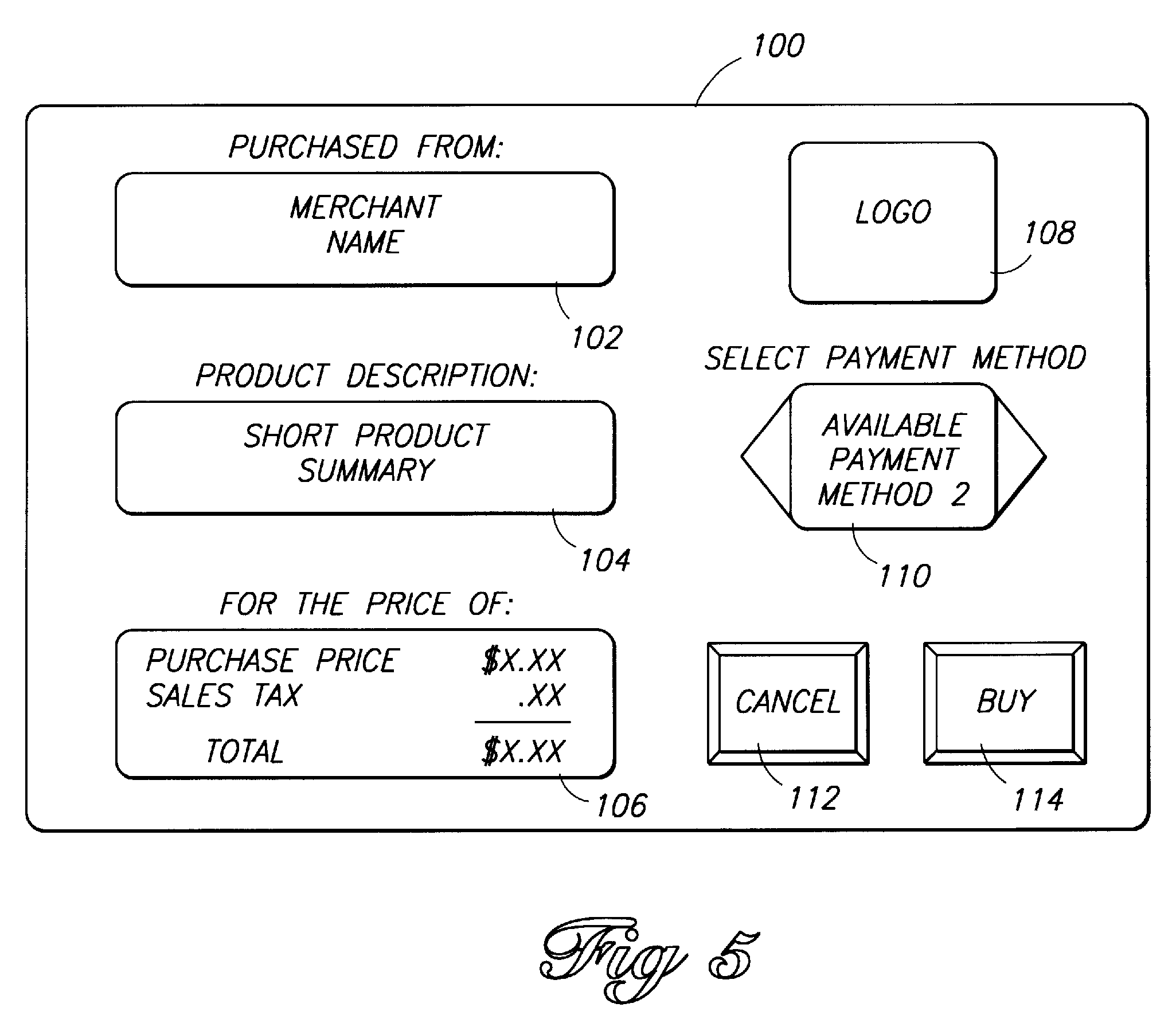 5,878,141 refers to 20 patents:
5,878,141 refers to 20 patents:
- 3,852,571 entitled "System of transferral of
funds" filed on August 16, 1972;
- 4,528,643 entitled "System for reproducing
information in material objects at a point of sale location" filed on January 10, 1983;
- 4,594,663 entitled "Credit transaction
processing system" filed by Omron on July 8, 1983, the priority date being July 09, 1982;
- 4,823,264 entitled "Electronic funds
transfer system" filed on May 27, 1986;
- 4,960,981 entitled "Method of and system for
electronic funds transfer via facsimile machines" filed on January 17, 1989;
- 5,053,956 entitled "Interactive system for
retail transactions" filed on April 25, 1989 and whose priority date is June 17, 1985;
- 5,283,731 entitled "Computer-based
classified ad system and method" filed on December 23, 1992;
- 5,319,705 entitled "Method and system for
multimedia access control enablement" filed by IBM on October 21, 1992;
- 5,336,870 entitled "System for remote
purchase payment transactions and remote bill payments" filed on May 26, 1992;
- 5,383,113 entitled "System and method for
electronically providing customer services including payment of bills, financial analysis and loans" filed on July 25, 1991;
- 5,404,393 entitled "Method and apparatus for
interactive television through use of menu windows" filed on September 28, 1992, the priority date of some parts being
October 3, 1991;
- 5,426,281 entitled "Transaction protection
system" filed on October 29, 1993 and whose priority date is Aug. 22, 1991;
- 5,475,585 entitled "Transactional processing
system" filed on February 2, 1994 and whose priority date is Oct. 1, 1990;
- 5,479,510 entitled "Automated data card
payment verification method" filed on November 15, 1994;
- 5,590,197 entitled "Electronic payment
system and method" filed on April 4, 1995;
- 5,592,375 entitled "Computer-assisted system
for interactively brokering goods or services between buyers and sellers" filed on March 11, 1994;
- 5,606,361 entitled "Videophone interactive
mailbox facility system and method of processing information" filed on May 10, 1995;
- 5,619,558 entitled "ATM segment of one
marketing method" filed by NCR on November 13, 1995;
- 5,661,517 entitled "Interactive intelligent
video information system" filed on April 8, 1996 and whose priority date is May 2, 1994;
- 5,677,955 entitled "Electronic funds
transfer instruments" filed on April 7, 1995.
5,878,141 is referenced by 45 patents, including:
- 6,055,560 entitled "System and method to
provide interactivity for a networked video server" filed by IBM on November 8, 1996 and whose priority date is Nov. 6, 1996;
5,812,668 is entitled "System, method and
article of manufacture for verifying the operation of a remote transaction clearance system utilizing a multichannel,
extensible, flexible architecture." It was filed by Verifone on June 17, 1996.
This patent does not teach every limitation of 1-click because it teaches consumer and merchants tasks relating to the
patentee role, which is to provide support tools for payment gateways as depicted on FIG. 1C.
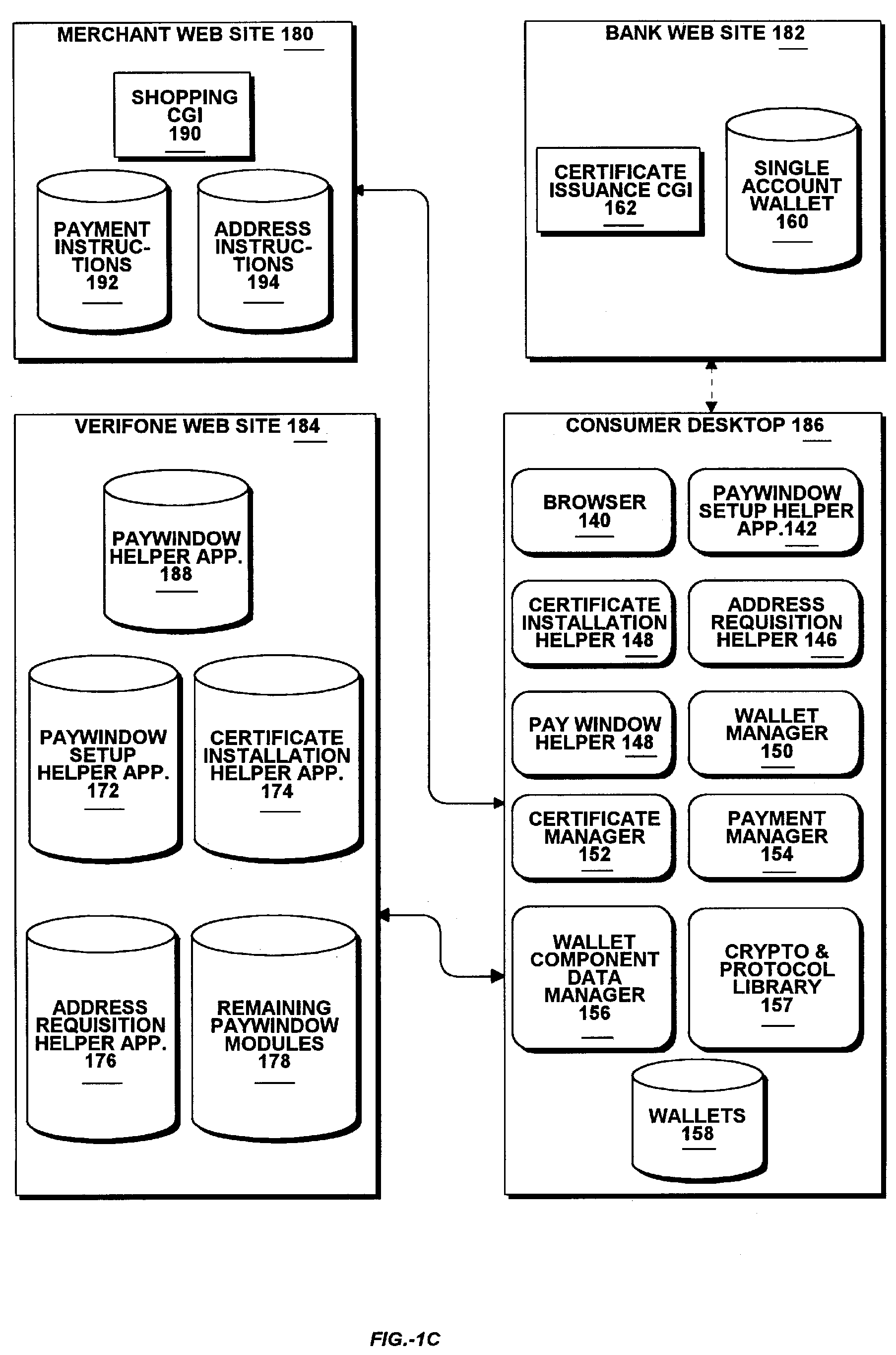
| Limitation |
5,812,668 |
| under control of a client system (1) | "Customer
computer system 120 is in communication with merchant computer system 130" on FIG. 1B |
| displaying information identifying the item (2) |
"Processing commences at 3500 where the program initializes the connection between the cardholder and the merchant for the
purposes of shopping." "In a preferred embodiment, a holder of a payment instrument (cardholder) surfs the web (Internet) for
required items. This is typically accomplished by using a browser to view on-line catalog information on the merchant's World
Wide Web page." "This method allows a cardholder to select the items to be purchased either automatically or manually." "The
order form is delivered electronically from the merchant's server or created on the cardholder's computer by electronic
shopping software." |
| in response to only a single action being performed (3) | The preferred method consists in using certificates. When the she queries a certificate the user provides
shipment (address) and payment data as depicted on FIG. 29. The user may also use a wallet. In both cases the user must
provide a private key password (other pieces of prior art teach the use of biometric for that purpose. Note that the user
presumably needs to move her finger for fingerprint checking whereas in case of iris checking no action is required.)
5,812,668 teaches using private key password as depicted on FIG. 31. This step could be skipped with biometric. Then this is
one action as depicted on Fig. 34. |
| sending a request to order the item [...] to a server system (4) | See FIG. 28 and corresponding explanations. |
| the request including the identifier so that the server system can locate additional
information needed to complete the order and so that the server system can fulfill the generated order to complete purchase
of the item (5) | See FIG. 28 and corresponding explanations. The GSO contains the order
and a payment identifier. It also contains in some embodiments a Terminal identifier. From "This method allows a cardholder
to select the items to be purchased either automatically or manually. Then, the cardholder is presented with an order form
containing the list of items, their prices, and totals. The totals could include shipping, handling and taxes for example."
we deduce that the identifier may allow retrieving shipping data (a default shipping address being included in the
certificate.) |
| a shopping cart ordering component and a single-action ordering component (6) |
"control passes immediately to the WWW server 1820 for the transaction to be appropriately
formatted and the appropriate interface page presented, whether the transaction is a store front 1822, shopping cart 1824,
pay page 1826, standard terminal administration 1828-1830 transaction, or an extended terminal transaction 1834" |
| a receiving component for receiving requests to order an item [...], the request being
sent in response to only a single action being performed (8) | See explanation above.
| | a request including an indication of one of the plurality of users (9) |
Certificate. See explanations above. |
| uses the retrieved information to place an order for the indicated user for the item
(12) | The field of the invention reads "The present invention relates to the secure,
electronic payment in exchange for goods and services purchased over a communication network, and more specifically, to a
system, method and article of manufacture for securely transmitting payment information from a customer to a merchant to a
payment gateway and returning a certification, including a credit confidence factor." |
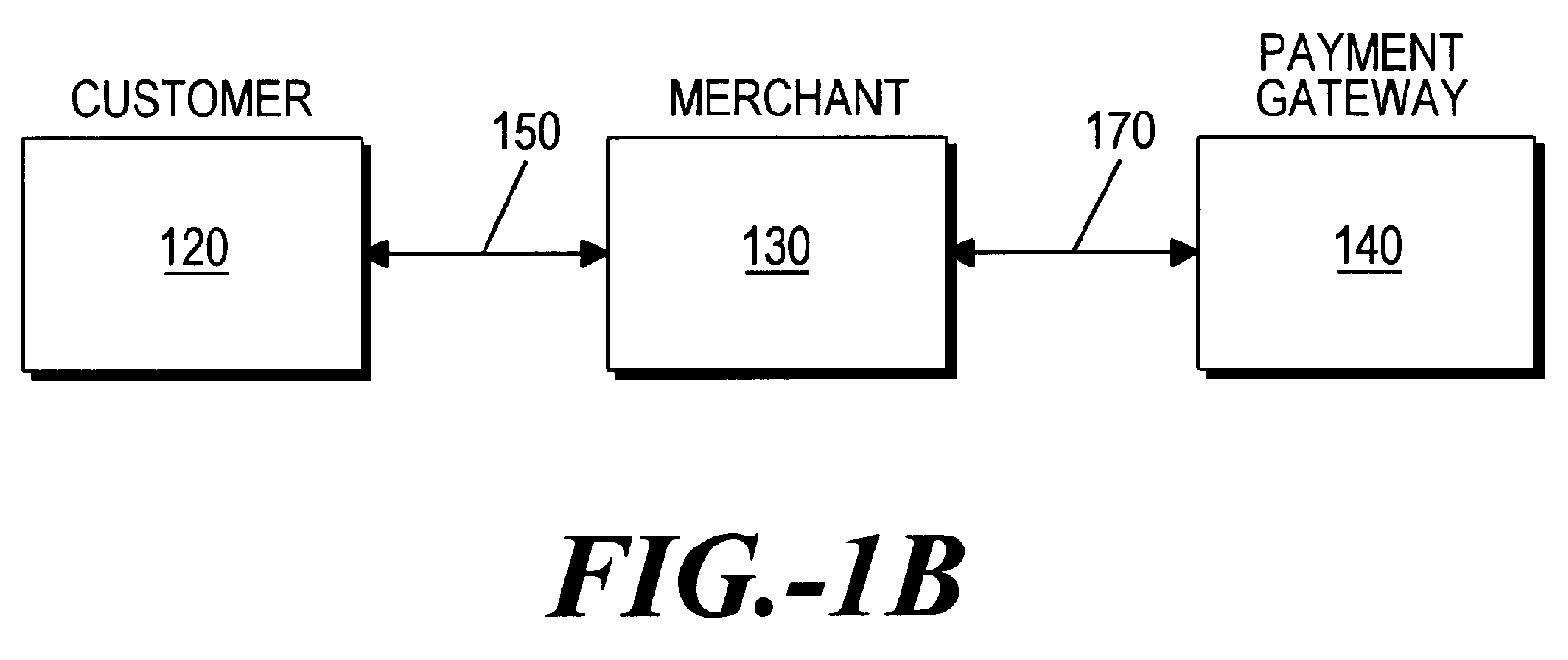
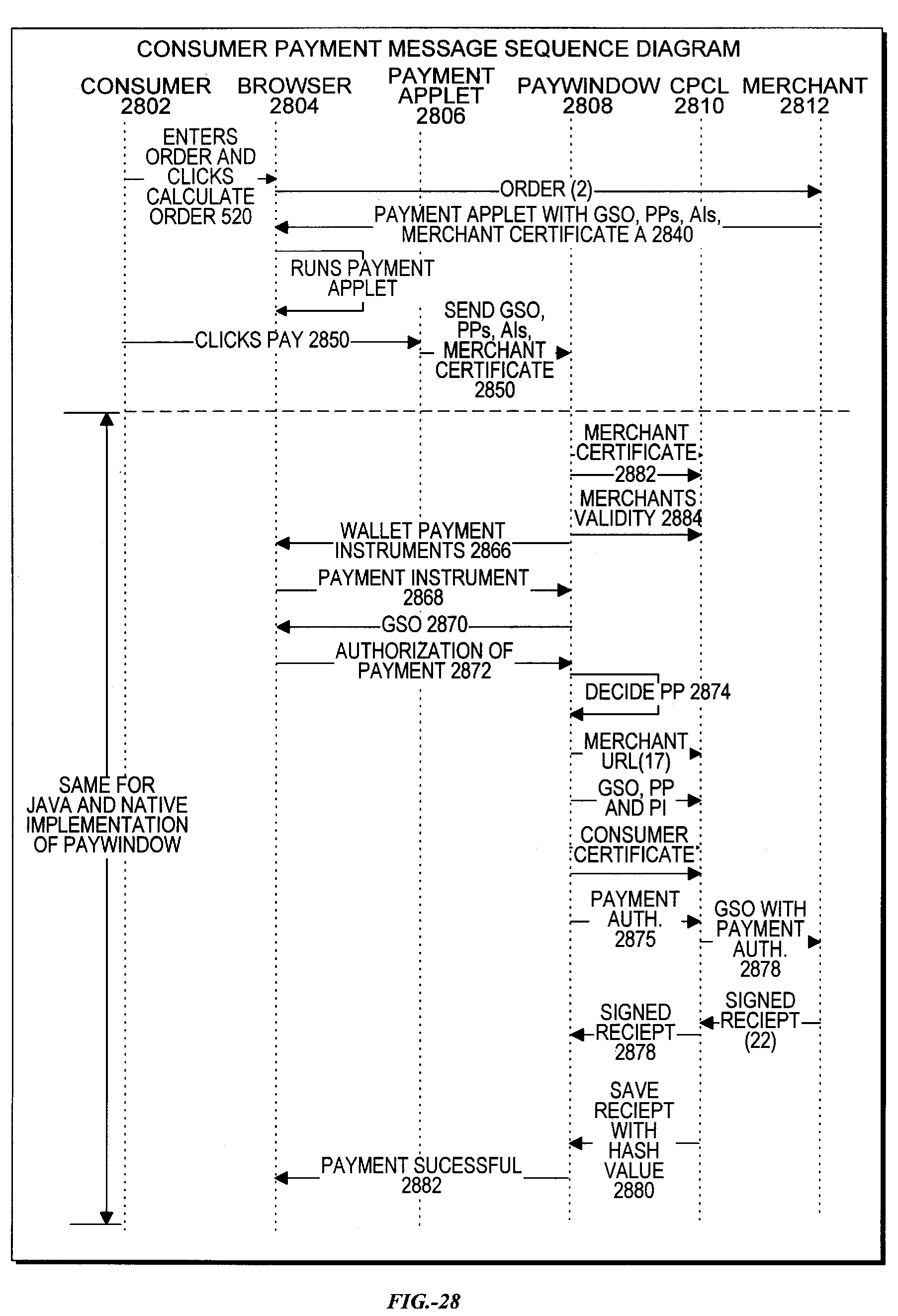
- The merchant certificate is evidence of ther merchant identity.
- GSO stands for good/service order.
- The Consumer Payments Class Library (CPCL) 2770 is a library that encapsulates the payment protocols to provide a single
API. The PayWindow application, the browser and the CPCL run on the consumer computer as shown on FIG. 1C.
So two things happen on the network, the applet download and the GSO with payment authorization.
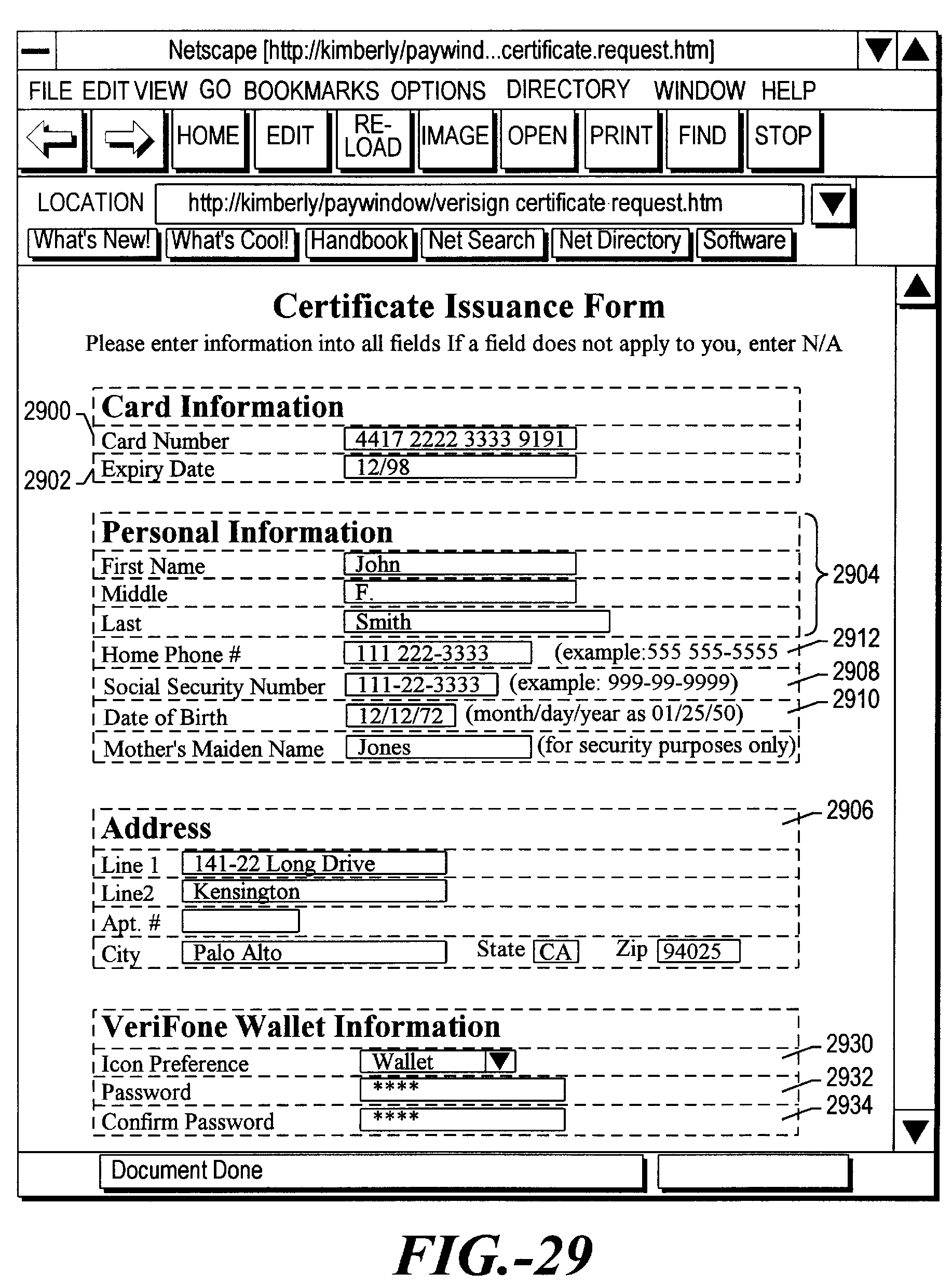
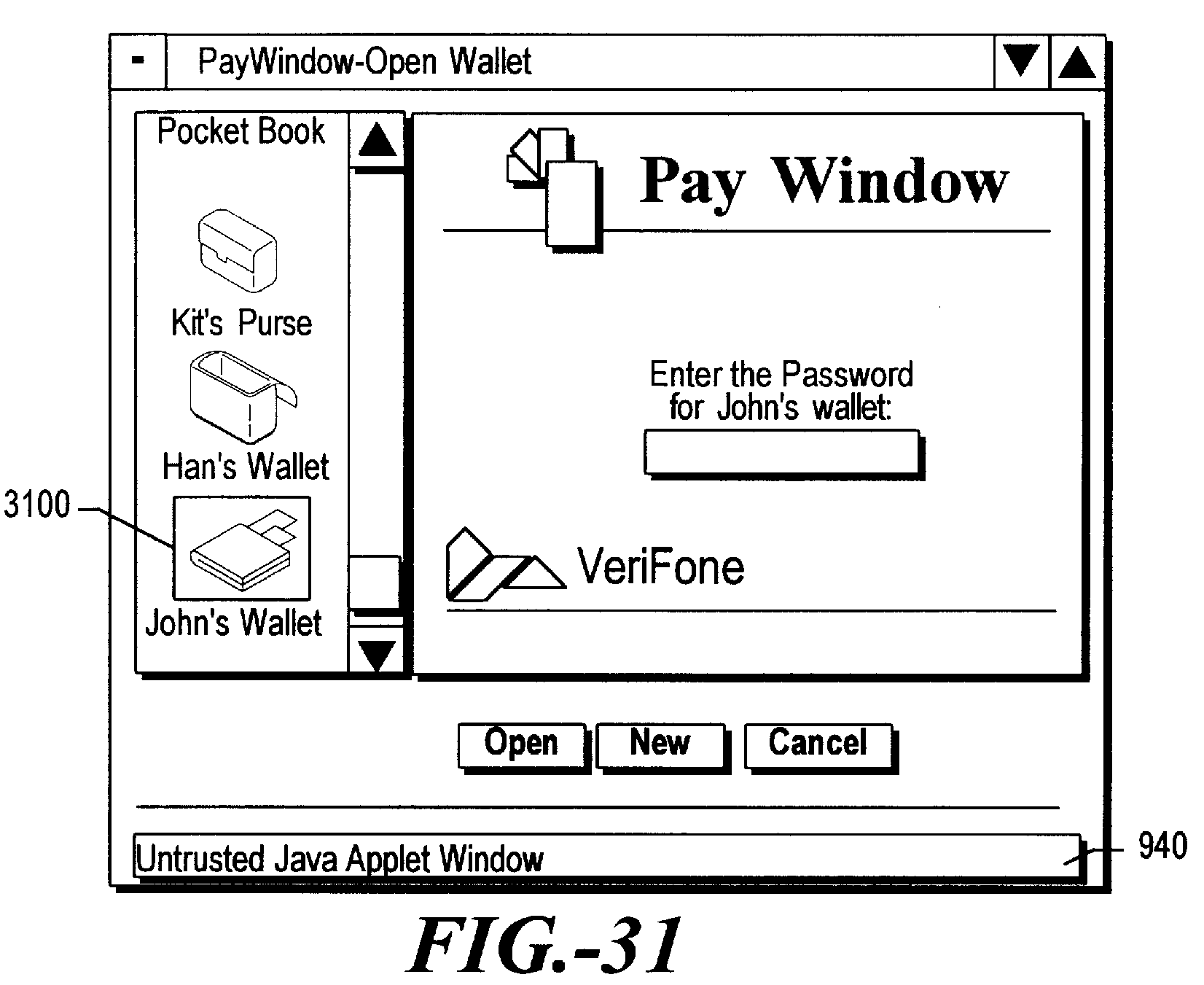
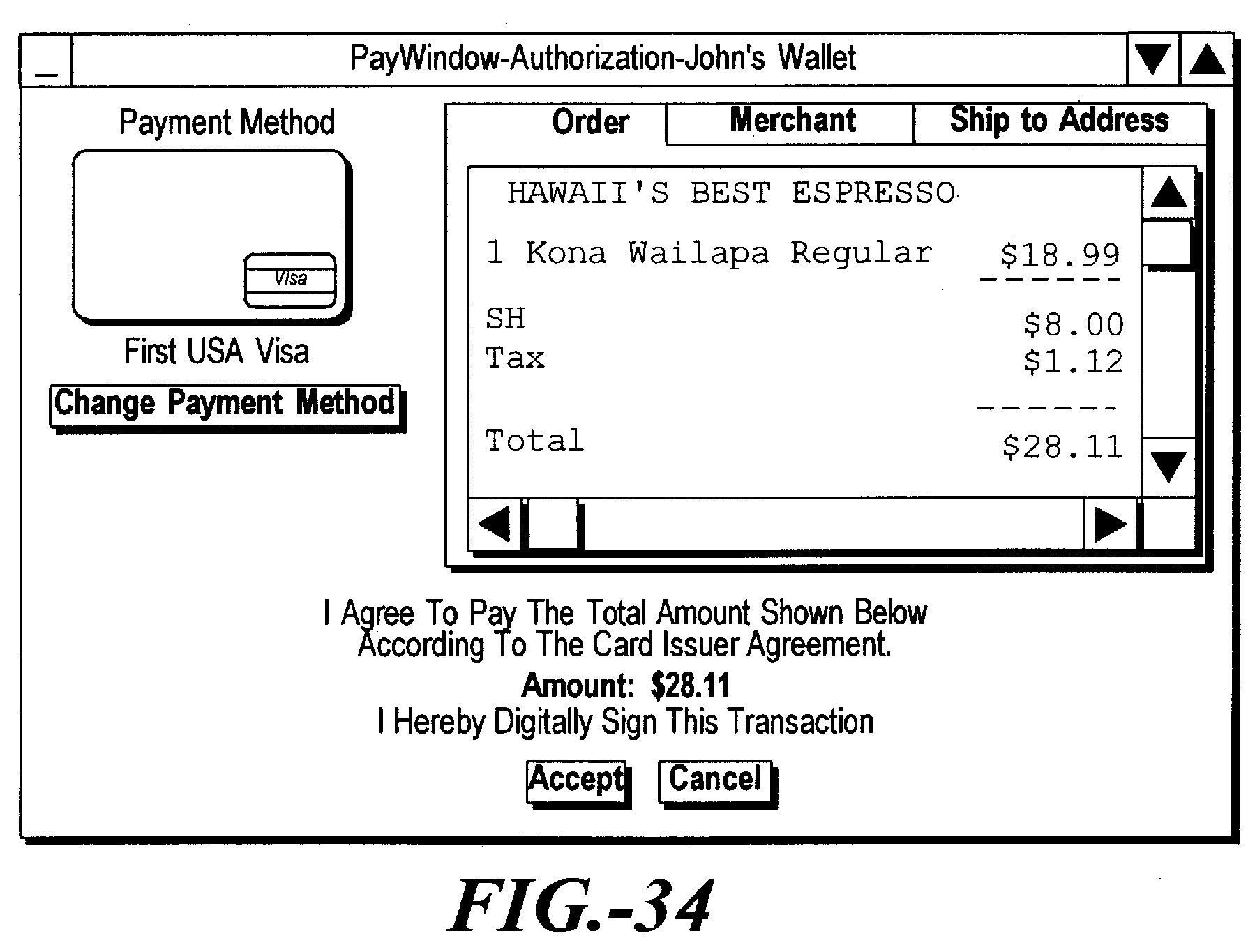 5,812,668 refers to 41 patents:
5,812,668 refers to 41 patents:
- 3,956,615 entitled "Transaction execution
system with secure data storage and communications" filed by IBM on June 25, 1974;
- 4,277,837 entitled "Personal portable terminal
for financial transactions" filed by IBM on February 11, 1980;
- 4,303,904 entitled "Universally applicable,
in-motion and automatic toll paying system using microwaves" filed on October 12, 1979;
- 4,454,414 entitled "Funds transfer system
using optically coupled, portable modules" filed on June 16, 1982;
- 4,578,530 entitled "End-to-end encryption
system and method of operation" filed on December 7, 1983, the priority date of some parts being June 24, 1981;
- 4,614,861 entitled "Unitary, self-contained
card verification and validation system and method" filed on November 15, 1984;
- 4,630,201 entitled "On-line and off-line
transaction security system using a code generated from a transaction parameter and a random number" filed on February 14,
1984;
- 4,689,478 entitled "System for handling
transactions including a portable personal terminal" filed by NCR on December 24, 1984;
- 4,766,293 entitled "Portable financial
transaction card capable of authorizing a transaction in foreign currencies" filed by VISA on June 26, 1986;
- 4,859,837 entitled "Portable data carrier
incorporating manually presettable processing modes" filed on September 15, 1988 and whose priority date is July 6, 1982;
- 4,877,950 entitled "Electronic purse-device"
filed on August 23, 1982;
- 4,906,828 entitled "Electronic money purse
and fund transfer system" filed on May 31, 1988 and whose priority date is Feb. 28, 1983;
- 4,935,962 entitled "Method and system for
authentication" filed by NCR on June 12, 1989 and whose priority date is May 19, 1988;
- 4,961,142 entitled "Multi-issuer transaction
device with individual identification verification plug-in application modules for each issuer" filed by MasterCard on June
29, 1988;
- 4,962,531 entitled "Transaction system
comprising one or more host exchanges and a number of distributed terminal stations" filed by Philips on August 26, 1988 and
whose priority date is August 28, 1987;
- 4,968,873 entitled "Smart card issuing and
receiving apparatus" filed on February 27, 1989 and whose priority date is September 8, 1987;
- 4,992,646 entitled "Transaction system of
the electronic purse type" filed on May 10, 1989 and whose priority date is May 30, 1988;
- 5,016,274 entitled "On-line/off-line digital
signing" filed on November 8, 1988;
- 5,030,806 entitled "Transaction system of
the electronic purse type" filed on October 31, 1990 and whose priority date is May 30, 1988;
- 5,175,416 entitled "Funds transfer system"
filed on May 17, 1991;
- 5,221,838 entitled "Electronic wallet" filed
by Motorola on October 20, 1992 and whose priority date is December 24, 1990;
- 5,420,405 entitled "Secure, automated
transaction system that supports an electronic currency operating in mixed debit & credit modes" filed on February 26, 1993;
- 5,440,634 entitled "Value transfer system"
filed on August 16, 1993 and whose priority date is October 16, 1991;
- 5,448,045 entitled "System for protecting
computers via intelligent tokens or smart cards" filed on February 26, 1993, the priority date of some parts being Feb. 26,
1992;
- 5,452,352 entitled "Automatic dialing system"
filed on August 13, 1992 and whose priority date is 20 Mar. 1990;
- 5,453,601 entitled "Electronic-monetary
system" filed by Citybank on November 15, 1991;
- 5,455,407 entitled "Electronic-monetary
system" filed by Citybank on January 27, 1995 and whose priority date is Nov. 15, 1991;
- 5,459,304 entitled "Smart card techniques
for motor vehicle record administration" filed by ATT on September 13, 1994;
- 5,465,291 entitled "Apparatus for ordering
from remote locations" filed on January 6, 1995 and whose priority date is Apr. 16, 1991;
- 5,476,259 entitled "Pari-mutuel electronic
and live table gaming" filed on November 12, 1993, the priority date of some parts being June 11, 1992;
- 5,478,993 entitled "Process as safety
concept against unauthorized use of a payment instrument in cashless payment at payment sites" filed by Ascom on January 18,
1994 and whose priority date is January 18, 1993;
- 5,485,510 entitled "Secure credit/debit card
authorization" filed by ATT on September 1, 1994 and whose priority date is September 29, 1992;
- 5,577,197 entitled "Test system for testing
electronic transaction processing services at a common carrier network switch" filed on October 29, 1992;
- 5,696,909 entitled "Virtual POS terminal"
filed on January 27, 1995;
- EP0172670 entitled "An apparatus for
effecting and recording monetary transactions" filed on July 27, 1984;
- EP0256768 entitled "Transaction
processing apparatus" filed on August 5, 1986;
- EP0363122 aka
5,097,115 entitled "Transaction authentication
system" filed on October 3, 1988;
- EP0256768 aka
4,877,947 entitled "Transaction processing
apparatus" filed on August 5, 1986;
- EP0363122 aka
5,097,115 entitled "Transaction authentication
system" filed on October 3, 1988;
- WO9116691 entitled "VALUE TRANSFER
SYSTEM" filed on April 12, 1990;
- WO9308545 aka
5,440,634 entitled "VALUE TRANSFER
SYSTEM" filed on October 16, 1991.
5,812,668 is referenced by 51 patents including:
- 5,978,840 entitled "System, method and article
of manufacture for a payment gateway system architecture for processing encrypted payment transactions utilizing a multichannel,
extensible, flexible architecture" filed by Verifone on September 26, 1996.
5,850,446 is entitled "System, method and article of manufacture for virtual point of sale processing utilizing an extensible,
flexible architecture." It was filed by Verifone on June 17, 1996.
See the 5,812,668 discussion.
5,850,446 refers to 40 patents:
- 3,956,615 entitled "Transaction execution
system with secure data storage and communications" filed by IBM on June 25, 1974;
- 4,277,837 entitled "Personal portable terminal
for financial transactions" filed by IBM on February 11, 1980;
- 4,303,904 entitled "Universally applicable,
in-motion and automatic toll paying system using microwaves" filed on October 12, 1979;
- 4,454,414 entitled "Funds transfer system
using optically coupled, portable modules" filed on June 16, 1982;
- 4,614,861 entitled "Unitary, self-contained
card verification and validation system and method" filed on November 15, 1984;
- 4,630,201 entitled "On-line and off-line
transaction security system using a code generated from a transaction parameter and a random number" filed on February 14,
1984;
- 4,689,478 entitled "System for handling
transactions including a portable personal terminal" filed by NCR on December 24, 1984;
- 4,766,293 entitled "Portable financial
transaction card capable of authorizing a transaction in foreign currencies" filed by VISA on June 26, 1986;
- 4,859,837 entitled "Portable data carrier
incorporating manually presettable processing modes" filed on September 15, 1988 and whose priority date is July 6, 1982;
- 4,877,950 entitled "Electronic purse-device"
filed on August 23, 1982;
- 4,906,828 entitled "Electronic money purse
and fund transfer system" filed on May 31, 1988 and whose priority date is Feb. 28, 1983;
- 4,935,962 entitled "Method and system for
authentication" filed by NCR on June 12, 1989 and whose priority date is May 19, 1988;
- 4,968,873 entitled "Smart card issuing and
receiving apparatus" filed on February 27, 1989 and whose priority date is September 8, 1987;
- 4,992,646 entitled "Transaction system of
the electronic purse type" filed on May 10, 1989 and whose priority date is May 30, 1988;
- 5,016,274 entitled "On-line/off-line digital
signing" filed on November 8, 1988;
- 5,030,806 entitled "Transaction system of
the electronic purse type" filed on October 31, 1990 and whose priority date is May 30, 1988;
- 5,175,416 entitled "Funds transfer system"
filed on May 17, 1991;
- 5,221,838 entitled "Electronic wallet" filed
by Motorola on October 20, 1992 and whose priority date is December 24, 1990;
- 5,420,405 entitled "Secure, automated
transaction system that supports an electronic currency operating in mixed debit & credit modes" filed on February 26, 1993;
- 5,440,634 entitled "Value transfer system"
filed on August 16, 1993 and whose priority date is October 16, 1991;
- 5,448,045 entitled "System for protecting
computers via intelligent tokens or smart cards" filed on February 26, 1993, the priority date of some parts being Feb. 26,
1992;
- 5,452,352 entitled "Automatic dialing system"
filed on August 13, 1992 and whose priority date is 20 Mar. 1990;
- 5,453,601 entitled "Electronic-monetary
system" filed by Citybank on November 15, 1991;
- 5,455,407 entitled "Electronic-monetary
system" filed by Citybank on January 27, 1995 and whose priority date is Nov. 15, 1991;
- 5,459,304 entitled "Smart card techniques
for motor vehicle record administration" filed by ATT on September 13, 1994;
- 5,465,291 entitled "Apparatus for ordering
from remote locations" filed on January 6, 1995 and whose priority date is Apr. 16, 1991;
- 5,476,259 entitled "Pari-mutuel electronic
and live table gaming" filed on November 12, 1993, the priority date of some parts being June 11, 1992;
- 5,478,993 entitled "Process as safety
concept against unauthorized use of a payment instrument in cashless payment at payment sites" filed by Ascom on January 18,
1994 and whose priority date is January 18, 1993;
- 5,485,510 entitled "Secure credit/debit card
authorization" filed by ATT on September 1, 1994 and whose priority date is September 29, 1992;
- 5,671,355 entitled "Reconfigurable network
interface apparatus and method" filed on September 13, 1996, the priority date of some parts being Jun. 26, 1992;
- 5,680,552 entitled :Gateway system for
interconnecting different data communication networks" filed by Lucent on September 20, 1994;
- 5,706,211 entitled "Message communications
system" filed by Motorola on March 2, 1995;
- 5,717,745 entitled "System and method of
efficiently evaluating different messages by a server in a telecommunications environment" filed on April 24, 1995;
- EP0172670 entitled "An apparatus for
effecting and recording monetary transactions" filed on July 27, 1984;
- EP0256768 entitled "Transaction
processing apparatus" filed on August 5, 1986;
- EP0363122 aka
5,097,115 entitled "Transaction authentication
system" filed on October 3, 1988;
- EP0256768 aka
4,877,947 entitled "Transaction processing
apparatus" filed on August 5, 1986;
- EP0363122 aka
5,097,115 entitled "Transaction authentication
system" filed on October 3, 1988;
- WO9116691 entitled "VALUE TRANSFER
SYSTEM" filed on April 12, 1990;
- WO9308545 aka
5,440,634 entitled "VALUE TRANSFER
SYSTEM" filed on October 16, 1991.
5,850,446 is referenced by 49 patents, including:
- 5,970,471 entitled "Virtual catalog and product
presentation method and apparatus" filed on March 22, 1996;
5,889,863 is entitled "System, method and article of manufacture for remote virtual point of sale processing utilizing a multichannel,
extensible, flexible architecture." It was filed by Verifone on June 17, 1996.
See the 5,812,668 discussion.
5,889,863 refers to 61 patents:
- 3,651,511 entitled "Traveling message
display" filed on December 2, 1969;
- 3,956,615 entitled "Transaction execution
system with secure data storage and communications" filed by IBM on June 25, 1974;
- 4,277,837 entitled "Personal portable terminal
for financial transactions" filed by IBM on February 11, 1980;
- 4,303,904 entitled "Universally applicable,
in-motion and automatic toll paying system using microwaves" filed on October 12, 1979;
- 4,454,414 entitled "Funds transfer system
using optically coupled, portable modules" filed on June 16, 1982;
- 4,614,861 entitled "Unitary, self-contained
card verification and validation system and method" filed on November 15, 1984;
- 4,630,201 entitled "On-line and off-line
transaction security system using a code generated from a transaction parameter and a random number" filed on February 14,
1984;
- 4,689,478 entitled "System for handling
transactions including a portable personal terminal" filed by NCR on December 24, 1984;
- 4,766,293 entitled "Portable financial
transaction card capable of authorizing a transaction in foreign currencies" filed by VISA on June 26, 1986;
- 4,799,156 entitled "Interactive market
management system" filed on October 1, 1986;
- 4,859,837 entitled "Portable data carrier
incorporating manually presettable processing modes" filed on September 15, 1988 and whose priority date is July 6, 1982;
- 4,877,950 entitled "Electronic purse-device"
filed on August 23, 1982;
- 4,906,828 entitled "Electronic money purse
and fund transfer system" filed on May 31, 1988 and whose priority date is Feb. 28, 1983;
- 4,935,962 entitled "Method and system for
authentication" filed by NCR on June 12, 1989 and whose priority date is May 19, 1988;
- 4,968,873 entitled "Smart card issuing and
receiving apparatus" filed on February 27, 1989 and whose priority date is September 8, 1987;
- 4,992,646 entitled "Transaction system of
the electronic purse type" filed on May 10, 1989 and whose priority date is May 30, 1988;
- 5,016,274 entitled "On-line/off-line digital
signing" filed on November 8, 1988;
- 5,030,806 entitled "Transaction system of
the electronic purse type" filed on October 31, 1990 and whose priority date is May 30, 1988;
- 5,175,416 entitled "Funds transfer system"
filed on May 17, 1991;
- 5,221,838 entitled "Electronic wallet" filed
by Motorola on October 20, 1992 and whose priority date is December 24, 1990;
- 5,283,819 entitled "Computing and multimedia
entertainment system" filed on April 25, 1991;
- 5,297,030 entitled "Method using bill and
coin images on a touch screen for processing payment for merchandise items" filed by NCR on April 8, 1992;
- 5,420,405 entitled "Secure, automated
transaction system that supports an electronic currency operating in mixed debit & credit modes" filed on February 26, 1993;
- 5,440,634 entitled "Value transfer system"
filed on August 16, 1993 and whose priority date is October 16, 1991;
- 5,442,791 entitled "Integrated remote
execution system for a heterogenous computer network environment" filed on May 12, 1994 and whose priority date is March 31,
1992;
- 5,448,045 entitled "System for protecting
computers via intelligent tokens or smart cards" filed on February 26, 1993, the priority date of some parts being Feb. 26,
1992;
- 5,452,352 entitled "Automatic dialing system"
filed on August 13, 1992 and whose priority date is 20 Mar. 1990;
- 5,453,601 entitled "Electronic-monetary
system" filed by Citybank on November 15, 1991;
- 5,455,407 entitled "Electronic-monetary
system" filed by Citybank on January 27, 1995 and whose priority date is Nov. 15, 1991;
- 5,459,304 entitled "Smart card techniques
for motor vehicle record administration" filed by ATT on September 13, 1994;
- 5,465,291 entitled "Apparatus for ordering
from remote locations" filed on January 6, 1995 and whose priority date is Apr. 16, 1991;
- 5,475,826 entitled "Method for protecting a
volatile file using a single hash" filed on November 19, 1993;
- 5,476,259 entitled "Pari-mutuel electronic
and live table gaming" filed on November 12, 1993, the priority date of some parts being June 11, 1992;
- 5,478,993 entitled "Process as safety
concept against unauthorized use of a payment instrument in cashless payment at payment sites" filed by Ascom on January 18,
1994 and whose priority date is January 18, 1993;
- 5,485,510 entitled "Secure credit/debit card
authorization" filed by ATT on September 1, 1994 and whose priority date is September 29, 1992;
- 5,506,832 entitled "Remote confidence
testing for computer-based conferencing system" filed by Intel on March 27, 1995, the priority date if some parts being
November 24, 1993;
- 5,557,518 entitled "Trusted agents for open
electronic commerce" filed by Citybank on April 28, 1994;
- 5,590,038 entitled "Universal electronic
transaction card including receipt storage and system and methods of conducting electronic transactions" filed on June 20,
1994;
- 5,590,197 entitled "Electronic payment
system and method" filed on April 4, 1995;
- 5,671,279 entitled "Electronic commerce
using a secure courier system" filed by Netscape on November 13, 1995;
- 5,671,280 entitled "System and method for
commercial payments using trusted agents" filed by Citybank on August 30, 1995;
- 5,677,955 entitled "Electronic funds
transfer instruments" filed on April 7, 1995;
- 5,715,314 entitled "Network sales system"
filed by OpenMarket on October 24, 1994;
- 5,729,594, the aforementioned Klingman patent;
- 5,742,845 entitled "System for extending
present open network communication protocols to communicate with non-standard I/O devices directly coupled to an open network"
filed on June 22, 1995;
- 5,754,772 entitled "Transaction service
independent HTTP server-to-transaction gateway" filed by Unisys on March 26, 1996;
- 5,793,966 entitled "Computer system and
computer-implemented process for creation and maintenance of online services" filed on December 1, 1995;
- EP0172670 entitled "An apparatus for
effecting and recording monetary transactions" filed on July 27, 1984;
- EP0256768 entitled "Transaction
processing apparatus" filed on August 5, 1986;
- EP0326699 aka
4,885,789 entitled "A remote trusted path mechanism for telnet"
filed by IBM on February 1, 1988;
- EP0363122 aka
5,097,115 entitled "Transaction authentication
system" filed on October 3, 1988;
- EP0416482 aka
5,315,634 entitled "Automatic trading method and apparatus"
filed by Hitachi on September 4, 1989;
- EP0527639 entitled "Home financial transaction system"
filed on August 14, 1991;
- EP0256768 aka
4,877,947 entitled "Transaction processing
apparatus" filed on August 5, 1986;
- EP0363122 aka
5,097,115 entitled "Transaction authentication
system" filed on October 3, 1988;
- EP0658862 aka
5,521,966 entitled "Method and system for mediating transactions
that use portable smart cards" filed by ATT on December 14, 1993;
- EP0666681 entitled "Computer and telephone apparatus
with user friendly computer interface and enhanced integrity features" filed on October 5, 1990;
- EP0668579 aka
5,461,217 entitled "Secure money transfer techniques using smart cards"
filed by ATT on February 8, 1994;
- GB2251098 entitled "Apparatus for processing data"
filed on December 17, 1990;
- WO9116691 entitled "VALUE TRANSFER
SYSTEM" filed on April 12, 1990;
- WO9308545 aka
5,440,634 entitled "VALUE TRANSFER
SYSTEM" filed on October 16, 1991.
5,889,863 is referenced by 46 patents.
5,943,424 is entitled "System, method and
article of manufacture for processing a plurality of transactions from a single initiation point on a multichannel,
extensible, flexible architecture." It is assigned to HP but the subject matter, the filing date (June 17, 1996), the title
are the same as on the Verifone patents above. Anyway HP
bought Verifone in 1997.
See the 5,812,668 discussion.
5,943,424 refers to 64 patents:
- 3,651,511 entitled "Traveling message
display" filed on December 2, 1969;
- 3,956,615 entitled "Transaction execution
system with secure data storage and communications" filed by IBM on June 25, 1974;
- 4,277,837 entitled "Personal portable terminal
for financial transactions" filed by IBM on February 11, 1980;
- 4,303,904 entitled "Universally applicable,
in-motion and automatic toll paying system using microwaves" filed on October 12, 1979;
- 4,454,414 entitled "Funds transfer system
using optically coupled, portable modules" filed on June 16, 1982;
- 4,614,861 entitled "Unitary, self-contained
card verification and validation system and method" filed on November 15, 1984;
- 4,630,201 entitled "On-line and off-line
transaction security system using a code generated from a transaction parameter and a random number" filed on February 14,
1984;
- 4,689,478 entitled "System for handling
transactions including a portable personal terminal" filed by NCR on December 24, 1984;
- 4,766,293 entitled "Portable financial
transaction card capable of authorizing a transaction in foreign currencies" filed by VISA on June 26, 1986;
- 4,799,156 entitled "Interactive market
management system" filed on October 1, 1986;
- 4,859,837 entitled "Portable data carrier
incorporating manually presettable processing modes" filed on September 15, 1988 and whose priority date is July 6, 1982;
- 4,877,950 entitled "Electronic purse-device"
filed on August 23, 1982;
- 4,906,828 entitled "Electronic money purse
and fund transfer system" filed on May 31, 1988 and whose priority date is Feb. 28, 1983;
- 4,935,962 entitled "Method and system for
authentication" filed by NCR on June 12, 1989 and whose priority date is May 19, 1988;
- 4,968,873 entitled "Smart card issuing and
receiving apparatus" filed on February 27, 1989 and whose priority date is September 8, 1987;
- 4,992,646 entitled "Transaction system of
the electronic purse type" filed on May 10, 1989 and whose priority date is May 30, 1988;
- 5,016,274 entitled "On-line/off-line digital
signing" filed on November 8, 1988;
- 5,030,806 entitled "Transaction system of
the electronic purse type" filed on October 31, 1990 and whose priority date is May 30, 1988;
- 5,138,712 entitled "Apparatus and method for
licensing software on a network of computers" filed by Sun on October 2, 1989;
- 5,175,416 entitled "Funds transfer system"
filed on May 17, 1991;
- 5,175,766 entitled "Signalling scheme for
controlling data encryption device in an electronic fund transaction processing system" filed on July 25, 1991 and whose
priority date is December 9, 1988;
- 5,221,838 entitled "Electronic wallet" filed
by Motorola on October 20, 1992 and whose priority date is December 24, 1990;
- 5,283,819 entitled "Computing and multimedia
entertainment system" filed on April 25, 1991;
- 5,297,030 entitled "Method using bill and
coin images on a touch screen for processing payment for merchandise items" filed by NCR on April 8, 1992;
- 5,420,405 entitled "Secure, automated
transaction system that supports an electronic currency operating in mixed debit & credit modes" filed on February 26, 1993;
- 5,440,634 entitled "Value transfer system"
filed on August 16, 1993 and whose priority date is October 16, 1991;
- 5,442,791 entitled "Integrated remote
execution system for a heterogenous computer network environment" filed on May 12, 1994 and whose priority date is March 31,
1992;
- 5,448,045 entitled "System for protecting
computers via intelligent tokens or smart cards" filed on February 26, 1993, the priority date of some parts being Feb. 26,
1992;
- 5,452,352 entitled "Automatic dialing system"
filed on August 13, 1992 and whose priority date is 20 Mar. 1990;
- 5,453,601 entitled "Electronic-monetary
system" filed by Citybank on November 15, 1991;
- 5,454,038 entitled "Electronic data
interchange postage evidencing system" filed by Pitney Bowes on December 6, 1993;
- 5,455,407 entitled "Electronic-monetary
system" filed by Citybank on January 27, 1995 and whose priority date is Nov. 15, 1991;
- 5,459,304 entitled "Smart card techniques
for motor vehicle record administration" filed by ATT on September 13, 1994;
- 5,465,291 entitled "Apparatus for ordering
from remote locations" filed on January 6, 1995 and whose priority date is Apr. 16, 1991;
- 5,475,826 entitled "Method for protecting a
volatile file using a single hash" filed on November 19, 1993;
- 5,476,259 entitled "Pari-mutuel electronic
and live table gaming" filed on November 12, 1993, the priority date of some parts being June 11, 1992;
- 5,478,993 entitled "Process as safety
concept against unauthorized use of a payment instrument in cashless payment at payment sites" filed by Ascom on January 18,
1994 and whose priority date is January 18, 1993;
- 5,485,510 entitled "Secure credit/debit card
authorization" filed by ATT on September 1, 1994 and whose priority date is September 29, 1992;
- 5,491,752 entitled "System for increasing
the difficulty of password guessing attacks in a distributed authentication scheme employing authentication tokens" filed by
Digital on September 2, 1994 and whose priority date is March 18, 1993;
- 5,506,832 entitled "Remote confidence
testing for computer-based conferencing system" filed by Intel on March 27, 1995, the priority date if some parts being
November 24, 1993;
- 5,557,518 entitled "Trusted agents for open
electronic commerce" filed by Citybank on April 28, 1994;
- 5,590,038 entitled "Universal electronic
transaction card including receipt storage and system and methods of conducting electronic transactions" filed on June 20,
1994;
- 5,590,197 entitled "Electronic payment
system and method" filed on April 4, 1995;
- 5,671,279 entitled "Electronic commerce
using a secure courier system" filed by Netscape on November 13, 1995;
- 5,671,280 entitled "System and method for
commercial payments using trusted agents" filed by Citybank on August 30, 1995;
- 5,677,955 entitled "Electronic funds
transfer instruments" filed on April 7, 1995;
- 5,682,429 entitled "Electronic data
interchange postage evidencing system" filed by Pitney Bowes on September 9, 1995 and whose priority date is December 6, 1993;
- 5,715,314 entitled "Network sales system"
filed by OpenMarket on October 24, 1994;
- 5,729,594, the aforementioned Klingman patent;
- 5,742,845 entitled "System for extending
present open network communication protocols to communicate with non-standard I/O devices directly coupled to an open network"
filed on June 22, 1995;
- 5,754,772 entitled "Transaction service
independent HTTP server-to-transaction gateway" filed by Unisys on March 26, 1996;
- 5,793,966 entitled "Computer system and
computer-implemented process for creation and maintenance of online services" filed on December 1, 1995;
- EP0172670 aka
4,877,947 entitled "An apparatus for
effecting and recording monetary transactions" filed on July 27, 1984;
- EP0256768 entitled "Transaction
processing apparatus" filed on August 5, 1986;
- EP0326699 aka
4,885,789 entitled "A remote trusted
path mechanism for telnet" filed by IBM on February 1, 1988;
- EP0363122 aka
5,097,115 entitled "Transaction authentication
system" filed by Fujitsu on October 3, 1988;
- EP0416482 aka
5,315,634 entitled "Automatic trading method and
apparatus" filed by Hitachi on September 4, 1989;
- EP0527639 entitled "Home financial
transaction system" filed on August 14, 1991;
- EP0658862 aka
5,521,966 entitled "Method and system for
mediating transactions that use portable smart cards" filed by ATT on December 14, 1993;
- EP0666681 entitled "Computer and
telephone apparatus with user friendly computer interface and enhanced integrity features" filed on October 5, 1990;
- EP0668579 aka
5,461,217 entitled "Secure money transfer
techniques using smart cards" filed by ATT on February 8, 1994;
- GB2251098 entitled "Apparatus for processing data"
filed on December 17, 1990;
- WO9116691 entitled "VALUE TRANSFER
SYSTEM" filed on April 12, 1990;
- WO9308545 aka
5,440,634 entitled "VALUE TRANSFER
SYSTEM" filed on October 16, 1991.
5,943,424 is referenced by nine patents.
5,983,208 is entitled "System, method and
article of manufacture for handling transaction results in a gateway payment architecture utilizing a multichannel,
extensible, flexible architecture". It was filed by Verifone on June 17, 1996.
See the 5,812,668 discussion.
5,983,208 refers to 49 patents:
- 4,859,837 entitled "Portable data carrier
incorporating manually presettable processing modes" filed on September 15, 1988 and whose priority date is July 6, 1982;
- 4,877,950 entitled "Electronic purse-device"
filed on August 23, 1982;
- 4,906,828 entitled "Electronic money purse
and fund transfer system" filed on May 31, 1988 and whose priority date is Feb. 28, 1983;
- 4,935,962 entitled "Method and system for
authentication" filed by NCR on June 12, 1989 and whose priority date is May 19, 1988;
- 4,968,873 entitled "Smart card issuing and
receiving apparatus" filed on February 27, 1989 and whose priority date is September 8, 1987;
- 4,992,646 entitled "Transaction system of
the electronic purse type" filed on May 10, 1989 and whose priority date is May 30, 1988;
- 5,016,274 entitled "On-line/off-line digital
signing" filed on November 8, 1988;
- 5,030,806 entitled "Transaction system of
the electronic purse type" filed on October 31, 1990 and whose priority date is May 30, 1988;
- 5,175,416 entitled "Funds transfer system"
filed on May 17, 1991;
- 5,221,838 entitled "Electronic wallet" filed
by Motorola on October 20, 1992 and whose priority date is December 24, 1990;
- 5,283,819 entitled "Computing and multimedia
entertainment system" filed on April 25, 1991;
- 5,297,030 entitled "Method using bill and
coin images on a touch screen for processing payment for merchandise items" filed by NCR on April 8, 1992;
- 5,420,405 entitled "Secure, automated
transaction system that supports an electronic currency operating in mixed debit & credit modes" filed on February 26, 1993;
- 5,440,634 entitled "Value transfer system"
filed on August 16, 1993 and whose priority date is October 16, 1991;
- 5,442,791 entitled "Integrated remote
execution system for a heterogenous computer network environment" filed on May 12, 1994 and whose priority date is March 31,
1992;
- 5,448,045 entitled "System for protecting
computers via intelligent tokens or smart cards" filed on February 26, 1993, the priority date of some parts being Feb. 26,
1992;
- 5,452,352 entitled "Automatic dialing system"
filed on August 13, 1992 and whose priority date is 20 Mar. 1990;
- 5,453,601 entitled "Electronic-monetary
system" filed by Citybank on November 15, 1991;
- 5,455,407 entitled "Electronic-monetary
system" filed by Citybank on January 27, 1995 and whose priority date is Nov. 15, 1991;
- 5,459,304 entitled "Smart card techniques
for motor vehicle record administration" filed by ATT on September 13, 1994;
- 5,465,291 entitled "Apparatus for ordering
from remote locations" filed on January 6, 1995 and whose priority date is Apr. 16, 1991;
- 5,475,826 entitled "Method for protecting a
volatile file using a single hash" filed on November 19, 1993;
- 5,476,259 entitled "Pari-mutuel electronic
and live table gaming" filed on November 12, 1993, the priority date of some parts being June 11, 1992;
- 5,478,993 entitled "Process as safety
concept against unauthorized use of a payment instrument in cashless payment at payment sites" filed by Ascom on January 18,
1994 and whose priority date is January 18, 1993;
- 5,485,510 entitled "Secure credit/debit card
authorization" filed by ATT on September 1, 1994 and whose priority date is September 29, 1992;
- 5,506,832 entitled "Remote confidence
testing for computer-based conferencing system" filed by Intel on March 27, 1995, the priority date if some parts being
November 24, 1993;
- 5,557,518 entitled "Trusted agents for open
electronic commerce" filed by Citybank on April 28, 1994;
- 5,590,038 entitled "Universal electronic
transaction card including receipt storage and system and methods of conducting electronic transactions" filed on June 20,
1994;
- 5,590,197 entitled "Electronic payment
system and method" filed on April 4, 1995;
- 5,671,279 entitled "Electronic commerce
using a secure courier system" filed by Netscape on November 13, 1995;
- 5,671,280 entitled "System and method for
commercial payments using trusted agents" filed by Citybank on August 30, 1995;
- 5,677,955 entitled "Electronic funds
transfer instruments" filed on April 7, 1995;
- 5,715,314 entitled "Network sales system"
filed by OpenMarket on October 24, 1994;
- 5,729,594, the aforementioned Klingman patent;
- 5,742,845 entitled "System for extending
present open network communication protocols to communicate with non-standard I/O devices directly coupled to an open network"
filed on June 22, 1995;
- 5,793,966 entitled "Computer system and
computer-implemented process for creation and maintenance of online services" filed on December 1, 1995;
- 5,812,668
- EP0172670 aka
4,877,947 entitled "An apparatus for
effecting and recording monetary transactions" filed on July 27, 1984;
- EP0256768 entitled "Transaction
processing apparatus" filed on August 5, 1986;
- EP0326699 aka
4,885,789 entitled "A remote trusted
path mechanism for telnet" filed by IBM on February 1, 1988;
- EP0363122 aka
5,097,115 entitled "Transaction authentication
system" filed by Fujitsu on October 3, 1988;
- EP0416482 aka
5,315,634 entitled "Automatic trading method and
apparatus" filed by Hitachi on September 4, 1989;
- EP0527639 entitled "Home financial
transaction system" filed on August 14, 1991;
- EP0658862 aka
5,521,966 entitled "Method and system for
mediating transactions that use portable smart cards" filed by ATT on December 14, 1993;
- EP0666681 entitled "Computer and
telephone apparatus with user friendly computer interface and enhanced integrity features" filed on October 5, 1990;
- EP0668579 aka
5,461,217 entitled "Secure money transfer
techniques using smart cards" filed by ATT on February 8, 1994;
- GB2251098 entitled "Apparatus for processing data"
filed on December 17, 1990;
- WO9116691 entitled "VALUE TRANSFER
SYSTEM" filed on April 12, 1990;
- WO9308545 aka
5,440,634 entitled "VALUE TRANSFER
SYSTEM" filed on October 16, 1991.
5,983,208 is referenced by nine patents.
5,987,132 is entitled "System, method and
article of manufacture for conditionally accepting a payment method utilizing an extensible, flexible architecture." It was
filed by Verifone on June 17, 1996.
See the 5,812,668 discussion.
5,987,132 refers to 63 patents:
- 3,651,511 entitled "Traveling message
display" filed on December 2, 1969;
- 3,956,615 entitled "Transaction execution
system with secure data storage and communications" filed by IBM on June 25, 1974;
- 4,277,837 entitled "Personal portable terminal
for financial transactions" filed by IBM on February 11, 1980;
- 4,303,904 entitled "Universally applicable,
in-motion and automatic toll paying system using microwaves" filed on October 12, 1979;
- 4,454,414 entitled "Funds transfer system
using optically coupled, portable modules" filed on June 16, 1982;
- 4,630,201 entitled "On-line and off-line
transaction security system using a code generated from a transaction parameter and a random number" filed on February 14,
1984;
- 4,689,478 entitled "System for handling
transactions including a portable personal terminal" filed by NCR on December 24, 1984;
- 4,766,293 entitled "Portable financial
transaction card capable of authorizing a transaction in foreign currencies" filed by VISA on June 26, 1986;
- 4,799,156 entitled "Interactive market
management system" filed on October 1, 1986;
- 4,859,837 entitled "Portable data carrier
incorporating manually presettable processing modes" filed on September 15, 1988 and whose priority date is July 6, 1982;
- 4,877,950 entitled "Electronic purse-device"
filed on August 23, 1982;
- 4,906,828 entitled "Electronic money purse
and fund transfer system" filed on May 31, 1988 and whose priority date is Feb. 28, 1983;
- 4,935,962 entitled "Method and system for
authentication" filed by NCR on June 12, 1989 and whose priority date is May 19, 1988;
- 4,968,873 entitled "Smart card issuing and
receiving apparatus" filed on February 27, 1989 and whose priority date is September 8, 1987;
- 4,992,646 entitled "Transaction system of
the electronic purse type" filed on May 10, 1989 and whose priority date is May 30, 1988;
- 5,016,274 entitled "On-line/off-line digital
signing" filed on November 8, 1988;
- 5,030,806 entitled "Transaction system of
the electronic purse type" filed on October 31, 1990 and whose priority date is May 30, 1988;
- 5,175,416 entitled "Funds transfer system"
filed on May 17, 1991;
- 5,221,838 entitled "Electronic wallet" filed
by Motorola on October 20, 1992 and whose priority date is December 24, 1990;
- 5,283,819 entitled "Computing and multimedia
entertainment system" filed on April 25, 1991;
- 5,297,030 entitled "Method using bill and
coin images on a touch screen for processing payment for merchandise items" filed by NCR on April 8, 1992;
- 5,420,405 entitled "Secure, automated
transaction system that supports an electronic currency operating in mixed debit & credit modes" filed on February 26, 1993;
- 5,440,634 entitled "Value transfer system"
filed on August 16, 1993 and whose priority date is October 16, 1991;
- 5,442,791 entitled "Integrated remote
execution system for a heterogenous computer network environment" filed on May 12, 1994 and whose priority date is March 31,
1992;
- 5,448,045 entitled "System for protecting
computers via intelligent tokens or smart cards" filed on February 26, 1993, the priority date of some parts being Feb. 26,
1992;
- 5,452,352 entitled "Automatic dialing system"
filed on August 13, 1992 and whose priority date is 20 Mar. 1990;
- 5,453,601 entitled "Electronic-monetary
system" filed by Citybank on November 15, 1991;
- 5,455,407 entitled "Electronic-monetary
system" filed by Citybank on January 27, 1995 and whose priority date is Nov. 15, 1991;
- 5,459,304 entitled "Smart card techniques
for motor vehicle record administration" filed by ATT on September 13, 1994;
- 5,465,291 entitled "Apparatus for ordering
from remote locations" filed on January 6, 1995 and whose priority date is Apr. 16, 1991;
- 5,475,826 entitled "Method for protecting a
volatile file using a single hash" filed on November 19, 1993;
- 5,476,259 entitled "Pari-mutuel electronic
and live table gaming" filed on November 12, 1993, the priority date of some parts being June 11, 1992;
- 5,478,993 entitled "Process as safety
concept against unauthorized use of a payment instrument in cashless payment at payment sites" filed by Ascom on January 18,
1994 and whose priority date is January 18, 1993;
- 5,485,510 entitled "Secure credit/debit card
authorization" filed by ATT on September 1, 1994 and whose priority date is September 29, 1992;
- 5,506,832 entitled "Remote confidence
testing for computer-based conferencing system" filed by Intel on March 27, 1995, the priority date if some parts being
November 24, 1993;
- 5,557,518 entitled "Trusted agents for open
electronic commerce" filed by Citybank on April 28, 1994;
- 5,590,038 entitled "Universal electronic
transaction card including receipt storage and system and methods of conducting electronic transactions" filed on June 20,
1994;
- 5,590,197 entitled "Electronic payment
system and method" filed on April 4, 1995;
- 5,671,279 entitled "Electronic commerce
using a secure courier system" filed by Netscape on November 13, 1995;
- 5,671,280 entitled "System and method for
commercial payments using trusted agents" filed by Citybank on August 30, 1995;
- 5,677,955 entitled "Electronic funds
transfer instruments" filed on April 7, 1995;
- 5,715,314 entitled "Network sales system"
filed by OpenMarket on October 24, 1994;
- 5,729,594, the aforementioned Klingman patent;
- 5,732,400 entitled "System and method for a
risk-based purchase of goods" filed by Citybank on January 4, 1995;
- 5,742,845 entitled "System for extending
present open network communication protocols to communicate with non-standard I/O devices directly coupled to an open network"
filed on June 22, 1995;
- 5,757,917 entitled "Computerized payment
system for purchasing goods and services on the internet" filed on November 1, 1995;
- 5,781,632 entitled "Method and apparatus for
secured transmission of confidential data over an unsecured network" filed on October 30, 1997 and whose priority date is
February 8, 1995;
- 5,793,966 entitled "Computer system and
computer-implemented process for creation and maintenance of online services" filed on December 1, 1995;
- 5,802,497 entitled "Method and apparatus for
conducting computerized commerce" filed by Digital on July 10, 1995;
- 5,809,144 entitled "Method and apparatus for
purchasing and delivering digital goods over a network" filed by Carnegie Mellon on August 24, 1995;
- 5,812,668
- EP0172670 aka
4,877,947 entitled "An apparatus for
effecting and recording monetary transactions" filed on July 27, 1984;
- EP0256768 entitled "Transaction
processing apparatus" filed on August 5, 1986;
- EP0326699 aka
4,885,789 entitled "A remote trusted
path mechanism for telnet" filed by IBM on February 1, 1988;
- EP0363122 aka
5,097,115 entitled "Transaction authentication
system" filed by Fujitsu on October 3, 1988;
- EP0416482 aka
5,315,634 entitled "Automatic trading method and
apparatus" filed by Hitachi on September 4, 1989;
- EP0527639 entitled "Home financial
transaction system" filed on August 14, 1991;
- EP0658862 aka
5,521,966 entitled "Method and system for
mediating transactions that use portable smart cards" filed by ATT on December 14, 1993;
- EP0666681 entitled "Computer and
telephone apparatus with user friendly computer interface and enhanced integrity features" filed on October 5, 1990;
- EP0668579 aka
5,461,217 entitled "Secure money transfer
techniques using smart cards" filed by ATT on February 8, 1994;
- GB2251098 entitled "Apparatus for processing data"
filed on December 17, 1990;
- WO9116691 entitled "VALUE TRANSFER
SYSTEM" filed on April 12, 1990;
- WO9308545 aka
5,440,634 entitled "VALUE TRANSFER
SYSTEM" filed on October 16, 1991.
5,987,132 is referenced by 15 patents.
5,890,137 is entitled "On-line shopping
system and the method of payment settlement." It was filed by Kabushiki Kaisha N.K. Kikaku on December 15, 1995 in Japan and
on July 26, 1996 in USA.
The abstract reads:
When performing on-line shopping using the Internet, and when performing payment settlement for a product by a credit card, user's card data
runs over the Internet, leaving the possibility of card data leakage, thereby causing a security problem. The user decides the product he or
she wants to buy via a computer network (Internet) from a user system. Then, a transmission unit calls up a service center to send order data
including the credit card data via a settlement network. Service center invoices the sales price to an approval center based on the order data.
Approval center pays the price to service center. Then, service center sends the order data to the shopping system. A delivery processing unit
then delivers the product to the user based on the order data."
| Limitation |
5,890,137 |
| under control of a client system (1) | "A
computerized payment settlement method which includes a store system including shopping malls, a user system that selects a
product to be purchased from the shopping malls..." [claim 13] |
| displaying information identifying the item (2) |
See FIG. 4. |
| in response to only a single action being performed (3) | No. FIG. 4 teaches a shopping cart (more than one product) and the checkout prompts for payment and shipment data
to be sent to the service center. 5,890,137 does not teach that personal data, and payment settlement data could be recorded
on the shopping mall site and retrieved upon sign-in. 5,890,137 teaches away from 1-click in that this is the service center
that sends product data, payment and delivery data to the deliverey processing unit of the shop system as depicted on FIG. 1.
|

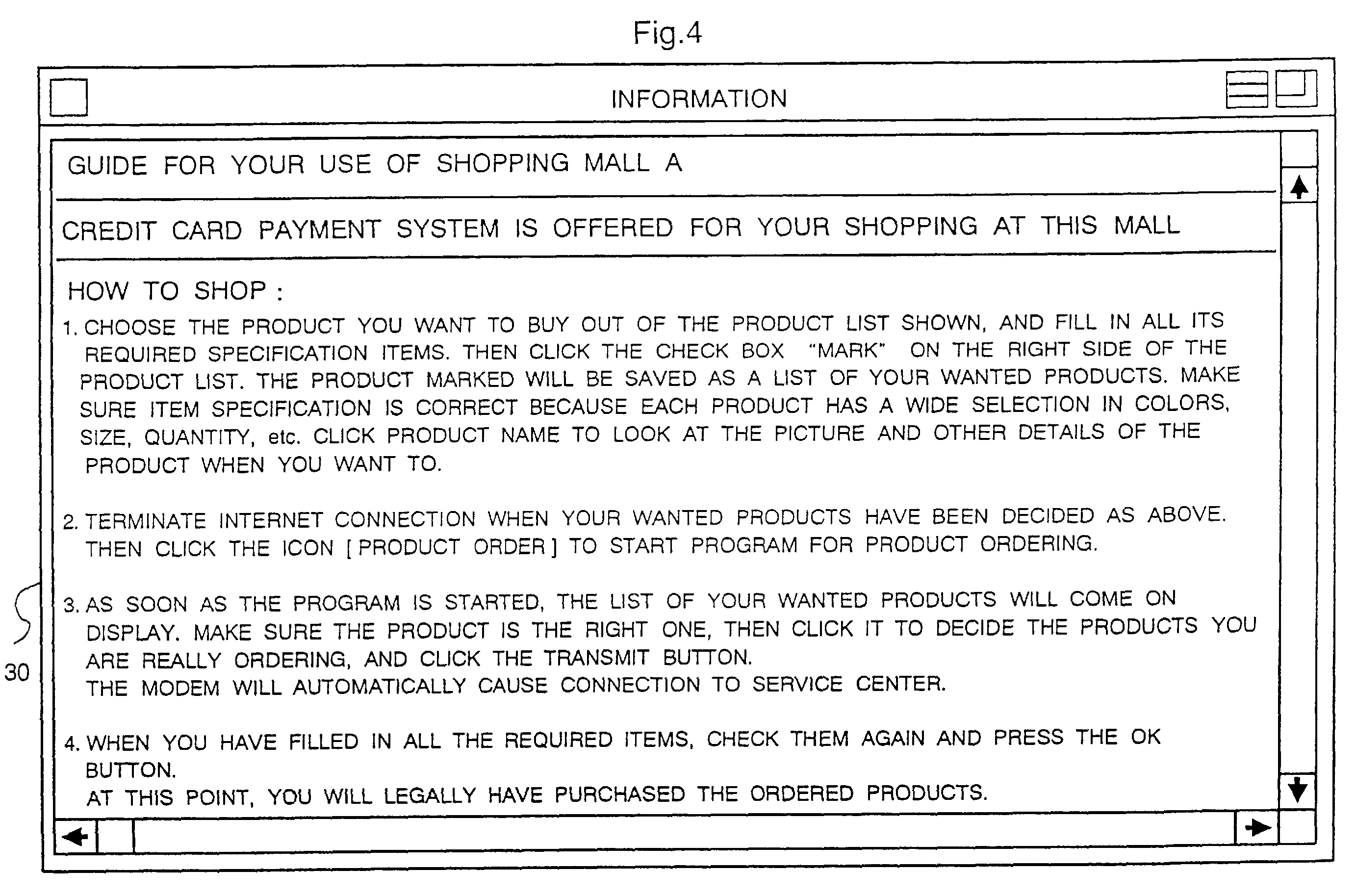 5,890,137 refers to eight patents:
5,890,137 refers to eight patents:
- 4,823,264 entitled "Electronic funds transfer system" filed
on May 27, 1986;
- 5,692,132 entitled "System and method for conducting cashless
transactions on a computer network" filed by MasterCard on June 7, 1995; this is an electronic wallet patent: "the system user uses a personal
computer to interact with merchant computers over the Internet to conduct cashless transactions. Each system user computer processes data
including a balance stored in the computer's memory and updates the stored data at the end of the transaction. The system is specially designed
for purchases of items or transactions of relatively small monetary value. In this manner, the amount of the transaction is deducted from the
balance on the computer. In accordance with the invention, when the existing balance associated with the computer does not cover the price of
the transaction, the system provides a reload feature which gives the user an option to increase the balance of the computer;"
The system involves a Financial Service Provider (FSP).
"Each copy of the FSP cashless transaction software has a unique account number associated with it. Once the software is installed on computer
100, the software prompts the user through an initialization process in which the user enters personal information such as the name, address,
telephone, social security number, etc. and designates an issuer bank which bills the user for the initial loading and subsequent increases to
the user account. All such information is forwarded to the FSP over network 110 in a secure encrypted format as described above. After a
predetermined period sufficient to check the user's information, the user may request a load on his/her account from the FSP. To this end, the
user again communicates with the FSP computer over network 110. If the user has been approved, this load request is granted and the user account
will be loaded with an initial amount, e.g., $25. The request grant is then communicated to the issuer bank which bills the user for the initial
load."
The user has to enter a PIN code to allow the transaction to occur. This is only then that the system can check whether the item price is higher
than the wallet balance;
- 5,710,887 entitled "Computer system and method for electronic
commerce" filed by Broadvision on August 29, 1995;
the summary reads:
"The customer monitoring object is created by referencing information, relating to that customer, which had been stored in the customer information
database and when the customer selects a supplier. The customer monitoring object is configured to operate by responding to customer enquiries,
communicated through the input means, regarding a presented item by accessing the item database to retrieve information relating to said item and
to present said information to the customer by means of the display; receiving a customer's selection of a presented item through the input means;
communicating with the pricing means to cause the cost of the item to be determined; presenting the cost to the customer by means of the display;
receiving customer communications, through the input means, indicating a desire to receive the item; and passing a delivery initiation communication
to initiate the delivery of the item to the customer;"
the description of the embodiments reads:
"it is a Participant Program Object 112 that represents the customer 12 in the commerce system. The Participant Program Object 112 contains
information that identifies the participant 12, and additional information about the participant, for example, the participant's name, address,
privacy controls, demographic data, and methods available to the participant for payment;"
- 5,715,314 entitled "Network sales system" filed by
OpenMarket on October 24, 1994; the summary reads:
The buyer computer is programmed to receive a user request for purchasing a product, and to cause a payment message to be sent to the payment
computer that comprises a product identifier identifying the product. The payment computer is programmed to receive the payment message, to cause
an access message to be created that comprises the product identifier and an access message authenticator based on a cryptographic key, and to
cause the access message to be sent to the merchant computer. The merchant computer is programmed to receive the access message, to verify the
access message authenticator to ensure that the access message authenticator was created using the cryptographic key, and to cause the product to be
sent to the user desiring to buy the product.
- 5,727,163 entitled "Secure method for communicating credit card data
when placing an order on a non-secure network" filed by Amazon (the inventor being Jeffrey Bezos) but that is not 1-click; 5,727,163 was filed on
March 30, 1995 and the priority date is November 7, 1994;
- 5,732,400 entitled "System and method for a risk-based purchase of
goods" filed by Citybank on January 4, 1995;
- WO9512859 aka
6,438,527,
6,032,133,
5,465,206, entitled "ELECTRONIC BILL PAY SYSTEM"
filed by VISA on November 1, 1993;
- WO9516971 entitled "DIGITAL ACTIVE
ADVERTISING" filed by OpenMarket on December 16, 1993.
5,890,137 is referenced by 40 patents.
5,857,175 is entitled "System and method for
offering targeted discounts to customers." It was filed by Micro Enhancement International on August 11, 1995.
This patent subject matter relates to coupon redemption. Coupon redemption is a business in which, inherently:
- the customer has to identify first; otherwise the system does not know the discounts and coupons the user is entitled to
receive;
- there are several discounts and coupons that have to be displayed first;
- because the user signed in first the coupon selection is one click.
| Limitation |
5,857,175 |
| under control of a client system (1) | kiosk
("offer communicator) as depicted on FIG. 21 |
| displaying information identifying the item (2) |
"A system for presenting customized special offers to customers" [claim 1] |
| in response to only a single action being performed (3) | No. The customer signs in first: "means for accessing customer account information for a particular customer in response
to the card reader sending read information to a store level computer, for generating an individualized list of special
offers available to that particular customer, and for sending the list of special offers to the offer communicator housed
with the card reader that sent the read information" [claim 50]. The customer accepts or declines special offers in one
action, but in doing so she builds a shopping list. Then the customer can print the list and make shopping in the store. At
check-out the items actually purchased are matched with the shopping list. |
| a data storage medium storing information for a plurality of users (7) |
"at least one computer including a database containing customer account information
providing information specific to a particular customer account" [claim 1] |
| a request including an indication of one of the plurality of users (8) |
"a plurality of cards, each card having thereon machine readable information for
associating the card with particular customer account information and with a particular store in the chain" [claim 25] |
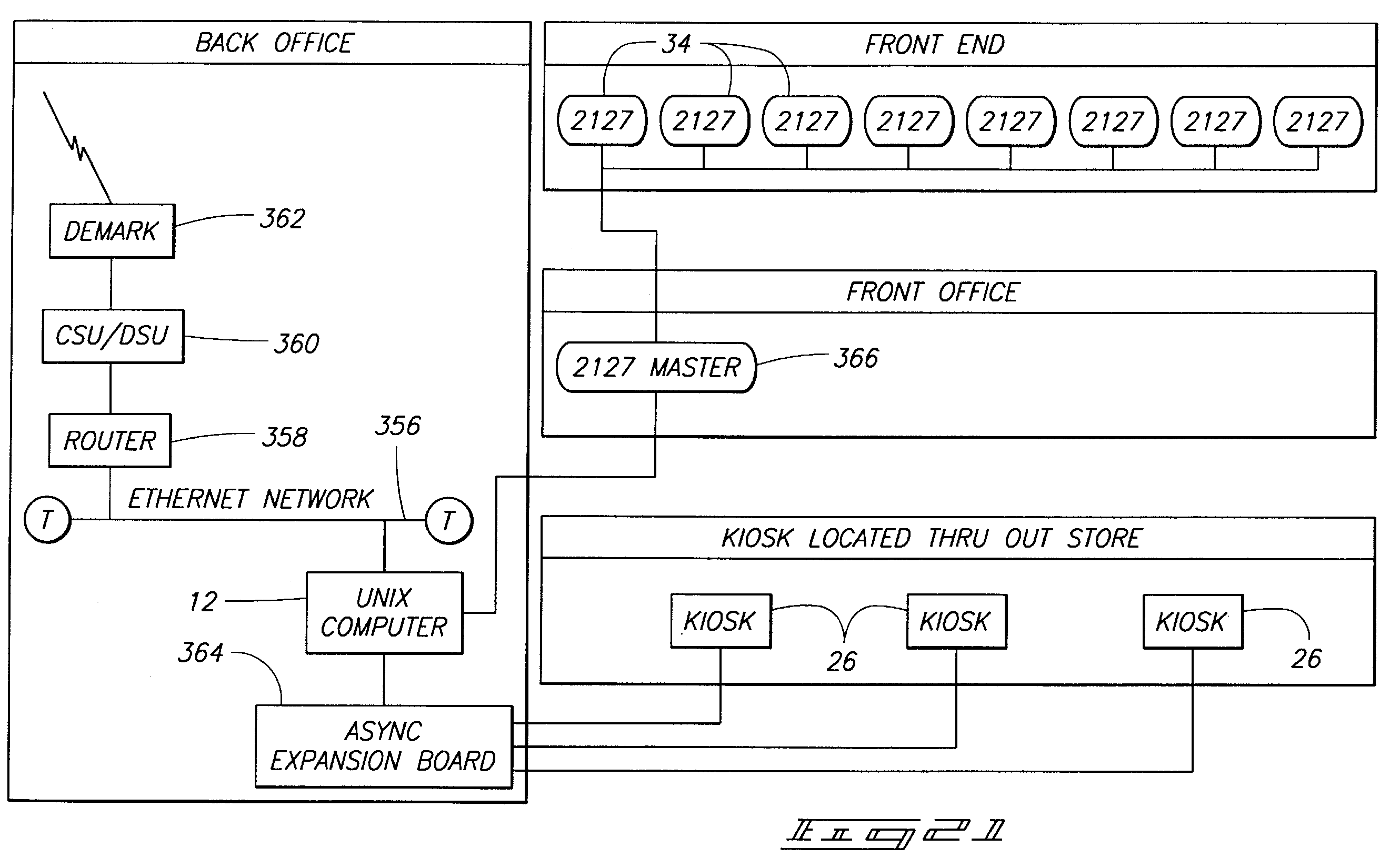
5,857,175 refers to 13 patents:
- 3,959,624 entitled "Coded merchandising coupon" filed on December 13, 1974;
- 4,124,109 entitled "Dispensing apparatus and method" filed on February 11,
1977
- 4,412,631 entitled "Carousel card dispenser" filed on September 17, 1981;
- 4,554,446 entitled "Supermarket inventory control system and method" filed
November 18, 1983;
- 4,674,041 entitled "Method and apparatus for controlling the distribution
of coupons" filed on September 15, 1983;
- 4,723,212 entitled "Method and apparatus for dispensing discount coupons"
filed on February 27, 1987 and whose priority date is July 18, 1984;
- 4,882,675 entitled "Paperless system for distributing, redeeming and
clearing merchandise coupons" filed on November 26, 1984;
- 4,896,791 entitled "Coupon dispensing system" filed on November 10, 1988
and whose priority date is January 20, 1987; the abstract reads "The system receives an access code unique to the consumer, records product selections made
by the consumer, compares the product selected by the consumer with a preselected quota, and issues a coupon for the product selected by the consumer if the
quota for that consumer is not exceeded;"
- 5,380,991 entitled "Paperless coupon redemption system and method thereof"
filed on November 16, 1993;
- 5,388,165 entitled "Method and system for building a database and performing
marketing based upon prior shopping history" filed on January 4, 1994 whose priority date is May 19, 1992; the priority date of some parts is May 1, 1989;
- 5,459,306 entitled "Method and system for delivering on demand, individually
targeted promotions" filed on June 15, 1994;
- 5,515,270 entitled "Technique for correlating purchasing behavior of a
consumer to advertisements" filed on January 12, 1995 and whose priority date is July 22, 1991;
- 5,649,114 entitled "Method and system for selective incentive point-of-sale
marketing in response to customer shopping histories" filed on June 1, 1995 and whose priority date is October 20, 1993; the priority date of some parts is
May 1, 1989.
5,857,175 is referenced by 75 patents. Some of them are of interest but they were filed too late to anticipate 1-click.
5,845,265 is entitled "Consignment nodes."
It was filed by MercExchange on August 11, 1995.
Online auctions implies displaying items offered for sale and that participants have signed in, the main difference
with 1-click being that a bid is not necessarily equivalent to an order.
| Limitation |
5,845,265 |
| under control of a client system (1) | see FIG. 1
|
| displaying information identifying the item (2) |
see FIG. 13 |
| in response to only a single action being performed (3) | the user posts a bid in one action. This is a conditional purchase in that the order will be fulfilled for the
winner only (highest bidder) in most common auctions but the user is committed to buy the item at the bid price. |
| sending a request to order the item [...] to a server system (4) | the request is sent by the participant to the consigment node |
| the request including the identifier so that the server system can locate additional
information needed to complete the order and so that the server system can fulfill the generated order to complete purchase
of the item (5) | "The post bid 300 sub-routine gets participant session identifications
302 from a data record or data structure that contains a list of session identifications of participants who have logged onto
the auction sessions." |
| a data storage medium storing information for a plurality of users (7) |
See above. Inherency following from "the terms of the auction sale are posted and agreed
to by the participants before allowing a participant to bid on goods in compliance with local requirements and statutes. It
is also understood that a participant may make electronic payment for the goods or establish a line of credit or collect on
delivery terms within a particular consignment node user's discretion."
"It is understood that when a participant logs into the consignment node and selects the auction mode, (see FIG. 2), the
participant's session identification is passed to a data structure. The data structure maybe used by the check for bids 350
sub-routine to correctly identify participants at a particular virtual auction. |
| a receiving component for receiving requests to order an item [...], the request being
sent in response to only a single action being performed (8) | "The post bid 300
sub-routine gets participant session identifications 302 from a data record or data structure that contains a list of session
identifications of participants who have logged onto the auction sessions." |
| a request including an indication of one of the plurality of users (9) |
session identifier - said session identifier following from the X25/TCP/IP identifier |
| an order placement component that retrieves from the data storage medium information
for the indicated user (10) | Inherency following from "the terms of the auction sale
are posted and agreed to by the participants before allowing a participant to bid on goods in compliance with local
requirements and statutes. It is also understood that a participant may make electronic payment for the goods or establish a
line of credit or collect on delivery terms within a particular consignment node user's discretion." |
| uses the retrieved information to place an order for the indicated user for the item (11)
| The check for bids subroutine places the order for the winner and notifies said winner
|
| fulfilling the generated order to complete purchase of the item whereby the item is
ordered without using a shopping cart ordering model (12) | transfer ownership subroutine
|
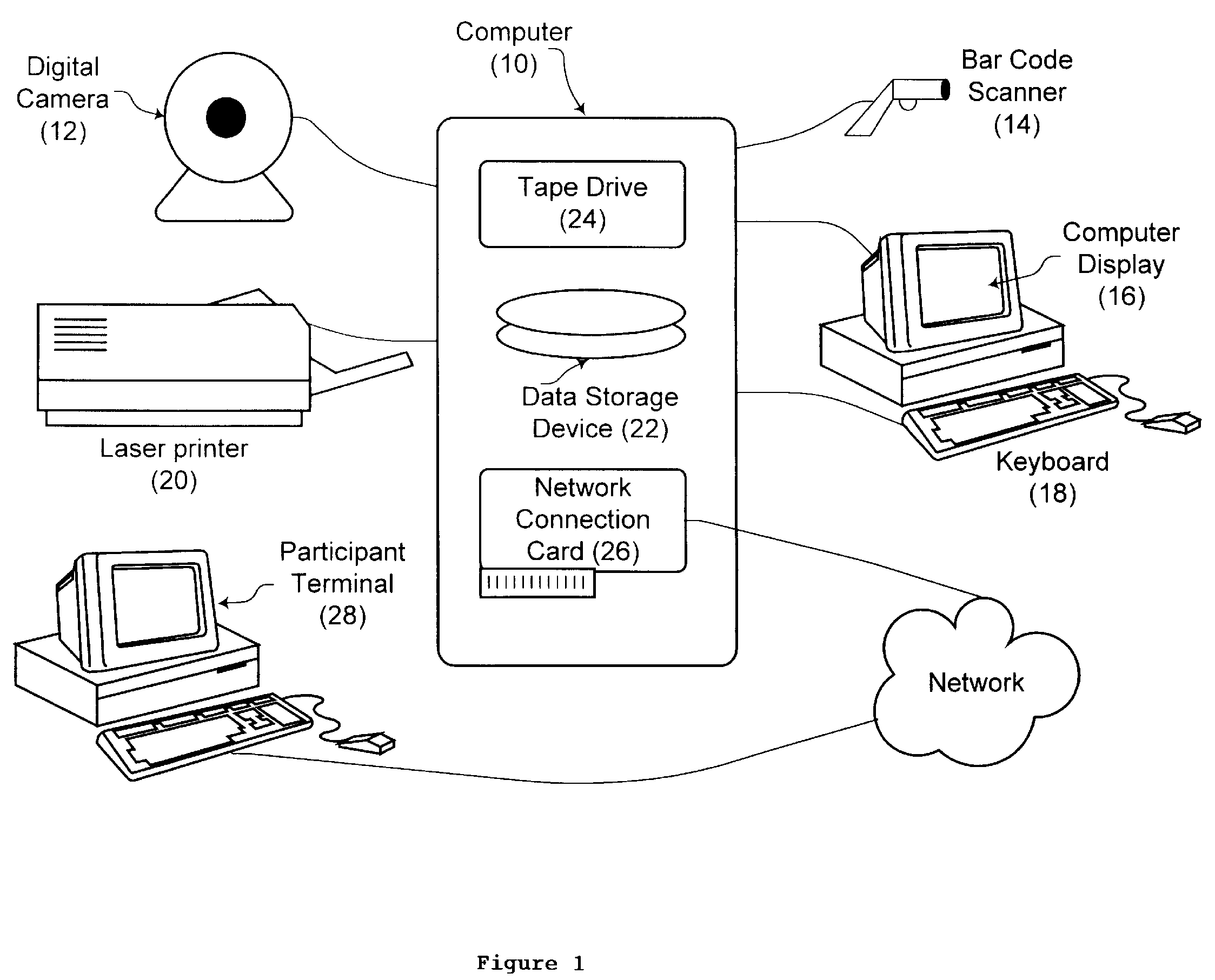
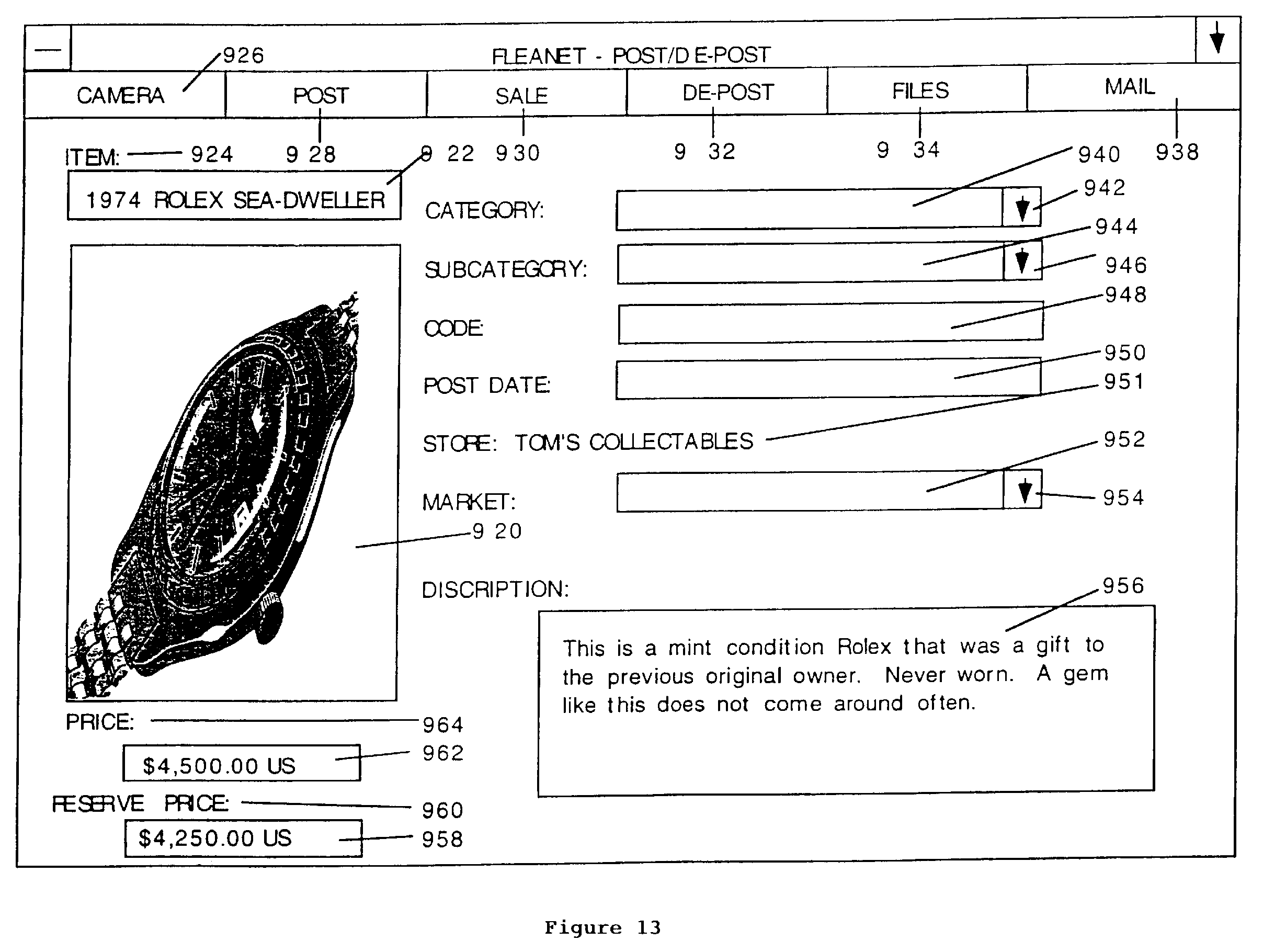 I discuss 5,845,265 in the Software and business method patents - MercExchange page.
5,845,265 refers to 26 patents:
I discuss 5,845,265 in the Software and business method patents - MercExchange page.
5,845,265 refers to 26 patents:
- 4,270,042 entitled "Electronic funds transfer system" filed on July 13, 1978,
the priority date of some parts being Aug. 1, 1977;
- 4,346,442 entitled "Securities brokerage-cash management system" filed by
Merrill Lynch and others on July 29, 1980;
- 4,674,044 entitled "Automated securities trading system" filed by Merrill
Lynch and others on January 30, 1985;
- 4,739,478 entitled "Methods and apparatus for restructuring debt obligations"
filed by Lazard Freres on September 26, 1986 and whose priority date is November 21, 1984;
- 4,742,457 entitled "System and method of investment management including means
to adjust deposit and loan accounts for inflation" filed on August 27, 1985;
- 4,751,640 entitled "Automated investment system" filed by Citybank on June 14,
1984;
- 4,789,928 entitled "Auction information transmission processing" filed on
January 30, 1987 and whose priority date is Feb 17, 1986;
- 4,799,156 entitled "Interactive market management system" filed on October 1,
1986;
- 4,823,265 entitled "Renewable option accounting and marketing system" filed on
May 11, 1987;
- 4,876,648 entitled "System and method for implementing and administering a
mortgage plan" filed on January 12, 1988;
- 4,885,685 entitled "Investment management system with travel usage funds
indexed to customer account status" filed on September 18, 1987;
- 4,903,201 entitled "Automated futures trading exchange" filed on November 3,
1983;
- 4,910,676 entitled "Processing system for managing bi-media investments"
filed on March 30, 1987;
- 5,063,507 entitled "Goods database employing electronic title or documentary-type
title" filed by Plains Cotton Cooperative Association on September 14, 1990; I mention this invention in the IBM section of
the 1-click analysis;
- 5,101,353 entitled "Automated system for providing liquidity to securities markets"
filed on May 31, 1989;
- 5,193,056 entitled "Data processing system for hub and spoke financial services
configuration" filed by Signature Financial Group on March 11, 1991; this is the patent in question in the famous State Street case
law;
- 5,206,803 entitled "System for enhanced management of pension-backed credit" filed
on March 15, 1991;
- 5,235,680 entitled "Apparatus and method for communicating textual and image
information between a host computer and a remote display terminal" filed on September 17, 1991 and whose priority date is 31 July, 1987;
- 5,237,500 entitled "System and process for converting constant dollar financial
instruments" filed on February 27, 1990;
- 5,239,462 entitled "Method and apparatus for automatically determining the approval
status of a potential borrower" filed on February 25, 1992;
- 5,262,942 entitled "Financial transaction network" filed on June 5, 1990;
- 5,283,731 entitled "Computer-based classified ad system and method" filed on
December 23, 1992, the priority date of some parts being Jan. 19, 1992;
- 5,285,383 entitled "Method for carrying out transactions of goods using electronic
title" filed by Plains Cotton Cooperative Association on October 15, 1991, the priority date of some parts being September 14, 1990; I mention this invention in the
IBM section of the 1-click analysis;
- 5,323,315 entitled "Computer system for monitoring the status of individual items
of personal property which serve as collateral for securing financing" filed on August 2, 1991;
- 5,451,998 entitled "Home shopping video catalog" filed on April 4, 1994; This patent
describes an order form that may contain several items and does not say when and how the customer enters her payment and shipment data;
- 5,465,291 entitled "Apparatus for ordering from remote locations" filed on January
6, 1995 and whose priority date is April 16, 1991. The background mentions Prodigy and the patent describes a system using DTMF. The summary reads:
"A summary example of an illustrative application of the invention may employ a database at a grocery store. A user at home may use a catalog or any other printed
material containing Universal Produce Code (UPC) symbols or other machine readable codes in concert with the before-described preferred remote bar code reading
device to access a database at a grocery store. As items are scanned in by the user passing the bar code reader or wand over the bar codes in the catalog that
represent the items to be ordered and are transmitted preferably in DTMF form over the telephone to the remote store, they may be added to a list of items at the
store that the user is requesting to be delivered. The database at the grocery store may contain personal information about the shopper, including address and billing
information that facilitates grocery delivery, and also information about the products available at the store, including price and availability."
The preferred embodiment reads:
"Upon connection to the store CIU, it is then necessary for the user of the bar code wand W to identify himself or herself. This is easily done by allowing the user to
scan in an identification bar code (ID) supplied by the merchant when the account is set up with the merchant. The user can enter the ID code either by scanning a bar
code representation of the ID, or typing it in using the touch-tone keypad, if desired, as is well known.
As is customary practice in other related applications, the CIU can determine whether there are any available lines for the user to place an order, and, if a line
is not available, either the CIU can put the user on hold, or can estimate the amount of time that will be required to wait, and call back the user when a line is
available.
Once connected to an ordering line on the CIU, the user, using the wand W, can place an order, set up a delivery time, query a pending order, or ask for information
about items available for order. Other types of commands can be accepted by the CIU, but for this example, these will suffice. The CIU decodes the commands and reads
back requested information. For instance, if the user of the device would like to order something, the user scans the code corresponding to that item from the
merchant-supplied catalog C, or, if desired, from the label of the item, or from some other source."
I read that 5,465,291 comprises the pre-registration of users, the sign-in, the item list display and the 1-click order along with a shopping cart (the customer
can order several items.) The user identifier is not sent along with the order because the user has to use the same dedicated connection for sign-in and ordering.
The patent also contains a suggestion to combine with Prodigy (the web marketplace ancestor.)
5,845,265 is referenced by 75 patents, including:
- 6,029,172 entitled "Method and system for selecting an information item" filed by
Philips on August 19, 1997 and whose priority date is Aug 28, 1996; this patent teaches a Broadvision-like system for selecting items, which implies identifying
the user earlier;
- 6,012,045 entitled "Computer-based electronic bid, auction and sale system, and a
system to teach new/non-registered customers how bidding, auction purchasing works" filed on July 1, 1997; this patent establishes "a virtual showroom on said
computer system, said virtual showroom being accessible by said plurality of customer computers and including electronic displays of said plurality of consumer
products and services which are offered for sale" and blocks "customers from becoming bidders and posting bids until said customers have electronically
pre-registered."
5,613,012 is entitled "Tokenless identification system for authorization of electronic
transactions and electronic transmissions". It was filed by Smarttouch on May 17, 1995. The priority date of some parts is November 28, 1994.
Patents referenced by this patent and patents referencing this patent relates to security and notably to biometric use.
There were two familiar approaches by 1995:
- the shop way: you authenticate when you check-out;
- the access control way (the 1-click way): you authenticate when you enter the secured place before doing anything; this is also the ATM way: you authenticate
and then you withdraw money, you check your account and order fund transfers after selecting the operation in a list.
The invention describes a system in which users register and then sign-in and in which providers maintain a user database containing their credentials, address and
payment data. The system sends the generated identifier along with each transaction (see the DUKT discussion.) There are three actors in Internet transactions:
- the Internet Point of sale Terminal (IPT);
- the merchant;
- the Data Processing Center (DPC) that maintains the user database.
"First, the IPT connects to the merchant using the Internet. Once a connection is established, the IPT secures it by generating and then sending a Session Key to the
merchant. In order to assure that the session key is protected from disclosure, it is encrypted with the merchant's Public Key using Public Key Encryption. When the
merchant receives this encrypted Session Key, he decrypts it using his Private Key. This process is called securing a connection through a Public Key Encrypted secret
key exchange [~ SSL].
Once connected, the IPT downloads the merchant code, and both price and product information from the merchant. Once the individual is ready to make a purchase, he
selects the merchandise he wishes to buy. Then, the individual enters the biometric-PIC using the BIA/PC, the IPT sends the merchant code, the product identification
information, and the amount to the BIA, and instructs it to construct a Remote Transaction Authorization request. Then the IPT sends the request to the merchant via
the secure channel.
The merchant is connected to the DPC via the same sort of secure connection that the IPT has with the merchant, namely, using Public Key Encryption to send a secure
session key. Unlike the IPT- merchant connection, however, merchant-DPC session keys are good for an entire day, not for just one connection.
The merchant connects to the DPC, securing the connection using the session key, forwarding the transaction to the DPC for validation. The DPC validates the
biometric-PIC, cross-checks the merchant code contained in the request with the merchant code stored under the hostname that was sent in the request, and then sends
a transaction to the credit/debit network. Once the credit/debit network responds, the DPC constructs a reply message including the credit/debit authorization, an
encrypted private code, and the address of the individual, and sends that message back to the merchant.
Once the merchant receives the reply, it copies the individual's mailing address out of the reply, makes note of the authorization code, and forwards the reply
message to the IPT."
| Limitation |
5,613,012 |
| under control of a client system (1) | "The
invention comprises a computer network host system with means for comparing the entered biometrics sample and personal
identification code, and is equipped with various data bases and memory modules. Furthermore, the invention is provided with
biometrics and personal identification code input apparatus and terminals for entering data to provide information
for execution of the requested transactions and transmissions by the host system once the identity of the individual is
determined. The invention is also provided with means for connecting the host system with the terminal and the
biometrics input apparatus." |
| displaying information identifying the item (2) |
the Internet Point of sale Terminal (IPT) "downloads the merchant code, and both price and product information from the
merchant" |
| in response to only a single action being performed (3) | "Once the individual is ready to make a purchase, he selects the merchandise he wishes to buy. Then, the
individual enters the biometric-PIC using the BIA/PC, the IPT sends the merchant code, the product identification information,
and the amount to the BIA, and instructs it to construct a Remote Transaction Authorization request. Then the IPT sends the
request to the merchant via the secure channel." The question is whether entering a biometric personal identification code is
an action. "The biometrics scanner can be any one of finger print scanner, voice recognition, palm print scanner, retinal
scanner or the like." |
| sending a request to order the item [...] to a server system (4) | "the IPT sends the request to the merchant," the request containing "the merchant code, the product
identification information, and the amount." |
| the request including the identifier so that the server system can locate additional
information needed to complete the order and so that the server system can fulfill the generated order to complete purchase
of the item (5) | The Remote Transaction Authorization request contains the biometric
personal identification code. The system "validates the biometric-PIC ["comparing the entered biometrics sample and personal
identification code"], cross-checks the merchant code contained in the request with the merchant code stored under the
hostname that was sent in the request, and then sends a transaction to the credit/debit network. |
| a data storage medium storing information for a plurality of users (7) |
"Individual Biometric Database: identifies individuals from their biometric and PIC code"
|
| a receiving component for receiving requests to order an item [...], the request being
sent in response to only a single action being performed (8) | The merchant receives the
IPT request and forwards "the transaction to the DPC for validation." |
| a request including an indication of one of the plurality of users (9) |
the biometric personal identification code |
| an order placement component that retrieves from the data storage medium information
for the indicated user (10) | The system "validates the biometric-PIC ["comparing the
entered biometrics sample and personal identification code"], cross-checks the merchant code contained in the request with
the merchant code stored under the hostname that was sent in the request, and then sends a transaction to the credit/debit
network." |
| uses the retrieved information to place an order for the indicated user for the item
(11) | "sends a transaction to the credit/debit network" as above and "Once the
credit/debit network responds, the DPC constructs a reply message including the credit/debit authorization, an encrypted
private code, and the address of the individual, and sends that message back to the merchant. Once the merchant receives the
reply, it copies the individual's mailing address out of the reply, makes note of the authorization code, and forwards the
reply message to the IPT. |
| fulfilling the generated order to complete purchase of the item whereby the item is
ordered without using a shopping cart ordering model (12) | Inherent because of payment
and from "once the individual is ready to make a purchase, he selects the merchandise he wishes to buy." |
5,613,012 refers to 32 patents:
- 4,821,118 entitled "Video image system for personal identification" filed on October
9, 1986;
- 4,837,422 entitled "Multi-user card system" filed on September 8, 1987;
- 4,926,480 entitled "Card-computer moderated systems" filed on May 24, 1988, the
priority date of some parts being August 22, 1983;
- 4,961,142 entitled "Multi-issuer transaction device with individual identification
verification plug-in application modules for each issuer" filed by MasterCard on June 29, 1988;
- 4,993,068 entitled "Unforgeable personal identification system" filed by Motorola on
November 27, 1989;
- 4,995,086 entitled "Arrangement and procedure for determining the authorization of
individuals by verifying their fingerprints" filed by Siemens AG on September 13, 1988 and whose priority date is May 06, 1986;
- 4,998,279 entitled "Method and apparatus for personal verification utilizing
nonpredictable codes and biocharacteristics" filed on January 18, 1989, the priority date of some parts being Nov. 30, 1984;
- 5,036,461 entitled "Two-way authentication system between user's smart card and
issuer-specific plug-in application modules in multi-issued transaction device" filed on May 16, 1990 and whose priority date is June 29, 1988;
- 5,054,089 entitled "Individual identification apparatus" filed by Toshiba on
December 18, 1989 and whose priority date is December 29, 1988;
- 5,095,194 entitled "Holographic credit card with automatical authentication and
verification" filed on October 12, 1989;
- 5,109,427 entitled "Fingerprint recognition device using a hologram" filed on
November 13, 1990 and whose priority date is November 13, 1989;
- 5,109,428 entitled "Minutia data extraction in fingerprint identification" filed
on December 6, 1989 and whose priority date is Dec 06, 1988;
- 5,144,680 entitled "Individual identification recognition system" filed by
Mitsubishi on December 5, 1990 and whose priority date is Mar 01, 1985;
- 5,168,520 entitled "Method and apparatus for personal identification" filed on
March 18, 1991, the priority date of some parts being Nov. 30, 1984;
- 5,180,901 entitled "IC card with individual authentication function" filed by
Toshiba on April 5, 1991 and whose priority date is May 21, 1990;
- 5,191,611 entitled "Method and apparatus for protecting material on storage media and
for transferring material on storage media to various recipients" filed on January 18, 1991, the priority date of some parts being Apr. 3, 1989;
- 5,210,588 entitled "Fingerprint identification apparatus for enhancing identification
performance by forming an illumination source and a light conducting panel in a single body" filed on November 15, 1991 and whose priority date is November 17, 1990;
- 5,210,797 entitled "Adaptive dictionary for a fingerprint recognizer" filed on
October 29, 1990 and whose priority date is Oct 30, 1989;
- 5,222,152 entitled "Portable fingerprint scanning apparatus for identification
verification" filed on November 19, 1991;
- 5,229,764 entitled "Continuous biometric authentication matrix" filed on June 20,
1991;
- 5,230,025 entitled "Method and apparatus for capturing skin print images" filed
on August 31, 1990;
- 5,239,583 entitled "Method and apparatus for improved security using access
codes" filed on April 10, 1991;
- 5,241,606 entitled "Person identification apparatus" filed by Matsushita on
October 7, 1991 and whose priority date is October 11, 1990;
- 5,251,259 entitled "Personal identification system" filed on August 20, 1992;
- 5,265,162 entitled "Portable pin card" filed on September 19, 1991 and whose
priority date is Jan. 16, 1990;
- 5,276,314 entitled "Identity verification system resistant to compromise by
observation of its use" filed by IBM on April 3, 1992;
- 5,280,527 entitled "Biometric token for authorizing access to a host system"
filed on April 14, 1992;
- 5,321,242 entitled "Apparatus and method for controlled access to a secured
location" filed by Brinks on December 20, 1991, the priority date of some parts being December 9, 1991;
- 5,325,442 entitled "Fingerprint sensing device and recognition system having
predetermined electrode activation" filed on February 19, 1993, the priority date being May 18, 1990;
- 5,335,288 entitled "Apparatus and method for biometric identification" filed on
February 10, 1992;
- 5,343,529 entitled "Transaction authentication using a centrally generated
transaction identifier" filed on September 28, 1993;
- 5,351,303 entitled "Infra-red imaging and pattern recognition system" filed on
February 25, 1993;
5,613,012 is referenced by 207 patents including:
- 5,802,497 entitled "Method and apparatus for conducting computerized commerce" filed by Digital on July 10, 1995 that reads:
"The scrip can be "serialized." This means that the vendor, as long as the consumer maintains a license, will exchange, along with the product, new scrip which can be used in a subsequent transaction. This
type of interchange would be of use for serialized products, such as periodic literature, or other products which are repeatedly ordered. Similarly, the system 100 as described herein, can be used to
control access to services provided by the vendor for member consumers. As long as the consumer continues to be a member, scrip from the consumer will be accepted;"
4,555,781 is entitled "Conversational video
system having local network control." It was filed by Reuters on March 30, 1983.
| Limitation |
4,555,781 |
| under control of a client system (1) | "a
plurality of subscriber terminals throughout said network, at least a portion of said plurality of subscriber terminals
comprising subscriber keystations, each of said subscriber keystations comprising a keyboard means for operator input of
textual data messages and associated data control signals to said network via said keyboard means and a video display means
for providing a textual video display of at least keyboard generated data input to said network" [claim 1] |
| displaying information identifying the item (2) |
See FIG. 10E. |
| in response to only a single action being performed (3) | the user makes calls. The calls are displayed in an incoming call area 500 on FIG. 11. The keyboard depicted on
FIG. 9 has special keys to accept calls and to make deals in one action. As depicted on FIG. 46 the system is single action
for the participant. |
| sending a request to order the item [...] to a server system (4) |
See FIG. 57 |
| the request including the identifier so that the server system can locate additional
information needed to complete the order and so that the server system can fulfill the generated order to complete purchase
of the item (5) | As depicted the system uses a packet switched network with switching
concentrator computers 48, 110 and 114 to establish conversations. A packet sent to the switching concentrator computer "is
preferably identified to the switching concentrator computer by a subscriber identifier and a unique controller number." |
| a receiving component for receiving requests to order an item [...], the request
being sent in response to only a single action being performed (8) | See explanation of
limitation 3 |
| a request including an indication of one of the plurality of users (9) |
A packet sent to the switching concentrator computer "is preferably identified to the
switching concentrator computer by a subscriber identifier and a unique controller number." |
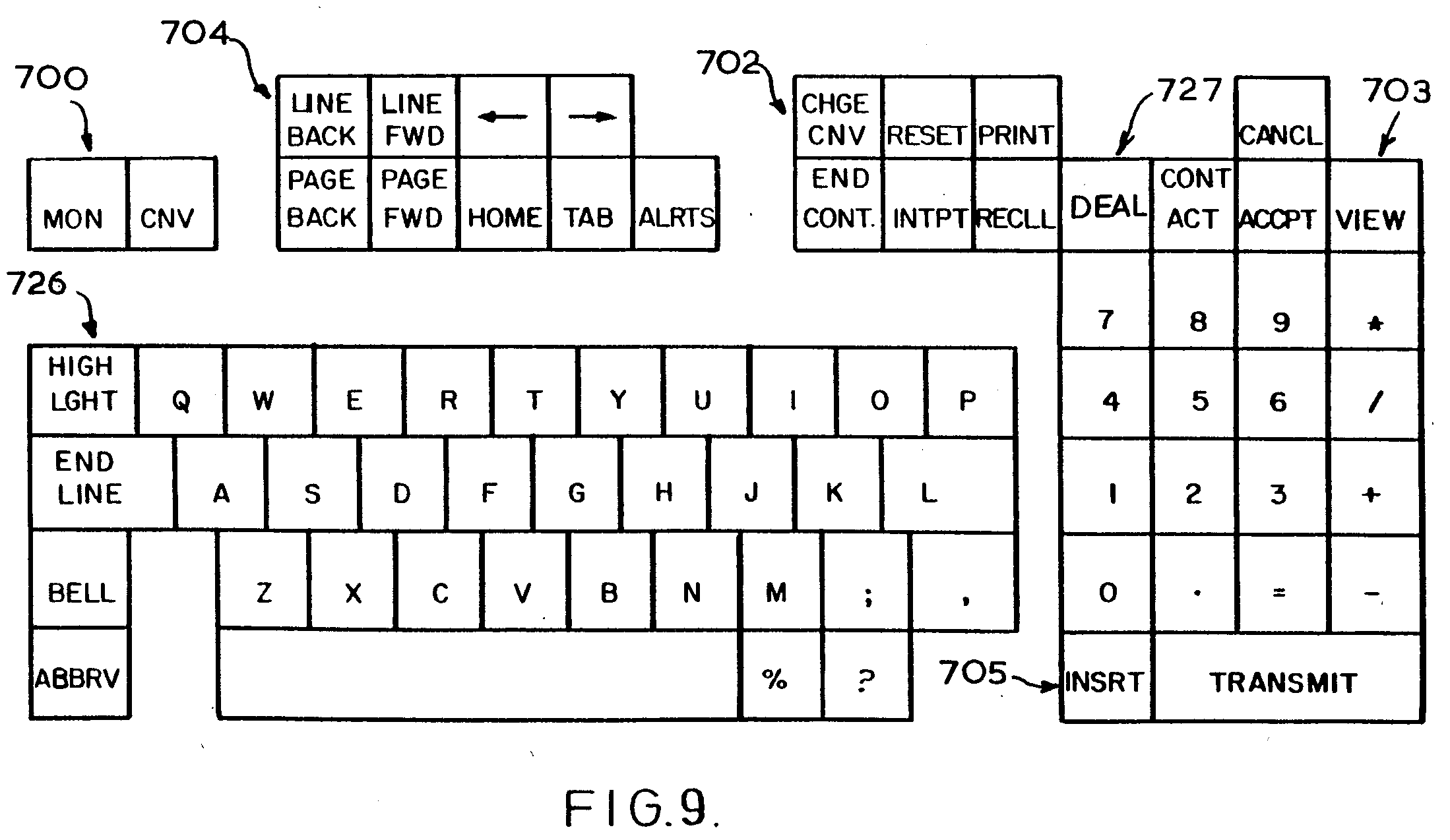
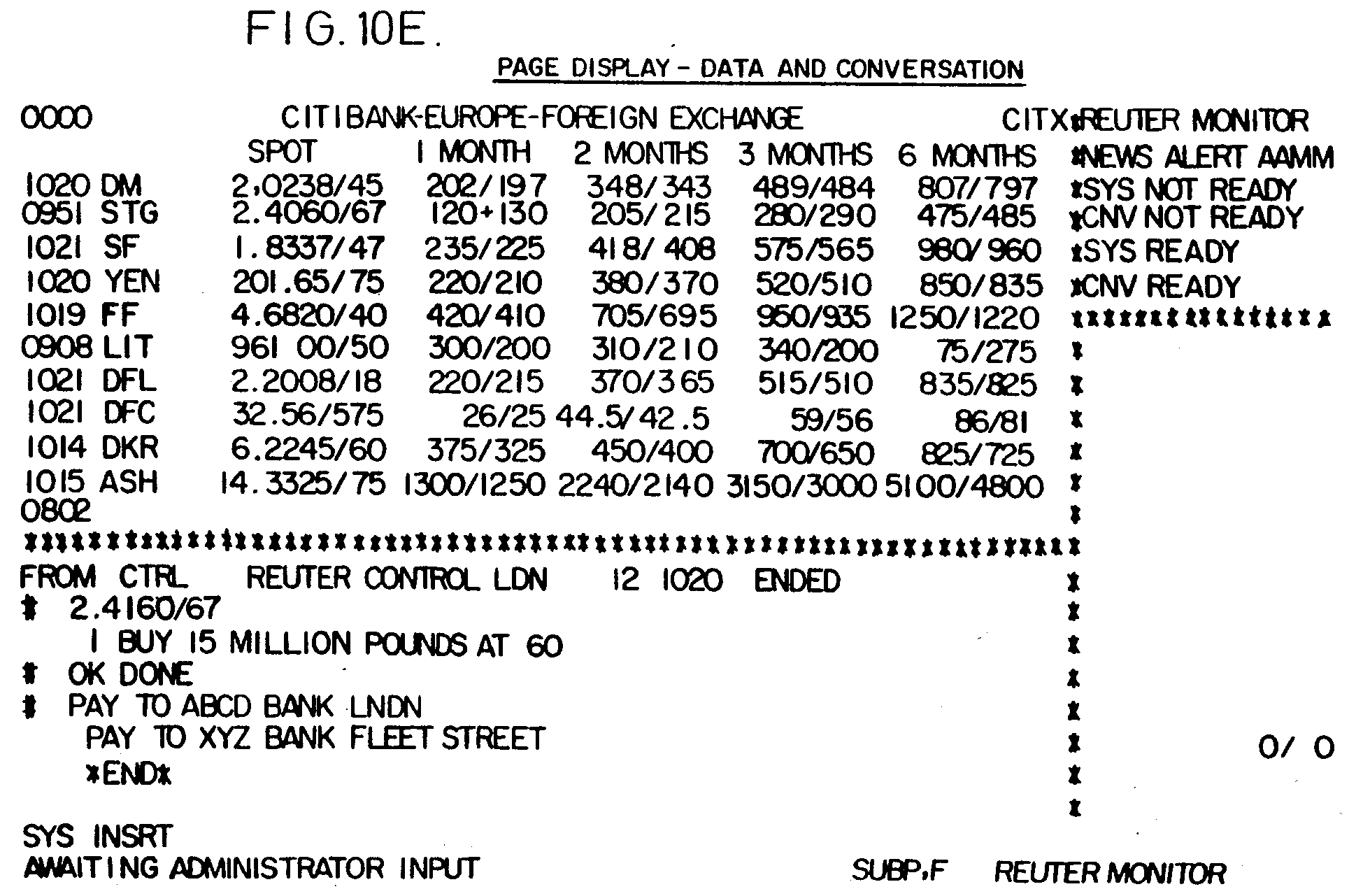
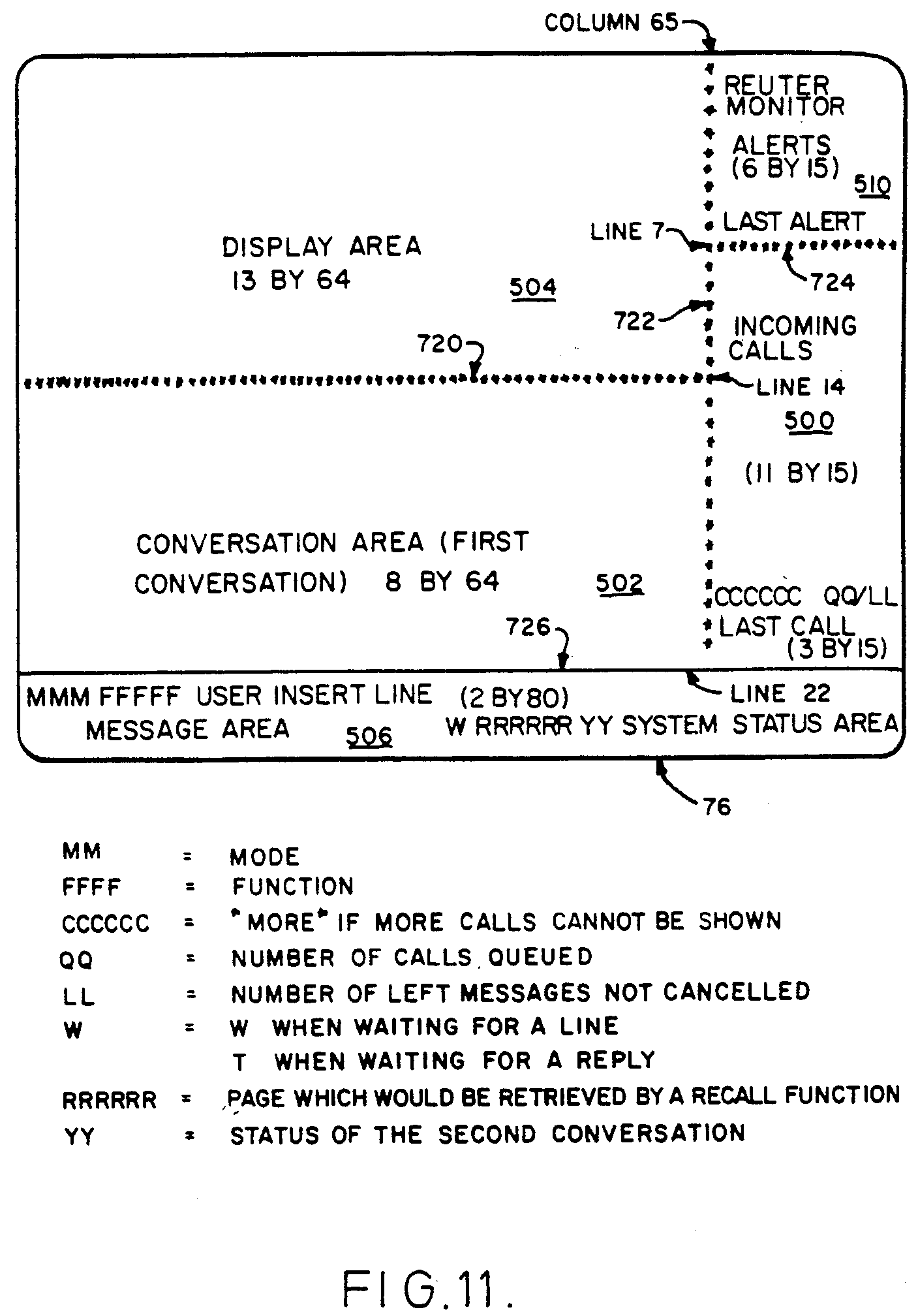

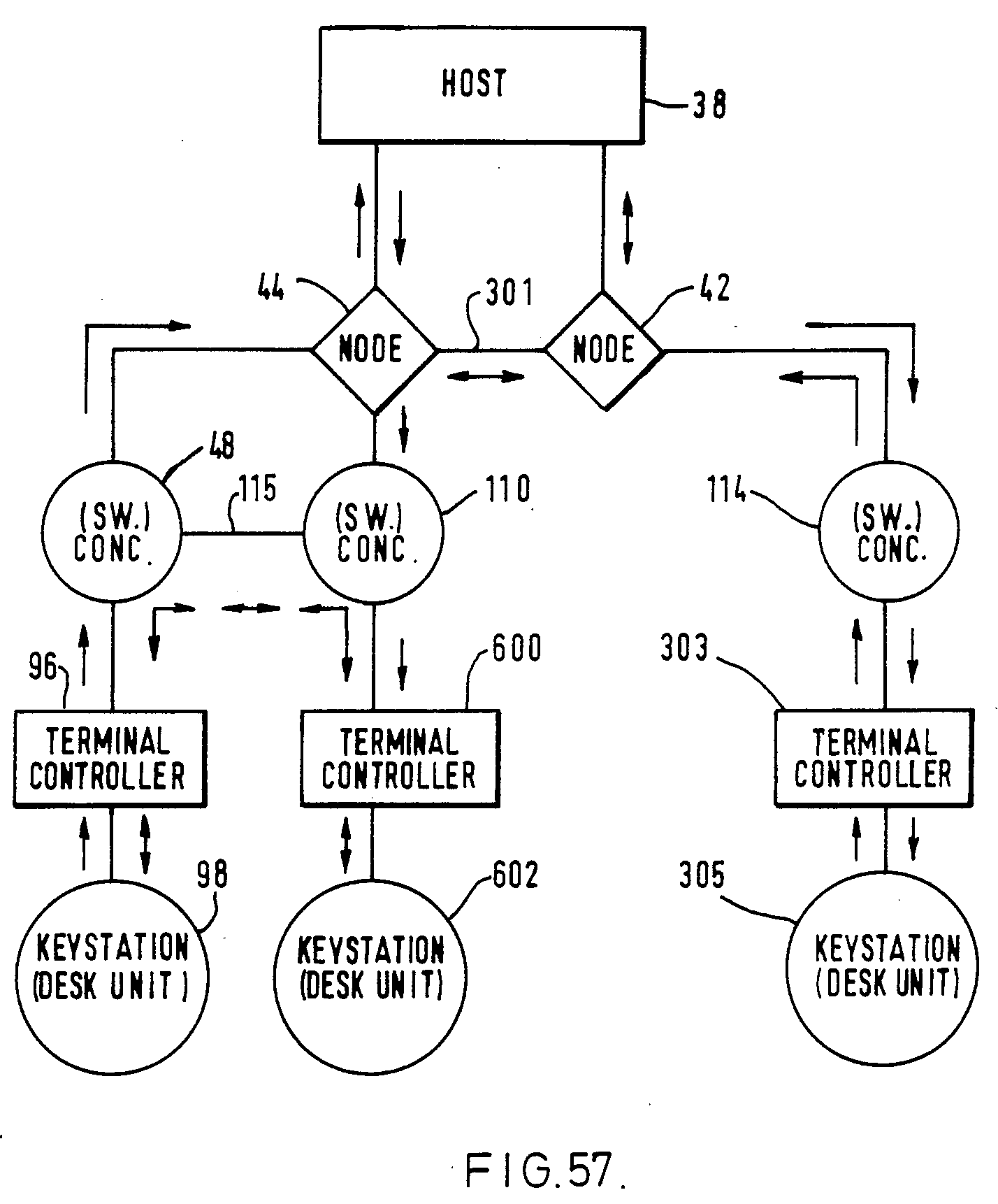
4,555,781 refers to:
- 3,166,636 entitled "Data composer" filed on
December 30, 1960;
- 4,213,124 entitled "System for digitally
transmitting and displaying texts on television screen" filed on September 14, 1977 and whose priority date is September 22,
1976;
- 4,290,062 entitled "System for digital
transmission and text display" filed on February 28, 1979 end whose priority date is March 10, 1978;
- 4,512,011 entitled "Duplicated network
arrays and control facilities for packet switching" filed by ATT on November 1, 1982.
4,555,781 is referenced by 13 patents including:
- 5,924,082 entitled "Negotiated matching
system" filed by Reuters on June 7, 1995 and whose priority date is August 17, 1994; the patent relates to negociated trading
(trading currencies, commodities, and the like);
- 5,528,671 entitled "Network control system"
filed by Fujitsu on May 14, 1991 and whose priority date is Sep 14, 1989;
- 5,168,446 entitled "System for conducting
and processing spot commodity transactions" filed on May 23, 1989; the abstract reads:
"Each trading station is capable of initiating a transaction with any other trading station in the network by transmitting
a request for a quotation on a selected commodity. The receiving, or counterparty, trading station responds by transmitting a
quotation back to the initiating trader, and the trader transmits a proposal based on this quotation. The counterparty then
transmits an acceptance of the proposal and upon receipt of this acceptance by the initiating trader, a confirmation signal
is automatically transmitted back to the counterparty and the deal is automatically logged at both sites."
The parties are identified, because the system preferably uses a packet switching network, an identifier allowing identifying
the user is sent with each message, and the acceptance is 1-click:
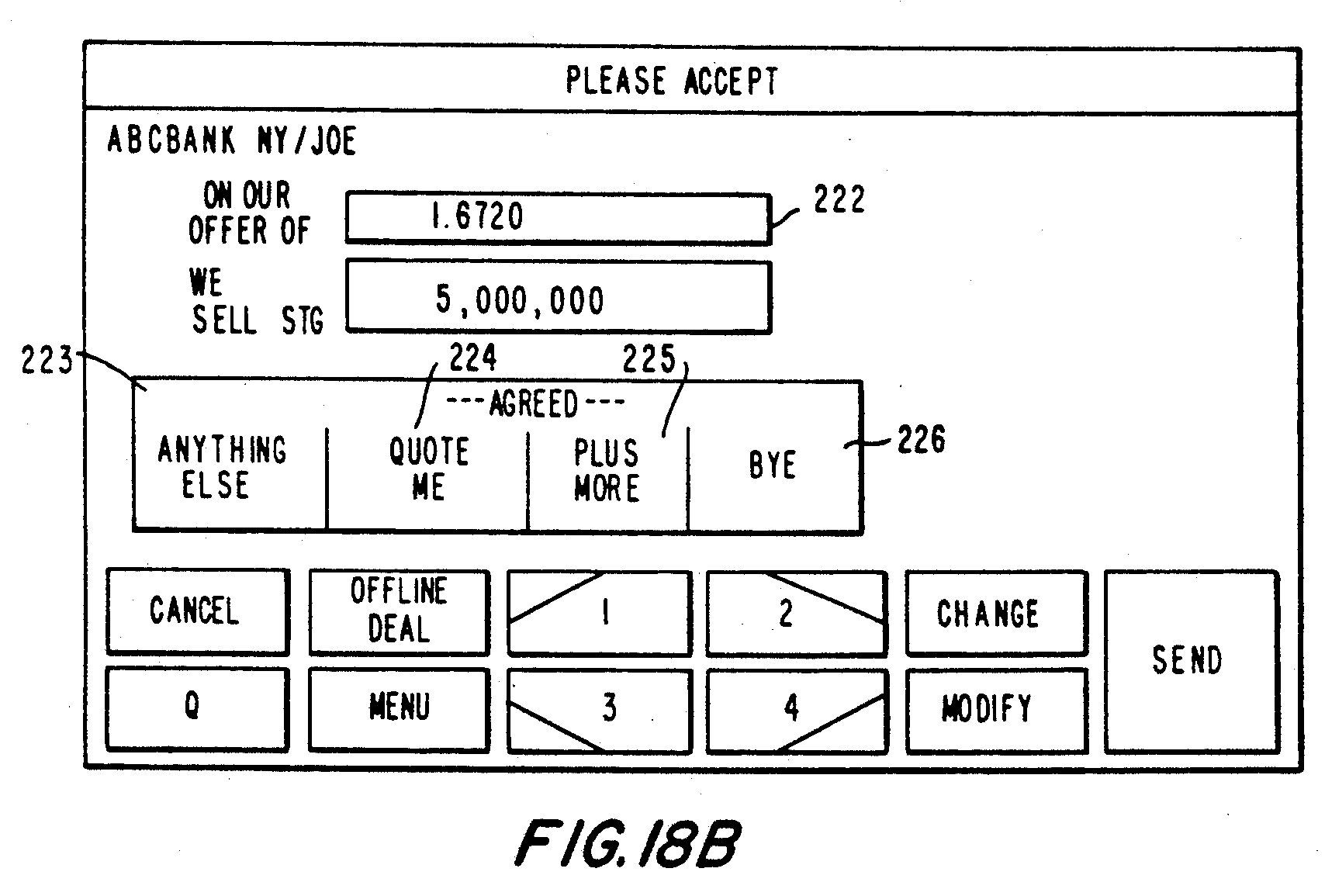
- 4,805,134 entitled "Electronic system for
accessing graphical and textual information" filed by IBM on January 9, 1986; 4,805,134 uses a Videotex Application Network
that itself uses a packet switched network and allows excuting transactions.
5,063,507 is entitled "Goods database employing
electronic title or documentary-type title." It was filed by the Plains Cotton Cooperative
Association (PCCA) on September 14, 1990.
| Limitation |
5,063,507 |
| under control of a client system (1) | "a
plurality of terminals for accessing said data base and for trading the goods" [claim 1] |
| displaying information identifying the item (2) |
"In order to invoke the program steps of FIG. 3D, information is input into a buyer's terminal 18, which information is
indicative of a desire to look at bales available for sale. Also, in response to such a request, a menu appears on the buyer's
terminal screen indicating information to input to complete a transaction for purchasing one or more bales of cotton." |
| in response to only a single action being performed (3) |
See FIG. 3D |
| sending a request to order the item [...] to a server system (4) |
buyers connect to the centralized computer trading system that accesses the database as
depicted on FIG. 1 |
| the request including the identifier so that the server system can locate additional
information needed to complete the order and so that the server system can fulfill the generated order to complete purchase
of the item (5) | the centralized computer trading system runs a transaction monitor
like CICS accessed using an SNA network. Within such apparatus buyers sign-in to the transaction monitor. Then a conversation
or pseudo-conversation is established. Each terminal is uniquely identified by an SNA ID. The sign-in associates the SNA ID
to the user. Said ID is carried in messages sent to the transaction monitor. |
| a data storage medium storing information for a plurality of users (7) |
"A buyer master file record is unique to each buyer associated with the system" as
depicted on FIG. 2. |
| a receiving component for receiving requests to order an item [...], the request being
sent in response to only a single action being performed (8) | transaction monitor |
| a request including an indication of one of the plurality of users (9) |
see explanation for limitation 5 |
| an order placement component that retrieves from the data storage medium information
for the indicated user (10) | On FIG. 3D "From block 142, program flow branches to
decision block 144 to determine if the buyer is involved or associated with the electronic title system of the invention, as
incorporated in the system noted in FIG. 1. Such a determination is made by accessing the buyer master file 54 to determine
whether or not the buyer is so involved. With respect to the buyer terminals 18 connected via networks 46 to the mainframe
computer 10, some or all of the buyers may have previously agreed to carry out cotton trading transactions using the
electronic title of the invention, i.e., an electronic warehouse receipt, rather than the card form of title." |
| uses the retrieved information to place an order for the indicated user for the item
(11) | See FIG. 3D |
| fulfilling the generated order to complete purchase of the item whereby the item is
ordered without using a shopping cart ordering model (12) | On FIG. 1 "File 52 comprises a
shipping order file which is employed when a buyer or the producer initiates a transaction in which a cotton bale is shipped.
This file includes a record for each shipping order. The shipping order file 52 includes fields identifying the unique bale
numbers, the destination of the bales, the mode of transportation and the date of shipment." FIG. 3F shows that shipping is a
separate transaction (it makes sense to transfer ownership without shipment in 5,063,507.) |
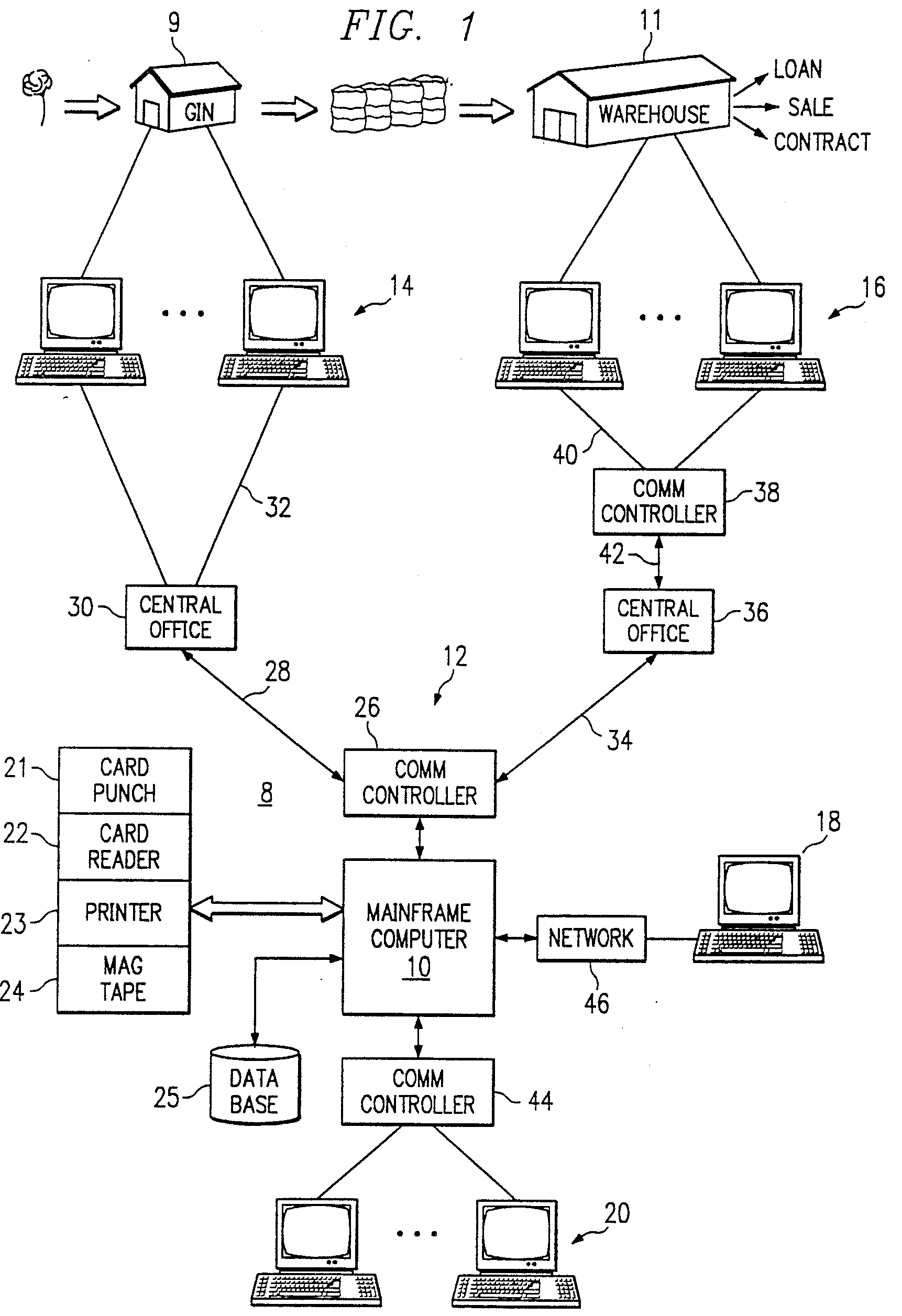
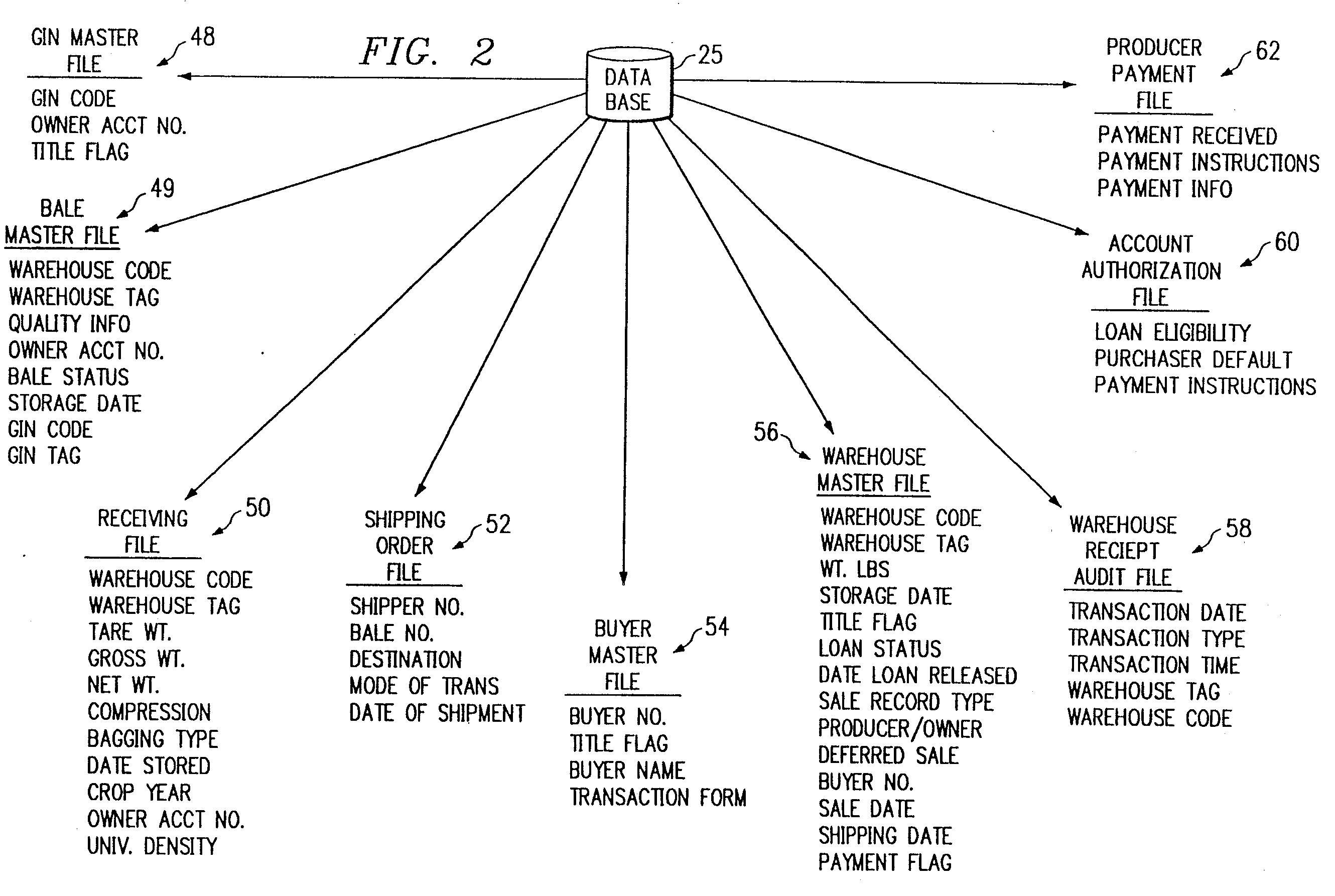
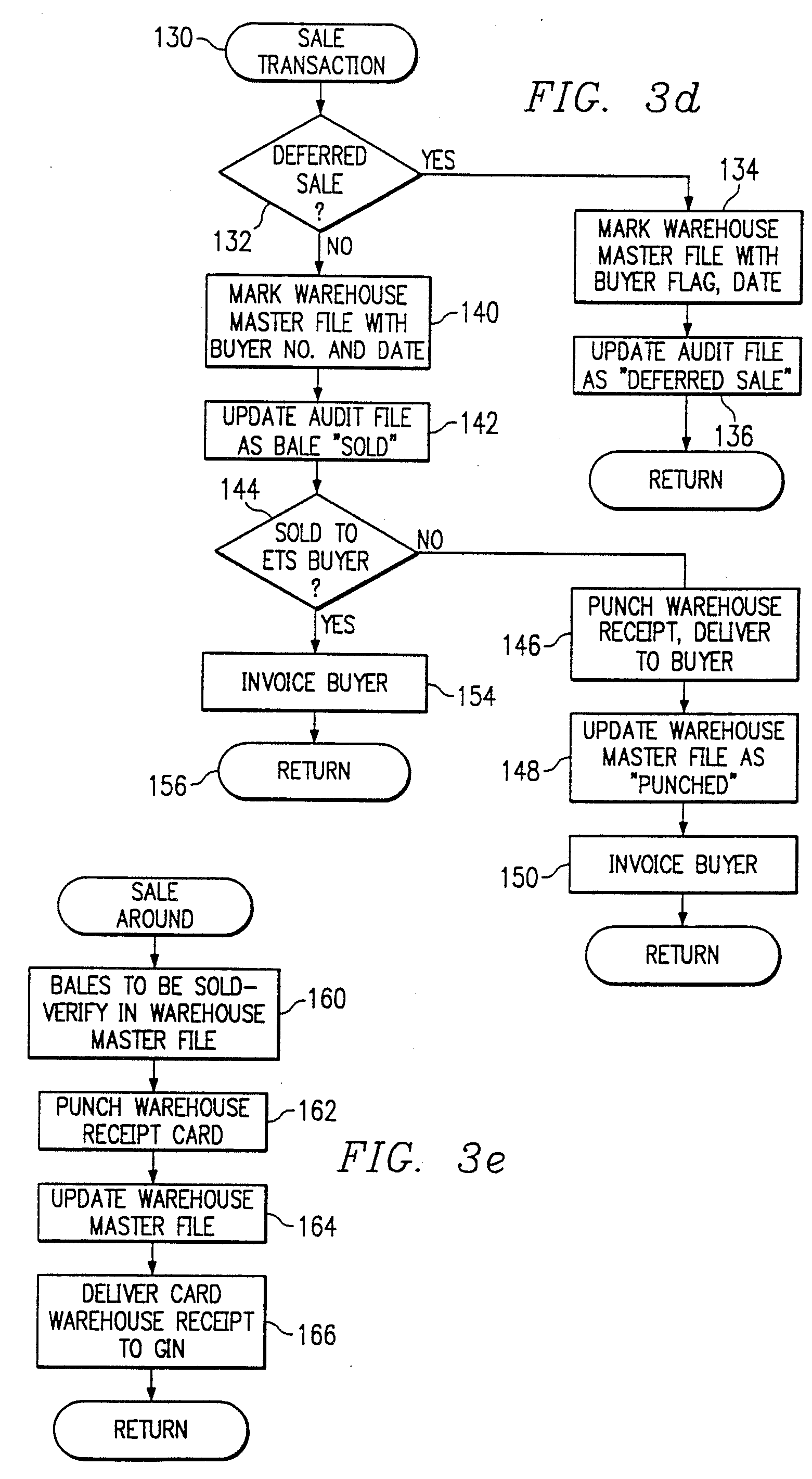
5,063,507 refers to:
- 4,115,870 entitled "Hand-held data
processing terminal" filed on November 18, 1976;
- 4,346,442 entitled "Securities
brokerage-cash management system" filed by Merrill Lynch and others on July 29, 1980;
- 4,454,414 entitled "Funds transfer system
using optically coupled, portable modules" filed on June 16, 1982;
- 4,456,790 entitled "Automated hardware
inventory system" filed by Bell labs on February 8, 1982;
- 4,591,705 entitled "Data processing device
for inventory control" filed on July 7, 1983 and whose priority date is March 17, 1983;
- 4,751,640 entitled "Automated investment
system" filed by Citybank on June 14, 1984;
- 4,783,655 entitled "Article monitoring
system with printing capability" filed on March 24, 1986; the priority date of some parts is December 10, 1984;
- 4,819,162 entitled "Time clock system
including scheduling payroll and productivity analysis capability" filed on February 9, 1988 and whose priority date is
May 17, 1985;
- 4,878,771 entitled "Label printer" filed on
June 24, 1988 and whose priority date is May 22, 1986;
- 4,896,791 entitled "Coupon dispensing
system" on November 10, 1988 and whose priority date is January 20, 1987; I repeat here a comment above; the abstract reads
"The system receives an access code unique to the consumer, records product selections made by the consumer, compares the
product selected by the consumer with a preselected quota, and issues a coupon for the product selected by the consumer if
the quota for that consumer is not exceeded;"
- 4,910,676 entitled "Processing system for
managing bi-media investments" filed on March 30, 1987;
- 4,920,488 entitled "Physical inventory
system" filed on June 26, 1989 and whose priority date is December 15, 1987;
- 4,989,144 entitled "Method and system for
identifying and displaying discrepancies in vehicle titles" on March 7, 1989; the priority date of some parts being Jan. 24,
1989.
5,063,507 is referenced by 43 patents including:
- 5,845,265, the aforementioned
patent of MercExchange entitled "Consignment nodes;"
- 5,835,896 entitled "Method and system for
processing and transmitting electronic auction information" filed on March 29, 1996;
- 5,761,661 entitled "Data management system
and method" filed by Sabre on July 14, 1994; this application does not relate to sell but relates to EDIFACT, in which
messages carry the source and destination identifiers;
- 5,758,126 entitled "Customizable
bidirectional EDI translation system" filed by Sterling software on March 19, 1996; also related to EDIFACT; the patent
claims a user interface for submitting EDIFACT requests and receiving EDIFACT answers, said requests comprising purchase
orders.
5,285,383 is entitled "Method for carrying out
transactions of goods using electronic title." It was filed by the Plains Cotton Cooperative
Association (PCCA) on October 15, 1991 and it is a continuation in part of 5,063,507 filed on
September 14, 1990.
The first claim of 5,285,383 reads:
"A method for carrying out computerized trading of goods, comprising the steps of:
- storing in a centralized data base of a computer system information unique to at least one type of goods of a seller,
the goods of the type each being distinct and different from each other and the information stored in the computer provides
distinguishing characteristics of each of the individual goods of the seller;
- in response to a command input into the system by a seller, visually displaying and making available to the seller of the
goods a listing of the goods owned by an owner of the goods;
- receiving an indication by the computer system of the identity of a subset of the listing, the subset defining the goods
desired to be sold by the seller;
- in response to a command input into the system by a buyer, visually displaying to the buyer a screen display of
information that is unique to the goods of the subset identified by the seller as being for sale;
- receiving an indication by the computer system of the identity of one or more of the goods of the subset desired to be
purchased by the buyer;
- preventing by the computer system the one or more goods of the subset identified by the buyer and agreed to be purchased
from being shipped by the owner or made available for purchase by a second buyer to thereby prevent the identified goods from
being sold twice; and
- updating the data base to reflect a buyer ownership of the particular goods purchased by the buyer, said updating of the
data base of new ownership being carried out after payment for the particular goods by the buyer."
5,285,383 does not mention single action but it was almost necessarily the case. To connect a new buyer the PCCA had to (1)
sign a contract, (2) install hardware in the buyer office, (3) modify the network configuration to include the new buyer and
adds the buyer to the buyer database. So the system knew payment and shipping data when the user connected. There was no
motivation to ask said data at checkout. Furthermore a bale of cotton is a bale of cotton. The buyer may buy two bales or a
block of bales but there is no value at using a shopping cart when there is only one sort of item in the shop even in
different quality and particularly when the buyer is a professionnal user.
However the limitation analysis of 5,063,507 also applies to 5,285,383.
5,285,383 refers to:
- 4,115,870 entitled "Hand-held data
processing terminal" filed on November 18, 1976;
- 4,346,442 entitled "Securities
brokerage-cash management system" filed by Merrill Lynch and others on July 29, 1980;
- 4,454,414 entitled "Funds transfer system
using optically coupled, portable modules" filed on June 16, 1982;
- 4,456,790 entitled "Automated hardware
inventory system" filed by Bell labs on February 8, 1982;
- 4,591,705 entitled "Data processing device
for inventory control" filed on July 7, 1983 and whose priority date is March 17, 1983;
- 4,751,640 entitled "Automated investment
system" filed by Citybank on June 14, 1984;
- 4,783,655 entitled "Article monitoring
system with printing capability" filed on March 24, 1986; the priority date of some parts is December 10, 1984;
- 4,799,156 entitled "Interactive market
management system" filed on October 1, 1986; the abstract reads:
The system includes a data base which contains user information. The data base is accessed via a validation procedure to
permit business transactions in an interactive on-line mode between users during interactive business transaction sessions
wherein one party to the transaction is specifically selected by the other party;
- 4,819,162 entitled "Time clock system
including scheduling payroll and productivity analysis capability" filed on February 9, 1988 and whose priority date is
May 17, 1985;
- 4,878,771 entitled "Label printer" filed on
June 24, 1988 and whose priority date is May 22, 1986;
- 4,896,791 entitled "Coupon dispensing
system" on November 10, 1988 and whose priority date is January 20, 1987; I repeat here a comment above; the abstract reads
"The system receives an access code unique to the consumer, records product selections made by the consumer, compares the
product selected by the consumer with a preselected quota, and issues a coupon for the product selected by the consumer if
the quota for that consumer is not exceeded;"
- 4,903,201 entitled "Automated futures
trading exchange" filed on November 3, 1983;
- 4,910,676 entitled "Processing system for
managing bi-media investments" filed on March 30, 1987;
- 4,920,488 entitled "Physical inventory
system" filed on June 26, 1989 and whose priority date is December 15, 1987;
- 4,953,085 entitled "System for the operation
of a financial account" filed on April 15, 1987;
- 4,989,144 entitled "Method and system for
identifying and displaying discrepancies in vehicle titles" on March 7, 1989; the priority date of some parts being Jan. 24,
1989.
5,285,383 is referenced by 44 patents including essentially the same patents as 5,063,507 and:
- 5,794,206 entitled "Method and system for
displaying electronic data interchanges in a computer" filed by Sterling Software on May 6, 1996.
5,550,734 is entitled "Computerized healthcare
accounts receivable purchasing collections securitization and management system." It was filed by The Pharmacy Fund on
December 23, 1993.
The healthcare system is an environment in which:
- users identify first (only authenticated users can order and on hehalf of identified customers),
- there are orders to fulfill,
- one action is practiced.
| Limitation |
5,550,734 |
| under control of a client system (1) | the client
is a pharmacy PC as depicted on FIG. 10 |
| displaying information identifying the item (2) |
"A claim is initiated when an insured claimant takes an eligible prescription to a pharmacy, and the pharmacy enters the
relevant information about the claim into its in-house computer system. FIG. 13. Using one of the commercially available
software packages, as discussed above, the pharmacy then submits the claim electronically to a switch."
"A large number of companies supply several hundred software packages to service providers for such purposes as automatic
inputting and formatting of electronic claims. Although the performance of the competing software systems vary dramatically,
the functions they perform and the formats used to transmit third party pharmacy claims are essentiall identical because all
electronic messages must conform to the standard electronic message format set by the National Council for Prescription Drug
Programs ("NCPDP")
Such programs display the claim object, the prescription. |
| in response to only a single action being performed (3) | depends on the software package |
| sending a request to order the item [...] to a server system (4) | The pharmacy (service provider) submit claims as depicted on FIG. 20 on behalf of claimants. |
| the request including the identifier so that the server system can locate additional
information needed to complete the order and so that the server system can fulfill the generated order to complete purchase
of the item (5) | The claim request contains the prescription number (~item #) and a
claimant ID (identifier). "Any service provider wishing to use CHARMS will subscribe." |
| a data storage medium storing information for a plurality of users (7) |
Service provider database inherent from "any service provider wishing to use CHARMS will
subscribe," service provider portfolios, and interface to the clearing house. See also the pharmacy profile. |
| a receiving component for receiving requests to order an item [...], the request being
sent in response to only a single action being performed (8) | CHARMS (see FIG. 10) |
| a request including an indication of one of the plurality of users (9) |
see explanation for limitation 5 |
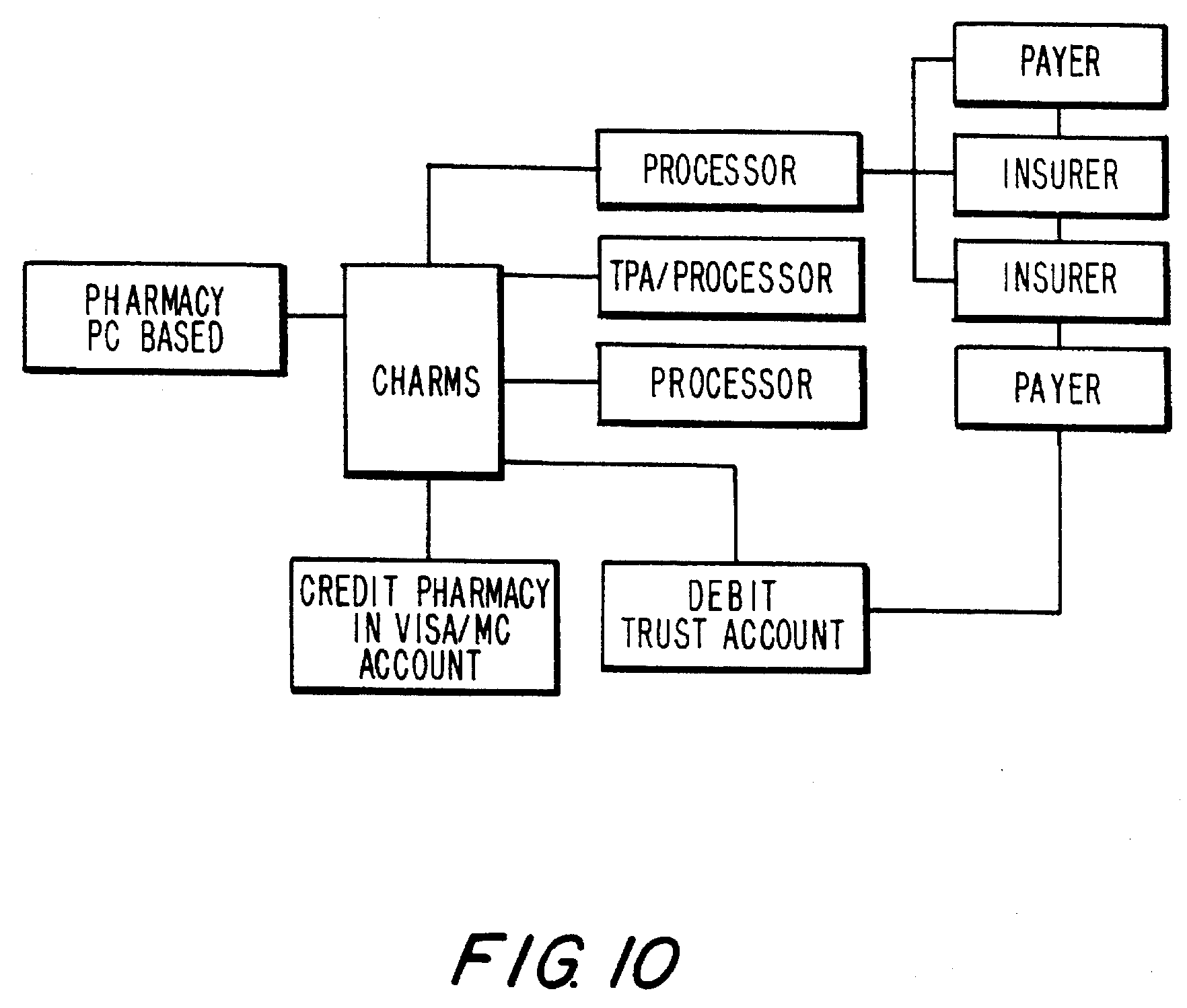
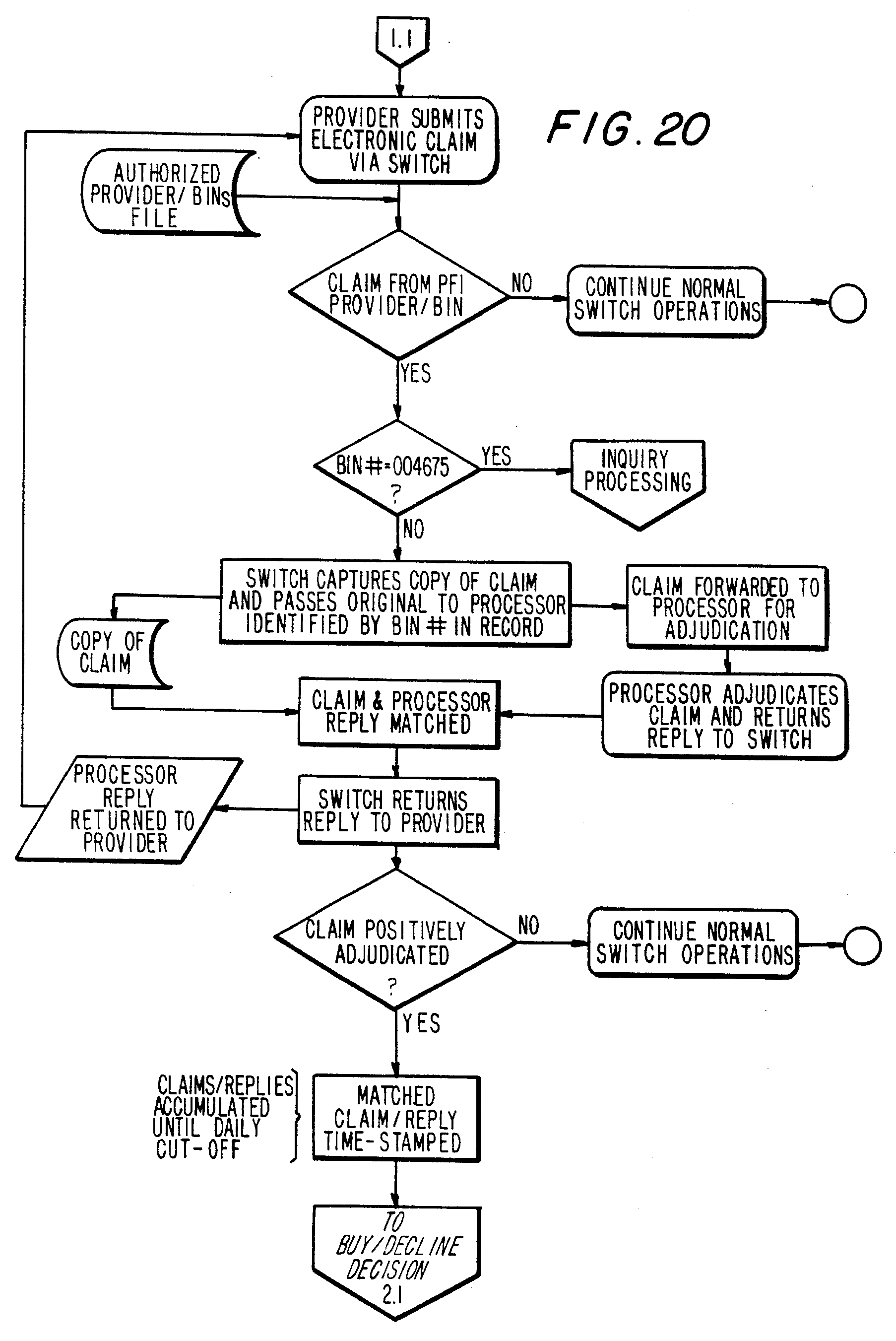 5,550,734 refers to:
5,550,734 refers to:
- 4,858,121 entitled "Medical payment system"
filed on December 12, 1986;
- 5,012,077 entitled "Credit and debit card
processing terminal" filed on September 29, 1988 and whose priority date is October 07, 1987;
- 5,070,452 entitled "Computerized medical
insurance system including means to automatically update member eligibility files at pre-established intervals" filed on
October 17, 1989 and whose priority date is June 30, 1987;
- 5,231,569 entitled "Account transaction
system" filed on June 12, 1990.
5,550,734 is referenced by 19 patents.
5,704,044 is entitled "Computerized healthcare
accounts receivable purchasing, collections, securitization and management system". It was filed on July 31, 1996 and is a
divisional of 5,550,734.
See the analysis of 5,550,734.
5,550,734 refers to:
- 4,858,121 entitled "Medical payment system"
filed on December 12, 1986;
- 5,012,077 entitled "Credit and debit card
processing terminal" filed on September 29, 1988 and whose priority date is October 07, 1987;
- 5,070,452 entitled "Computerized medical
insurance system including means to automatically update member eligibility files at pre-established intervals" filed on
October 17, 1989 and whose priority date is June 30, 1987;
- 5,225,976 entitled "Automated health benefit
processing system" filed on March 12, 1991;
- 5,231,569 entitled "Account transaction
system" filed on June 12, 1990.
- 5,235,507 entitled "Health insurance
management system" filed on January 16, 1990;
- 5,235,702 entitled "Automated posting of
medical insurance claims" filed on April 11, 1990;
- 5,301,105 entitled "All care health management
system" filed on April 8, 1991;
- 5,519,607 entitled "Automated health benefit
processing system" filed on July 6, 1993, the priority date of some parts being Mar. 12, 1991.
5,550,734 is referenced by 12 patents.
5,920,696 is entitled "Dynamic windowing system
in a transaction base network for a client to request transactions of transient programs at a server." It was filed by IBM on
February 25, 1997.
The subject matter of 5,920,696 does not relate to online sale as we can see on FIG. 4b.
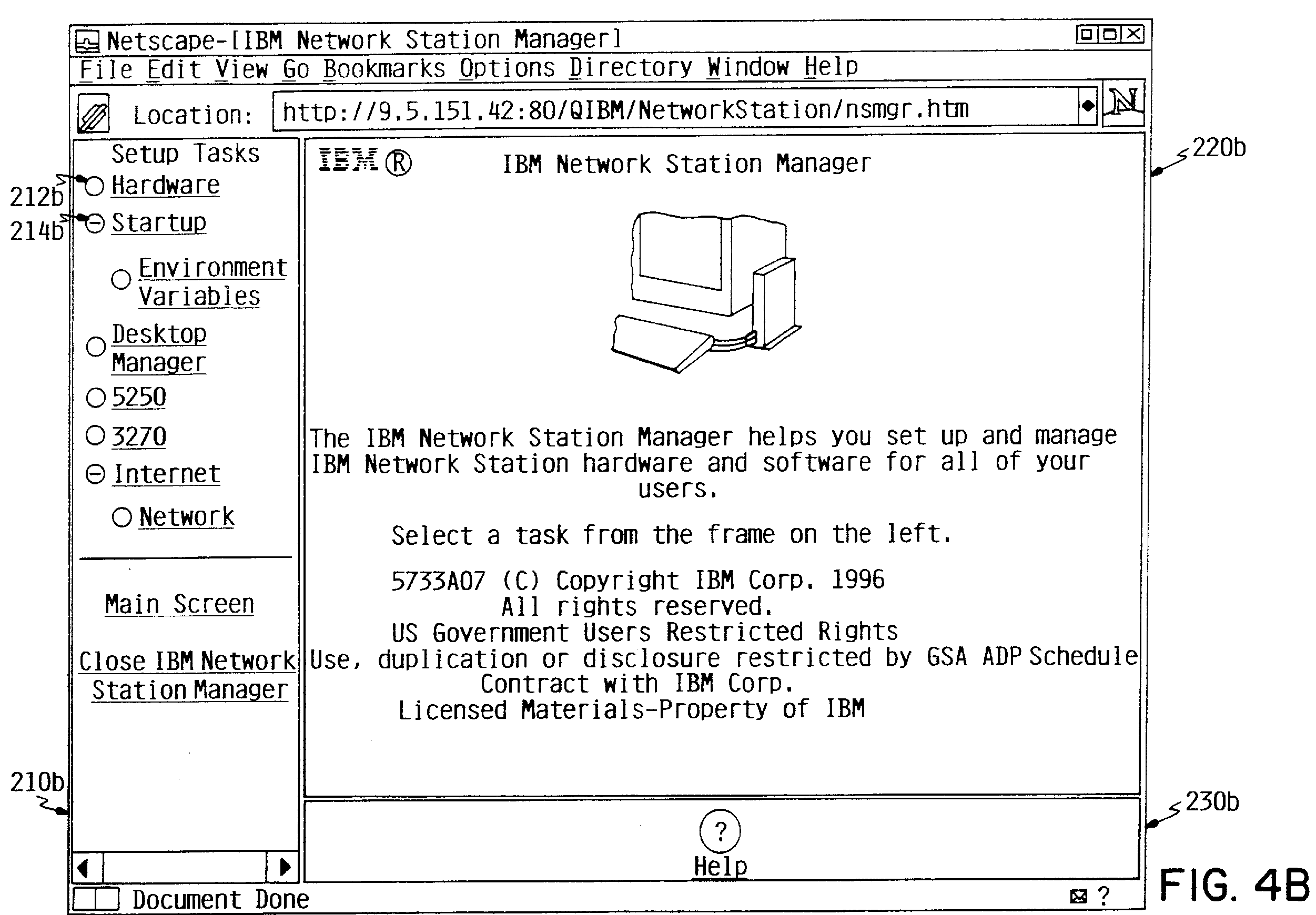
Nevertheless 5,920,696 addresses a similar problem teaching an enhanced document browsing method and apparatus for
requesting transactions of transient programs at a server, that sends a first transaction to a server that requests first data
from a first transient program; receives the first data from the server; inserts the first data into an entry field; and
requests a second transaction from a second transient program by sending the first data to the server.
The drawback of prior art is "The user may request one piece of information from the server in a first transaction in order
to re-enter the data in a request for a second transaction from the user." Re-entering data is what bars single action.
| Limitation |
5,920,696 |
| under control of a client system (1) | "A
method at a client for requesting transactions of transient programs at a server" [claim 1] |
| displaying information identifying the item (2) |
When the selected page is displayed on display device 106, the user of client computer 100 can appropriately manipulate input
device 104 to position the cursor of display device 106 over a desired item of information on which the user desires additional
information, and then select the item with means well-known in the art, for example, by "clicking" a mouse button. |
| in response to only a single action being performed (3) | single-action transactions |
| sending a request to order the item [...] to a server system (4) | When the item is "clicked", an HTML form can be invoked. When a form is invoked, a CGI program on server computer
150 creates the form, using a template, and the form is sent from server computer 150 to client computer 100 |
| the request including the identifier so that the server system can locate additional
information needed to complete the order and so that the server system can fulfill the generated order to complete purchase of
the item (5) |
"A method at a client for requesting transactions of transient programs at a server, comprising [...] displaying a logon screen"
[claim 1]
"The method of claim 1, further comprising [...] validating a user-id and password in response to the interpreting step,
wherein a user enters the user-id and password in the logon screen" [claim 2]
"The method of claim 2, further comprising:
receiving a main document from the server, wherein the main document contains hidden variables." [claim 3]
"The method of claim 3, wherein the hidden variables in the main document comprise the user-id." [claim 4]
Then the invention teaches how hidden variables are sent in each request:
"Script function 322 copies required hidden variables 392 and optional hidden variables 394 from main document 390 to global variables 320. Script function 322 also saves a variable in global variables 320 that determines which help file to use (context-sensitive help) and saves if the user is an administrator or not. At block 607, processing for administrative and nonadministrative users is done, as is further described under the description for FIG. 8, below. At block 610, the user selects startup task using startup control-object 212 in task-frame 210. This invokes script function 322, which copies hidden variables in global variables 320 from network-station-manager document 300 to the form to be submitted. It also sets new hidden variables in main document 390 for the client that is being requested into the form. At block 620, browser 120 sends the form to server 150, which invokes scope-CGI 329, which copies hidden variables from the submitted form into hidden variables 327 in scope document 326 at block 625."
This design does not use cookies (files stored in a browser directory.) The fact is that in case of URL rewritting the URLs is
stored in a history filed also stored in a browser-controlled directory. Hidden fields are stored in HTML pages that are stored
in a browser-controlled cache directory. And the user has the option to disable cookies, history and caching. |
| a data storage medium storing information for a plurality of users (7) |
user database |
| a receiving component for receiving requests to order an item [...], the request being
sent in response to only a single action being performed (8) | see analysis for limitation
4 |
| a request including an indication of one of the plurality of users (8) |
see analysis for limitation 5 |
5,920,696 refers to:
- 5,572,643 entitled "Web browser with dynamic
display of information objects during linking" filed on October 19, 1995;
- 5,737,619 entitled "World wide web browsing
with content delivery over an idle connection and interstitial content display" filed on September 9, 1996;
- 5,754,857 entitled "Distributed asynchronous
workflow on the net" filed by Sun Microsystems on December 8, 1995;
- 5,754,857 entitled "Secure platform
independent cross-platform remote execution computer system and method" filed on July 23, 1996.
5,920,696 is referenced by 14 patents.
6,108,673 is entitled "System for creating a
form from a template that includes replication block." It was filed by IBM on February 25, 1997.
See the analysis of 5,920,696.
6,108,673 refers to:
- 5,444,841 entitled "Graphical user interface
control for replicating data fields in forms" filed by IBM on April 26, 1994 and whose priority date is November 8, 1991;
- 5,461,710 entitled "Method for providing a
readily distinguishable template and means of duplication thereof in a computer system graphical user interface" filed by IBM
on August 15, 1994 and whose priority date is March 20, 1992;
- 5,704,029 entitled "System and method for
completing an electronic form" filed on May 23, 1994.
6,108,673 is referenced by 5 patents.
5,457,797 is entitled "Flexible multi-platform
partitioning for computer applications." It was filed by Forte on March 22, 1995 and its
priority date is August 3, 1993.
| Limitation |
5,457,797 |
| under control of a client system (1) | client/server
partitioning |
| displaying information identifying the item (2) |
See catalog on FIG. 15 and "the buyer would point-and-click on the model he wanted." |
| in response to only a single action being performed (3) | "As with most order/entry systems, the application would first qualify the buyer, accessing available services to check credit ratings and possibly bank balances and employment status. The buyer would point-and-click on the model he wanted (or he could view multiple models simultaneously, zooming in to view one at a time when desired). He could experiment with different color schemes and detailing options which would be displayed on the screen in full color. The model under consideration could be rotated for viewing from any angle. Exterior options, such as mag wheels, would be displayed as they were selected. The system could provide an interior view for that model's cockpit from the driver's viewpoint. The system would prompt the customer for non-displayable options (engine size, passenger side air bag, extended warrantee), all while maintaining a running total price that could be displayed whenever appropriate. When the specification is complete, the system could check the availability schedule and give the buyer a target delivery date. Then the order could be submitted electronically and managed electronically throughout the manufacturing process and the shipping cycle."
5,457,797 teaches a system in which the user is approved first.
"If the customer wants to buy the security, the broker needs to enter the trade and get immediate confirmation that the trade
was successfully executed at the agreed upon price. Or, if the market has moved higher in the meantime, the broker can then ask
the customer if they want to purchase the security at a higher price. After the trade has been executed, the broker needs to
initiate the processes to bill the customer, update the customer's portfolio listing, and include the trade in the broker's
commission plan." |
| sending a request to order the item [...] to a server system (4) | The first part of the application uses an object broker to call the second part of the application (claims 5 and 6).
The object broker sends messages [requests] (see claims 7 and 8). |
| the request including the identifier so that the server system can locate additional
information needed to complete the order and so that the server system can fulfill the generated order to complete purchase of
the item (5) | In the security example the broker and the customer are identified. Said
identity can be sent in messages or in packets carrying said messages. |
| a data storage medium storing information for a plurality of users (7) |
inherency in security case from the customer portfolio and the broker commission plan |
| a receiving component for receiving requests to order an item [...], the request being sent
in response to only a single action being performed (8) | see analysis for limitation 4 |
| a request including an indication of one of the plurality of users (9) |
see analysis for limitation 5 |
| an order placement component that retrieves from the data storage medium information for
the indicated user (10) | inherency in security case from the customer portfolio and the
broker commission plan |
| uses the retrieved information to place an order for the indicated user for the item (11)
| see the security and order/entry examples |
| fulfilling the generated order to complete purchase of the item whereby the item is ordered
without using a shopping cart ordering model (12) | see the security and order/entry examples
|
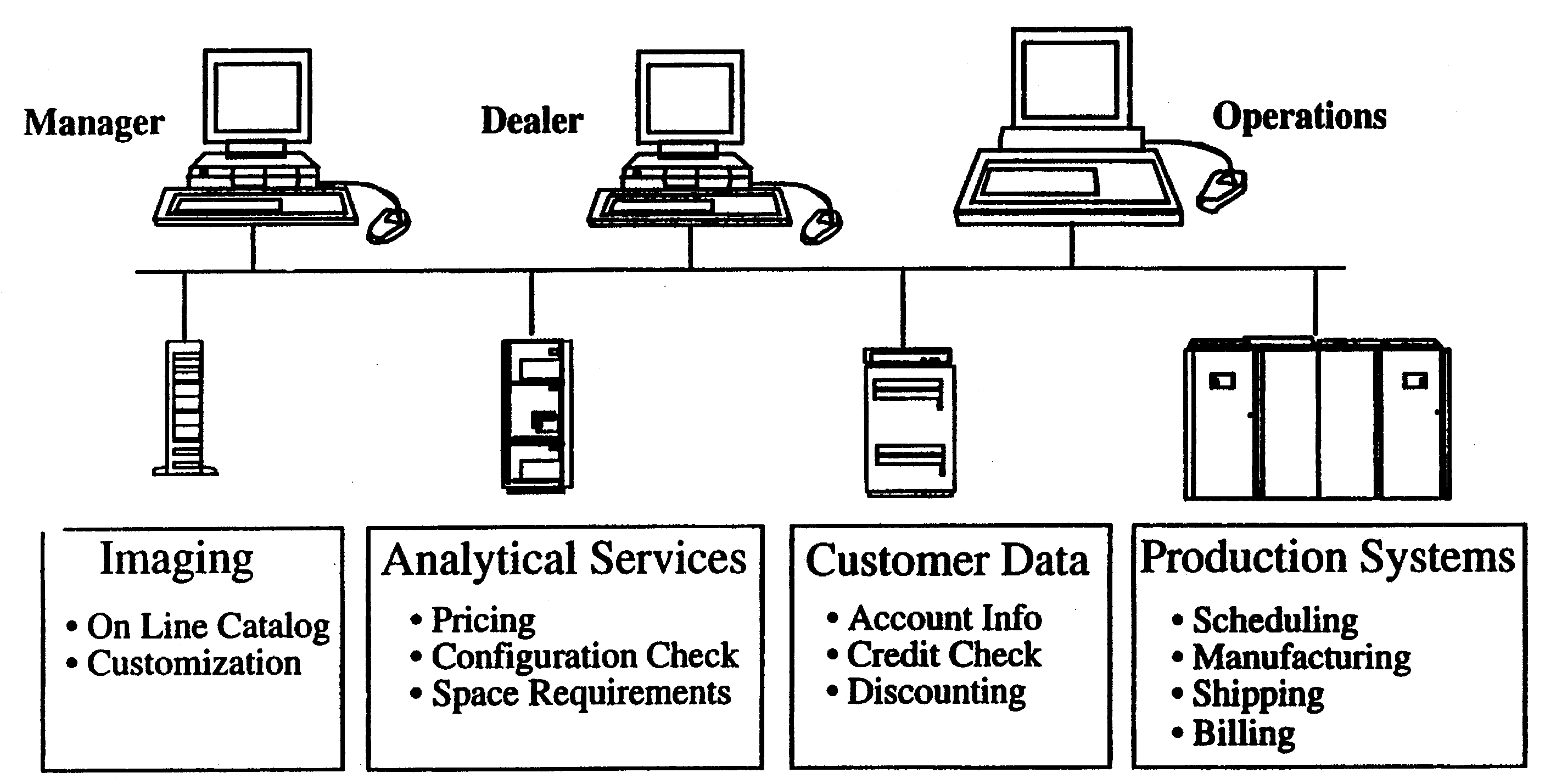
5,457,797 refers to
- 4,742,467 entitled "Automated programming
system for machine creation of applications program source code from non-procedural terminal input" filed on October 9, 1986
and whose priority date is May 4, 1984;
- 5,056,000 entitled "Synchronized parallel
processing with shared memory" filed on November 7, 1989 and whose priority date is June 21, 1988;
- 5,261,095 entitled "Partitioning software
in a multiprocessor system" filed by Texas Instruments on October 11, 1989;
- 5,295,222 entitled "Computer-aided software
engineering facility" filed on May 18, 1992 and whose priority date is November 30, 1989;
- GB2242293 entitled "Apparatus and method
for dynamic linking of computer software components" filed by Apple on January 5, 1990.
This prior art does not relate to 1-click.
5,457,797 is referenced by 150 patents, including:
- 5,734,828 entitled "System for
accessing/delivering on-line/information services via individualized environments using streamlined application sharing host
and client services" filed by Intel on August 30, 1995;
- 5,790,789 entitled "Method and architecture
for the creation, control and deployment of services within a distributed computer environment" filed on August 2, 1996;
- 5,897,635 entitled "Single access to common
user/application information" filed by IBM on June 7, 1995; not related to 1-click; I list it because it relates to
Single Sign On (SSO), which was a hot subject by 1997; SSO implied
that an identifier was assigned by an SSO server, returned to the client and then sent to the applications.
Kerberos popularized the concept.
SPNEGO and
SPNEGO-HTTP allow using Kerberos and other mechanisms between browsers and HTTP servers but they came too late.
5,339,392 is entitled "Apparatus and method for
creation of a user definable video displayed document showing changes in real time data." It was filed on December 28, 1990.
This is a continuation-in-part application of a prior co-pending U.S. patent application entitled "APPARATUS AND METHOD FOR
PROVIDING DECOUPLING OF DATA EXCHANGE DETAILS AND PROVIDING HIGH PERFORMANCE COMMUNICATION BETWEEN SOFTWARE PROCESSES", Ser. No.
07/632,551, filed Dec. 21, 1990, which was a continuation-in-part of a prior co-pending U.S. patent application entitled
"APPARATUS AND METHOD FOR PROVIDING DECOUPLING OF DATA EXCHANGE DETAILS AND PROVIDING HIGH PERFORMANCE COMMUNICATION BETWEEN
SOFTWARE PROCESSES", Ser. No. 07/601,117, filed Oct. 22, 1990, now U.S. Pat. No.
5,257,369, which was a continuation-in-part of a
prior co-pending U.S. patent application entitled "APPARATUS AND METHOD FOR PROVIDING DECOUPLING OF DATA EXCHANGE DETAILS
AND PROVIDING HIGH PERFORMANCE COMMUNICATION BETWEEN SOFTWARE PROCESSES", Ser. No. 07/386,584, filed Jul. 27, 1989, now U.S.
Pat. No. 5,187,787. So the priority date of some
parts is July 27, 1989. There is no assignee but Jeffrey Risberg was a manager of
TIBCO and its predecessors.
This is an interesting patent that anticipates in some ways COM/ActiveX and applets.
| Limitation |
5,339,392 |
| under control of a client system (1) | "An apparatus
and method according to the teachings of the invention provides a computer facility (hereafter the application or program)
whereby a user, using a collection of layout tools may define an active document. "Active document" as that term is used herein
means a video displayed document of one or more "sheets"."
"The program automatically accesses the network to which the host is connected through network interface software which
establishes the proper subscriptions for the desired real time data with the appropriate information service and the server upon
which this service process is running." |
| displaying information identifying the item (2) |
FIG. 14 shows how items are found and FIG. 1 how items are displayed. |
| in response to only a single action being performed (3) | "The Event Trigger is a specification of conditions under which the user wishes to do extra processing on the Active Object. For example, the user can set alarm limits such as a certain price or trading volume for a particular quote Active Object, and when a real time data update indicates that the limit has been exceeded, an alarm condition exists to transfer the Active Object from the normal update state to the alert state. The Event Script of commands to execute upon occurrence of the specified alarm condition is specified in the Event Script specifications shown generally at 110. The things that can be scripted to happen upon occurrence of an alarm condition are limited only by the imagination of the user. Minimally, the script may specify an audible beep and/or a change in color of an Active Object. More exotic scripts may issue commands on the network to start another process running to dial a beeper, issue a sell order, issue a buy order."
In a way this paragraph teaches 0-click. However a click is an event: "means coupled to one or more of said button active
objects for causing to occur a specific user defined sequence of events associated with each button active object when the
corresponding button active is selected" [claim 24]. So the system also teaches 1-click to issue a sell or a buy order.
|
| sending a request to order the item [...] to a server system (4) | The specification teaches us that the system can (1) issue buy orders (2) "a real time data acquisition and
composition program in execution on said computer and coupled to said communication software for receiving user requests to
display one or more specific items of said real time data and for requesting said communication software to create a communication
channel across said data path for each of said one or more items of specified items of real time data through which a stream of
the user requested data may flow back to said acquisition and composition program for each specified item of said real time data,
and for receiving said one or more streams of said changeable real time data" [claim 5]. |
| the request including the identifier so that the server system can locate additional
information needed to complete the order and so that the server system can fulfill the generated order to complete purchase of the
item (5) | Inherency. Nothing is taught about means to authenticate to data sources nor to
means to authenticate users. Nevertheless these data sources necessarily require authentications and the system is centered on the
user that necessarily needs to authenticate in order to setup her source accounts and keep her in-depth display customization. |
| a receiving component for receiving requests to order an item [...], the request being sent
in response to only a single action being performed (8) | See analysis for limitation 4 |
| a request including an indication of one of the plurality of users (9) |
See analysis for limitation 5 |
| fulfilling the generated order to complete purchase of the item whereby the item is ordered
without using a shopping cart ordering model (12) | inherent |
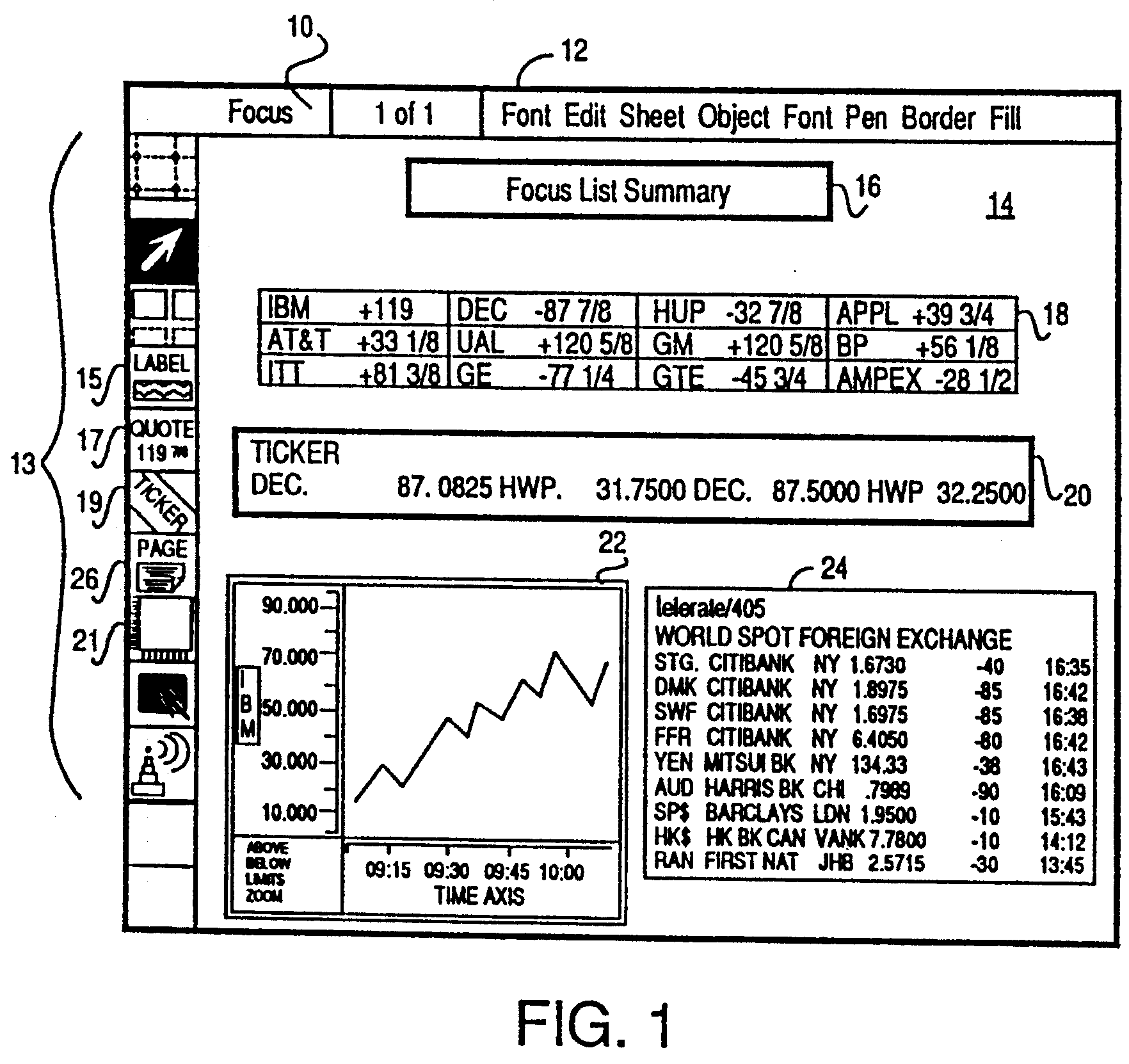
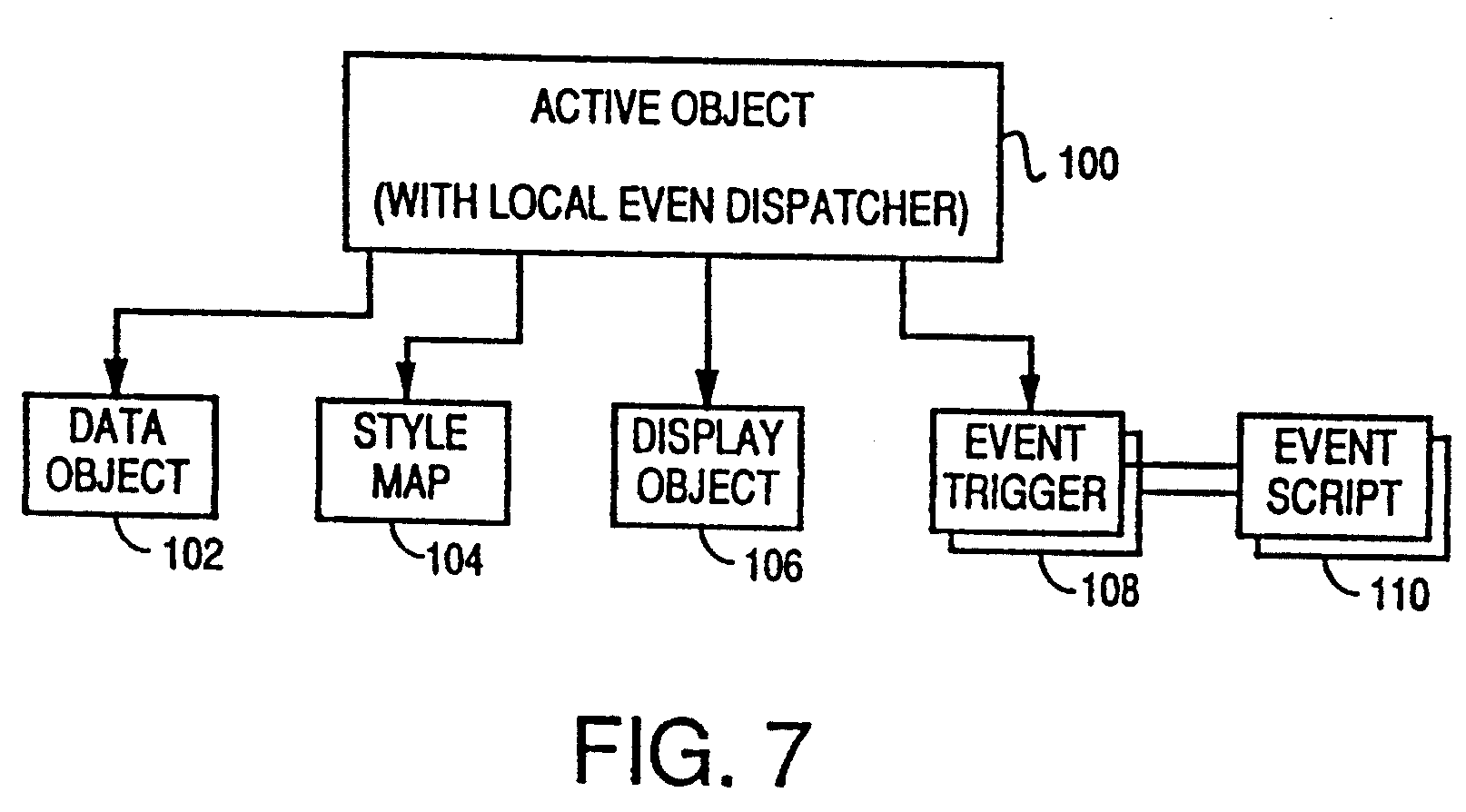
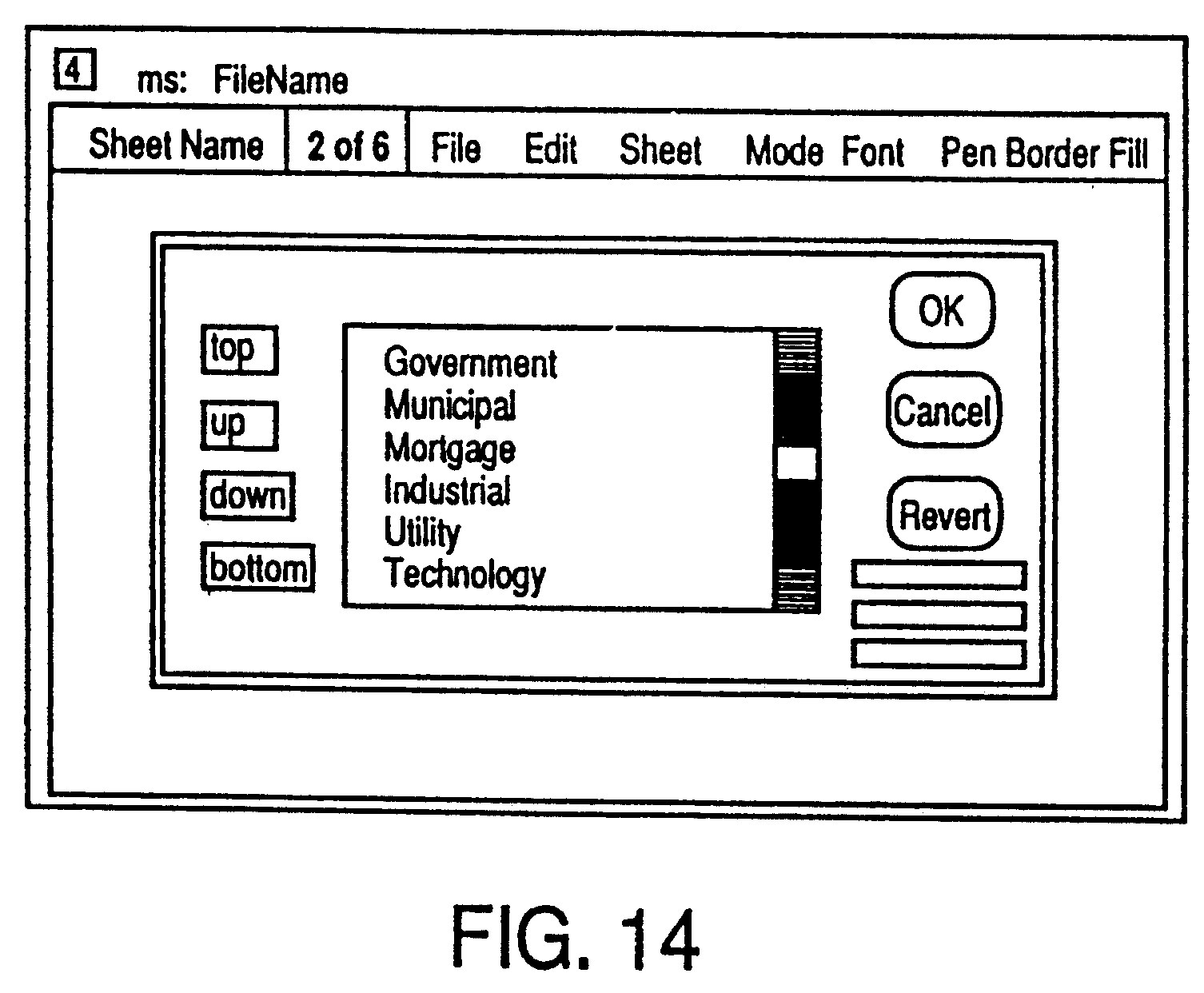
5,339,392 refers to:
- 4,486,853 entitled "Apparatus for receiving
and displaying continuously updated data" filed on April 1, 1981;
- 4,642,790 entitled "Presentation space
management and viewporting on a multifunction virtual terminal" filed by IBM on March 14, 1984;
- 4,750,135 entitled "Method for dynamically
creating a receiver definable local trading instrument displayable record from a remotely transmitted trading instrument
common data stream" filed by Reuters on May 1, 1986;
- 4,845,645 entitled "Sequential rapid
communication visual displays" filed by USA on August 28, 1987;
- 4,868,866 entitled "Broadcast data
distribution system" filed by McGraw-Hill on February 18, 1988;
- 4,901,221 entitled "Graphical system for
modelling a process and associated method" filed on April 14, 1986;
- 4,914,568 entitled "Graphical system for
modelling a process and associated method" filed on October 24, 1986;
- 4,914,587 entitled "Financial data
processing system with distributed data input devices and method of use" filed on August 7, 1987;
- 4,943,866 entitled "Video composition method
and apparatus employing smooth scrolling" filed on June 16, 1989;
- 5,058,185 entitled "Object management and
delivery system having multiple object-resolution capability" filed by IBM on June 27, 1988;
- 5,126,936 entitled "Goal-directed financial
asset management system" filed on September 1, 1989.
5,339,392 is referenced by 203 patents, including:
- 5,890,175 entitled "Dynamic generation
and display of catalogs" filed on September 25, 1996;
- 6,195,647 entitled "On-line transaction
processing system for security trading" filed by the Nasdaq on September 26, 1996.
5,283,734 is entitled "System and method of
communication with authenticated wagering participation." It was filed on September 19, 1991.
| Limitation |
5,283,734 |
| under control of a client system (1) | "At each
of a plurality of remote receiving stations, one or more members of a remote audience has the opportunity to respond to a
situation presented in the television program" [abstract] |
| displaying information identifying the item (2) |
"The second signal of the first group is a signal transmission setting forth a task, such as the answering of one or more
questions which may be viewed on a television screen and/or listened to over radio or the audio portion of the television
transmission." |
| in response to only a single action being performed (3) | "the answers are indicated by use of a keyboard with electronic circuitry" |
| sending a request to order the item [...] to a server system (4) |
"In accordance with the invention, there is provided a central data storage facility in
which all player responses and, when desired, the winning response(s) are stored. Player entries can be authenticated
electronically prior to storage at the central facility, and are transmitted either electronically (as by two-way cable, or
by modem over a telephone line) from remote sites of players to the central facility" |
| the request including the identifier so that the server system can locate additional
information needed to complete the order and so that the server system can fulfill the generated order to complete purchase
of the item (5) | "In accordance with the invention, there is provided a central data
storage facility in which all player responses and, when desired, the winning response(s) are stored. Player entries can be
authenticated electronically prior to storage at the central facility, and are transmitted either electronically (as by
two-way cable, or by modem over a telephone line) from remote sites of players to the central facility" and "Authentication
is accomplished by comparing numbers or names assigned to players, including serial numbers of player entry devices, with
reference data previously stored in the central facility" |
| a data storage medium storing information for a plurality of users (7) |
"Authentication is accomplished by comparing numbers or names assigned to players,
including serial numbers of player entry devices, with reference data previously stored in the central facility" |
| a receiving component for receiving requests to order an item [...], the request being
sent in response to only a single action being performed (8) | central facility |
| a request including an indication of one of the plurality of users (9) |
"Player entries can be authenticated electronically prior to storage at the central
facility" |
| an order placement component that retrieves from the data storage medium information
for the indicated user (10) | inherent from FIG. 24 and "A central telephone facility
702 connects via a communication link 704 with a telephone subscriber's station 706 (typically the subscriber's home) and to
the subscriber bank 708 or other financial institution, by way of example. Via line 710, the subscriber can authorize the
central facility 702 to charge the subscriber's account at the bank 708. A response unit 210 (shown in FIGS. 6 and 8) is
located at the subscriber station 706. A central broadcast and monitoring facility 712 provides a broadcast presentation 714
with a broadcast signal transmitted to the subscriber station 706 to be observed by the subscriber. The subscriber responds
to the broadcast transmission by entering a response in the response unit 210." |
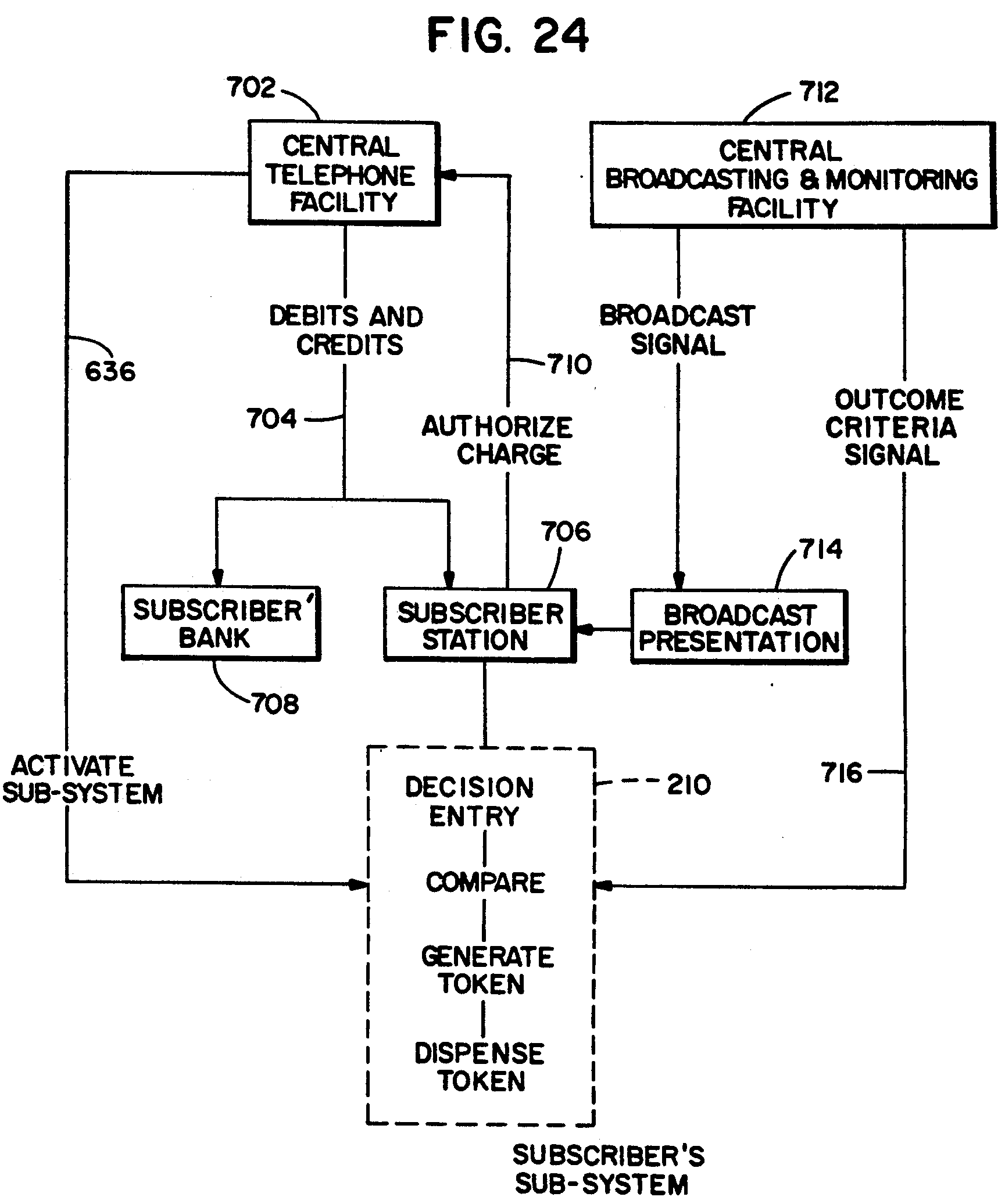
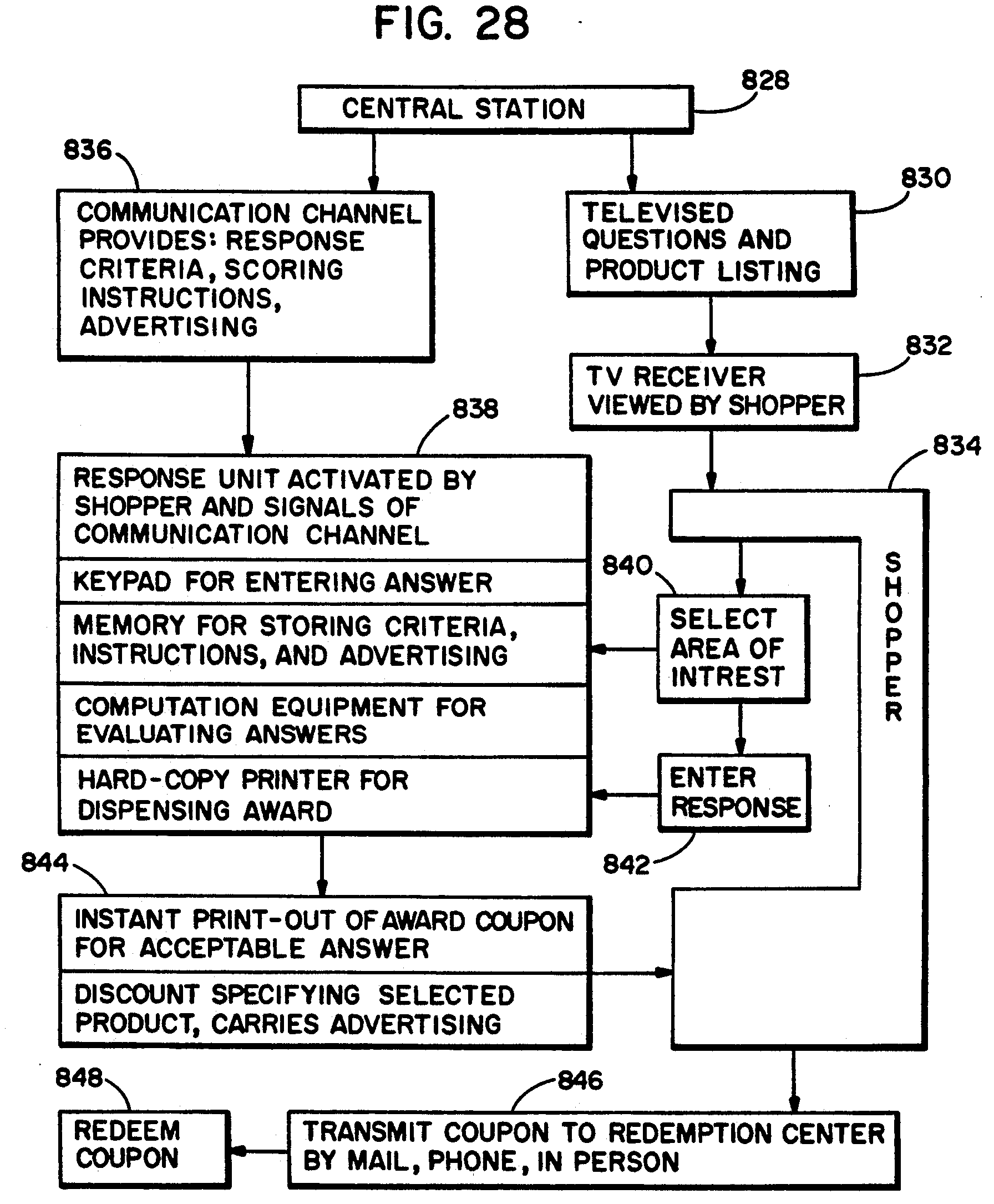 5,283,734 refers to:
5,283,734 refers to:
- 3095653;
- 3546791;
- 3599221;
- 3606688;
- 3671668;
- 3810627;
- 3848082;
- 3910322;
- 3964179 entitled "Telephone system teaching
apparatus" filed on November 7, 1974;
- 3993861;
- 3999307 entitled "Teaching machine" filed by
Hitachi on August 6, 1971 and whose priority date is August 07, 1970;
- 4044380 entitled "Encoder and constructed
answer system for television" filed by Westinghouse Electric on June 27, 1975, the priority date of some parts being December
17, 1973;
- 4052798 entitled "Audio-visual teaching
system" filed by Sony on April 2, 1976 and whose priority date is April 08, 1975;
- 4141548 entitled "Game apparatus for use in
conjunction with the viewing of a spectator's sport" filed on January 16, 1978;
- 4264924 entitled "Dedicated channel
interactive cable television system" filed on August 13, 1979, the priority date of some parts being March 3, 1978;
- 4268744 entitled "Score processing system
for use with ID cards" filed on December 5, 1979;
- 4271351 entitled "Cash replacement system
and components" filed on August 17, 1979;
- 4329684 entitled "Apparatus using a light
sensing system for sensing time modulated information from a light emitting device" filed by the BBC on January 15, 1980 and
whose priority date is Jan 16, 1979;
- 4339798 entitled "Remote gaming system filed
on December 17, 1979;
- 4377870 entitled "Electronic audience
polling system" filed by General Electric on December 21, 1978;
- 4388008 entitled "Automatic paper feeder"
filed on February 23, 1981;
- 4494197 entitled "Automatic lottery system"
filed on February 22, 1984 and whose priority date is December 11, 1980;
- 4541806 entitled "Multiple aptitude testing
device" filed on September 10, 1982;
- 4573072 entitled "Method for expanding
interactive CATV displayable choices for a given channel capacity" filed on March 21, 1984;
- 4592546 entitled "Game of skill playable by
remote participants in conjunction with a live event" filed on April 26, 1984;
- 4593904 entitled "Player interactive video
gaming device" filed on March 19, 1984;
- 4608601 entitled "Video response testing
apparatus" filed on July 11, 1983 and whose priority date is July 12, 1982;
- 4611996 entitled "Teaching machine" filed on
July 18, 1985 and whose priority date is August 1, 1983;
- 4614342 entitled "Electronic game machine
suitable for chance and gambling card games" filed on November 7, 1984 and whose priority date is April 19, 1984;
- 4630040 entitled "Variable color
electrooptic display" filed by Motorola on March 31, 1983;
- 4671772 entitled "Performance appraisal and
training system and method of utilizing same" filed on October 22, 1985;
- 4689742 entitled "Automatic lottery system"
filed on May 5, 1986, the priority being Feb. 9, 1983 and for some parts December 12, 1980;
- 4745468 entitled "System for evaluation and
recording of responses to broadcast transmissions" filed on March 10, 1986;
- 4760527 entitled "System for interactively
playing poker with a plurality of players" filed on June 5, 1986 and whose priority date is April 5, 1983;
- 4807031 entitled "Interactive video method
and apparatus" filed on October 20, 1987;
- 4833710 entitled "Pay television system"
filed by Matsushita on December 3, 1987 and whose priority date is February 15, 1984;
- 4842278 entitled "Hierarchical lottery
network with selection from differentiated playing pools" filed on June 10, 1988 and whose priority date is June 2, 1986;
- 4856787 entitled "Concurrent game network"
filed on May 3, 1988 and whose priority date is February 5, 1986;
- 4875164 entitled "Processing system for a
gambling game" filed on June 24, 1986 and whose priority date is October 25, 1984;
- 4876592 entitled "System for merchandising
and the evaluation of responses to broadcast transmissions" filed on May 10, 1988, the priority date of some parts being
March 10, 1986;
- 4907079 entitled "System for monitoring and
control of home entertainment electronic devices" filed on September 28, 1987;
- 4922522 entitled "Telecommunications access
to lottery systems" filed by ATT on June 7, 1988;
- 4926255 entitled "System for evaluation of
response to broadcast transmissions" filed on May 10, 1988, the priority date od some parts being March 10, 1986;
- 4937853 entitled "Lottery agent data
communication/telephone line interface" filed on May 3, 1989;
- 4959783 entitled "System and method for
choosing random numbers and delivering such numbers to subscribers for playing games of chance" filed on April 6, 1989;
- 5034807 entitled "System for evaluation and
rewarding of responses and predictions" filed on October 19, 1989, the priority date of some parts being Mar. 10, 1986;
- 5048833 entitled "Apparatus for detecting a
series of game outcomes" filed on March 1, 1990;
- 5069453 entitled "Ticket apparatus with a
transmitter" filed on June 8, 1990, the priority date of some parts being January 5, 1990;
- 5083272 entitled "Interactive telephone
lottery system with a verification code" filed on November 2, 1988;
- 5119295 entitled "Centralized lottery system
for remote monitoring or operations and status data from lottery terminals including detection of malfunction and
counterfeit units" on February 27, 1991, the priority date of some parts being Jan. 25, 1990;
- 5159549 entitled "Multiple player
game data processing system with wager accounting" on April 16, 1987 and whose priority date is June 1, 1984;
- CA1172847 entitled "CONTROL MICRO-DIDACTOMETRE"
filed on September 29, 1980 [not relevant for 1-click;]
- GB1287304 entitled "EDUCATIONAL TELEVISION
SYSTEMS" filed on November 24, 1969 [not relevant for 1-click;]
- GB2120507 entitled "Interactive video game
arrangement" filed on May 10, 1982.
5,283,734 is referenced by 92 patents including:
- 6,186,893 entitled "Slot machine advertising/sales
system and method" filed on December 18, 1996; I suspect that the first inventor, Jay Walker, is the person who later founded
Priceline.
5,227,874 is entitled "Method for measuring the
effectiveness of stimuli on decisions of shoppers" and was filed on October 15, 1991. The priority date of some parts is March 10, 1986.
The inventor of 5,227,874, Henry Von Kohorn, is the same as for 5,283,734. However the two patents are not related. Von Kohorn is
probably an independent inventor. Note that the question
we aim to answer here is whether said patent may anticipate claims that are not Internet-scope and not whether Internet coupon
systems infringe Von Kohorn patents. This is not to say that both issues are not related.
If you decide that Internet is an important aspect, then you need to grant a patent to the first person to conceive a system
or method using Internet for doing something that was previously made by hand or in another technology (client/server, time sharing,
interactive TV...) If on the other hand we consider that Internet defines a modus operandi inventions that use Internet and said
modus operandi to implement something previously practiced (in a somewhat different way because the modus operandi was different)
by hand or in another technology (client/server, time sharing, interactive TV...) are not patentable.
The reasonable answer is between the two extremes.
| Limitation |
5,729,594 |
| under control of a client system (1) | "providing
at household locations means identified with a household and activatable by a member of said household for generating and
dispensing monetary coupons" [claim 6] and "providing individual shoppers with a dispenser activatable by a shopper and
traceable to said shopper, said dispenser being programmable by electronic signals transmitted from a central location." |
| displaying information identifying the item (2) |
"exposing a plurality of individually identifiable shoppers to an identifiable stimulus intended to prompt a shopper's decision
to purchase an identified product" [claim 1] |
| in response to only a single action being performed (3) | "following exposure of a shopper to said stimulus and upon the activating by a shopper, dispensing by said
dispenser at a shopper's location" [claim 1] |
| sending a request to order the item [...] to a server system (4) | "FIG. 18 shows additional equipment [...] for communication of scoring results by a digital communication system
to a central dispenser" |
| "the request including the identifier so that the server system can locate additional
information needed to complete the order and so that the server system can fulfill the generated order to complete purchase
of the item (5) | "exposing a plurality of individually identifiable shoppers to an
identifiable stimulus intended to prompt a shopper's decision to purchase an identified product" [claim 1] and FIG. 18 |
| a receiving component for receiving requests to order an item [...], the request being
sent in response to only a single action being performed (8) | central dispenser |
| a request including an indication of one of the plurality of users (9) |
"exposing a plurality of individually identifiable shoppers to an identifiable stimulus
intended to prompt a shopper's decision to purchase an identified product" [claim 1] |
| uses the retrieved information to place an order for the indicated user for the item
(10) | "FIG. 18 shows additional equipment which may be incorporated in the response
units of FIGS. 11, 12, 14 and 16 for communication of scoring results by a digital communication system to a central
dispenser for a hard-copy output of game results" |
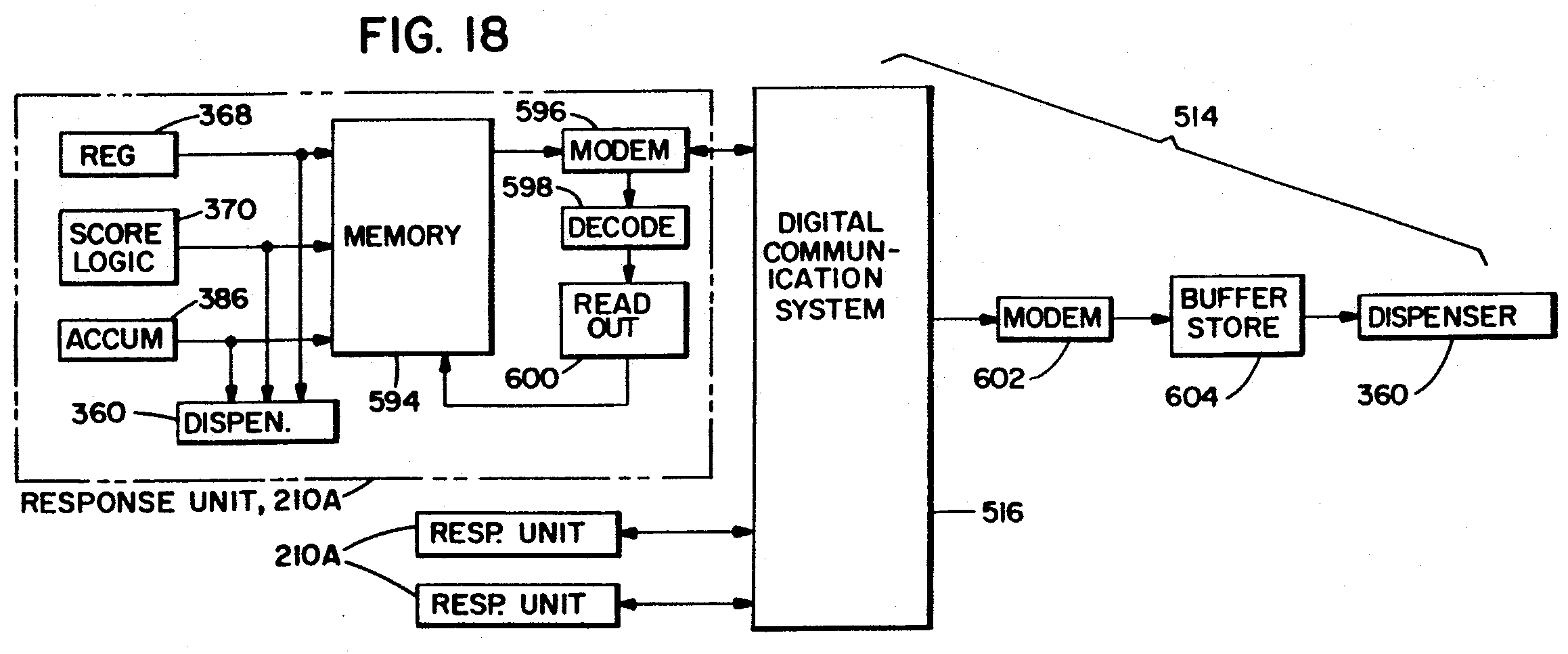
5,227,874 refers to:
- 4,723,212 entitled "Method and apparatus for dispensing
discount coupons" filed on February 27, 1987 and whose priority date is July 18, 1984;
- 4,908,761 entitled "System for identifying heavy product
purchasers who regularly use manufacturers' purchase incentives and predicting consumer promotional behavior response patterns" filed on
September 16, 1988;
- 5,128,520 entitled "Scanner with coupon validation"
filed on August 11, 1989;
- 5,128,752 entitled "System and method for generating and
redeeming tokens" filed on October 25, 1990, the priority date of some parts being March 10, 1986.
5,227,874 is referenced by 137 patents including:
- 5,848,399 entitled "Computer system for allowing a
consumer to purchase packaged goods at home" filed on July 25, 1996 and whose priority date is November 30, 1993. The background is a good
presentation of ante Web online sales. The detailed description reads:
"The consumer may manipulate what is being viewed on the display 71 in order to find, view and purchase goods, by accessing the shopping
service 65 via an input device 70, such as a remote control. The video display generator 58 responds to movements of a cursor on the
display 71, which the consumer can use to move items around on the shelf, examine a product with a close-up view and select a product for
purchase. In response to the consumer input, the video display generator 58 generates a new picture 60, if necessary, as will be described
in more detail below.
Consumer inputs 66 received from the consumer by shopping service 65 are also sent to an order processing and billing system 68 (only for
purchases) and to a research database 67. The order processing and billing system 68 sends ordering information to a warehouse where a
consumer may pick up an order or from which a delivery of an order is sent to the consumer. The research database 67 stores all of a
consumer's actions and is used for analysis and tracking of purchasing behavior. The research database 67 tracks consumer's actions in a
manner which is transparent to the consumer."
The description does not mention checkout or sign-in and a number of figures show that the invention implements a shopping
cart.
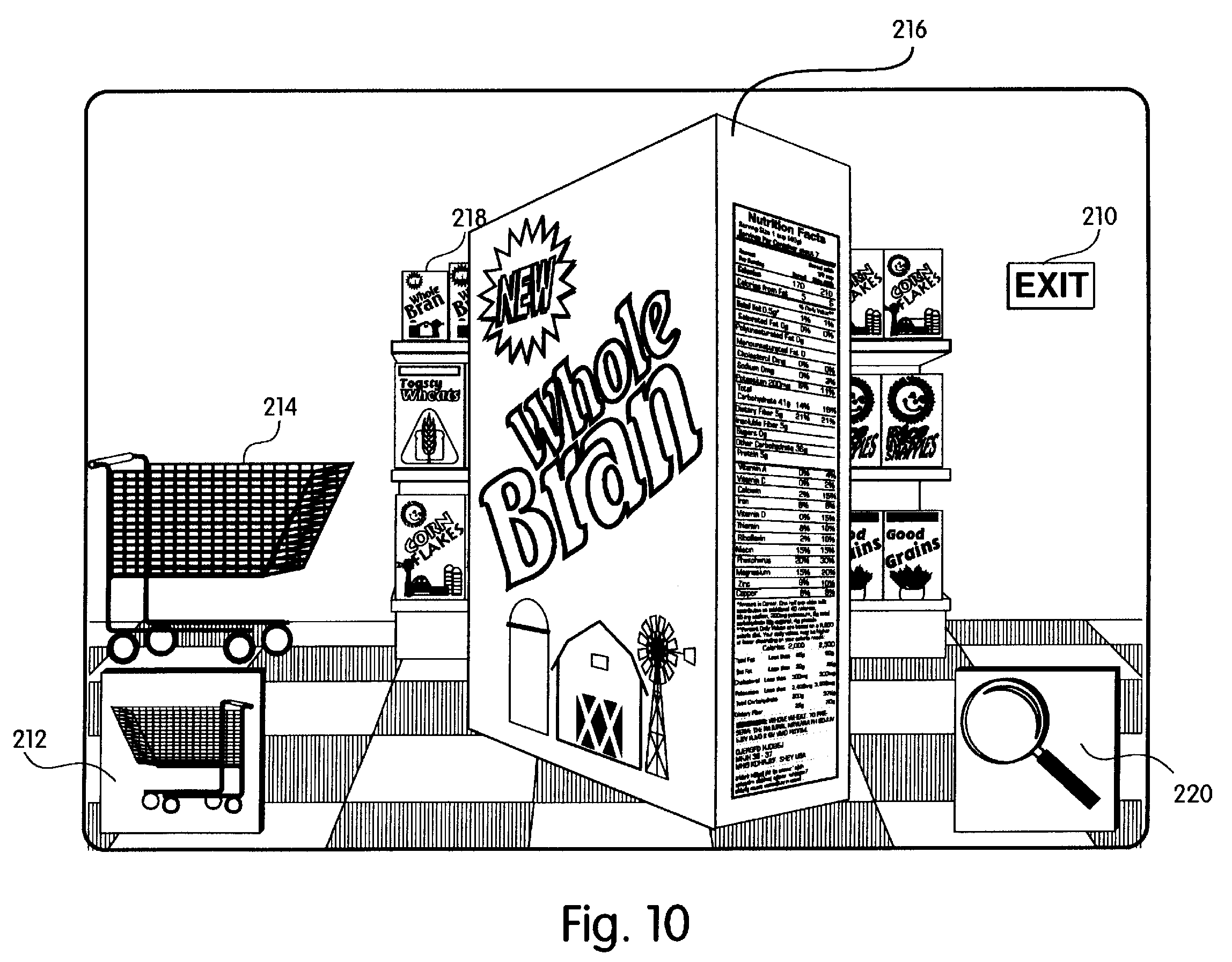
5,057,915 is entitled "System and method for attracting
shoppers to sales outlets." It was filed on October 25, 1990. The priority date of some parts is March 10, 1986.
This patent was filed by Henry Von Kohorn like 5,227,874 and 5,283,734.
Both 5,227,874 and 5,283,734 are continuations in part of 5,057,915.
See the analysis of 5,283,734 and 5,227,874.
5,057,915 refers to:
- 3095653;
- 3546791;
- 3599221;
- 3606688;
- 3671668;
- 3810627;
- 3848082;
- 3910322;
- 3964179 entitled "Telephone system teaching
apparatus" filed on November 7, 1974;
- 3993861;
- 3999307 entitled "Teaching machine" filed by
Hitachi on August 6, 1971 and whose priority date is August 07, 1970;
- 4044380 entitled "Encoder and constructed
answer system for television" filed by Westinghouse Electric on June 27, 1975, the priority date of some parts being December
17, 1973;
- 4052798 entitled "Audio-visual teaching
system" filed by Sony on April 2, 1976 and whose priority date is April 08, 1975;
- 4141548 entitled "Game apparatus for use in
conjunction with the viewing of a spectator's sport" filed on January 16, 1978;
- 4264924 entitled "Dedicated channel
interactive cable television system" filed on August 13, 1979, the priority date of some parts being March 3, 1978;
- 4268744 entitled "Score processing system
for use with ID cards" filed on December 5, 1979;
- 4271351 entitled "Cash replacement system
and components" filed on August 17, 1979;
- 4329684 entitled "Apparatus using a light
sensing system for sensing time modulated information from a light emitting device" filed by the BBC on January 15, 1980 and
whose priority date is Jan 16, 1979;
- 4339798 entitled "Remote gaming system filed
on December 17, 1979;
- 4377870 entitled "Electronic audience
polling system" filed by General Electric on December 21, 1978;
- 4388008 entitled "Automatic paper feeder"
filed on February 23, 1981;
- 4541806 entitled "Multiple aptitude testing
device" filed on September 10, 1982;
- 4573072 entitled "Method for expanding
interactive CATV displayable choices for a given channel capacity" filed on March 21, 1984;
- 4592546 entitled "Game of skill playable by
remote participants in conjunction with a live event" filed on April 26, 1984;
- 4593904 entitled "Player interactive video
gaming device" filed on March 19, 1984;
- 4608601 entitled "Video response testing
apparatus" filed on July 11, 1983 and whose priority date is July 12, 1982;
- 4611996 entitled "Teaching machine" filed on
July 18, 1985 and whose priority date is August 1, 1983;
- 4630040 entitled "Variable color
electrooptic display" filed by Motorola on March 31, 1983;
- 4671772 entitled "Performance appraisal and
training system and method of utilizing same" filed on October 22, 1985;
- 4689742 entitled "Automatic lottery system"
filed on May 5, 1986, the priority being Feb. 9, 1983 and for some parts December 12, 1980;
- 4745468 entitled "System for evaluation and
recording of responses to broadcast transmissions" filed on March 10, 1986;
- 4807031 entitled "Interactive video method
and apparatus" filed on October 20, 1987;
- 4833710 entitled "Pay television system"
filed by Matsushita on December 3, 1987 and whose priority date is February 15, 1984;
- 4876592 entitled "System for merchandising
and the evaluation of responses to broadcast transmissions" filed on May 10, 1988, the priority date of some parts being
March 10, 1986;
- 4907079 entitled "System for monitoring and
control of home entertainment electronic devices" filed on September 28, 1987;
- 4922522 entitled "Telecommunications access
to lottery systems" filed by ATT on June 7, 1988;
- 4926255 entitled "System for evaluation of
response to broadcast transmissions" filed on May 10, 1988, the priority date od some parts being March 10, 1986;
- 4975951 entitled "IPPV programming
distribution control system" filed on February 26, 1990 and whose priority date is October 7, 1988;
- 5003384 entitled "Set-top interface
transactions in an impulse pay per view television system" filed on April 1, 1988;
- CA1172847 entitled "CONTROL MICRO-DIDACTOMETRE"
filed on September 29, 1980 [not relevant for 1-click;]
- GB1287304 entitled "EDUCATIONAL TELEVISION
SYSTEMS" filed on November 24, 1969 [not relevant for 1-click;]
- GB2120507 entitled "Interactive video game
arrangement" filed on May 10, 1982.
5,057,915 is referenced by 112 patents, including:
- 6,131,086 entitled "Method and system for
allowing viewers to purchase program products" filed by Jay Walker and others on April 2, 1997.
I found 5,948,040 in a prior search with "spec/"travel planner" and spec/sign and spec/internet".
5,948,040 is entitled "Travel reservation information and planning system" and was filed on February 6, 1997 by Delorme.
This patent application is a continuation-in-part (CIP) of the David M. DeLorme et al. U.S. patent application Ser. No. 08/661,600 filed Jun. 11, 1996, for COMPUTER AIDED ROUTING AND POSITIONING SYSTEM,
now U.S. Pat. No. 5,802,492 which is a CIP of the David M. DeLorme et al. U.S. patent application Ser. No. 08/381,214 filed Jan. 31, 1995 for COMPUTER AIDED ROUTING SYSTEM, now U.S. Pat. No. 5,559,707,
issued Sep. 24, 1996, which is a CIP of the David M. DeLorme et al. U.S. patent application Ser. No. 08/265,327 filed Jun. 24, 1994 for COMPUTER AIDED MAP LOCATION SYSTEM now abandoned. This patent application
is also a CIP of the Keith A. Gray U.S. patent application Ser. No. 08/521,828 filed on Aug. 31, 1995, for COMPUTERIZED ADDRESS LOCATION AND COMMUNICATION SYSTEM now abandoned.
[The 1-click part is not necessarily taught in 5,948,040's parents.]
The summary of 5,948,040 reads:
"An object of the present invention to provide a new Travel Reservation and Information System (TRIPS) that permits a user to custom-define and examine a travel route and/or plans based upon answers to the
questions noted above. It is also an object of the invention to provide a TRIPS that is capable of determining, reserving, and/or ticketing locations along a travel route between a user-selected travel origin
and travel destination, including user-selected waypoints of interest along the way. A feature of the invention is that the user can construct a highly selective travel route that incorporates waypoints selected
by the user and establish a computer link with state-of-the-art computerized ticket and reservation systems, communications, and software."
The "DETAILED DESCRIPTION OF THE PREFERRED EMBODIMENTS OF THE INVENTION" reads:
"Hereinafter, for purposes of preferred online or Internet embodiments, FIG. 4 breaks down TRIPS retail output, differentiating access by registered or enrolled users to VALUABLE OUTPUT 447 as opposed to
FREE OUTPUT 445 which is made available to anonymous Internet "surfers," as an enticement to become members or registered users. The retail consumer output block as outlined at 227 in FIG. 2, however, generally
includes both the "free" and "valuable" varieties of online output."
Valuable output is output that you have to pay. This payment includes payment to providers:
"Setting up of an account in TRIPS would typically be required to "book" tickets or reservations to insure payment and client identification."
This registration takes place on the internet site:
"Whenever desired, user registration is achieved through the "REGISTER NOW" prompt at 407 in FIG. 4. This leads to "Accts." at 411 (i.e. "Accounts" abbreviated). Accts. corresponds to the Accounting Subsystem at
217 in FIG. 2 and the HOW? main input menu at 163 in FIG. 1C. To receive membership privileges on a TRIPS Internet site, users enroll through the USER REGISTRATION sub-menu, or by comparable means. Users register,
"sign up" and/or set up an account by routine protocols for input of their name, address, credit card numbers and other personal or business data required or requested by the TRIPS Internet site proprietor. On
account of such enrollment, or by user password entry, or by equivalent means, registered status is duly entered within the ACCOUNTING DATA sub-structure of the standard TRIPS data structure that evolves as part
and parcel of the course of any TRIPS travel planning session--as detailed elsewhere in this disclosure with particular reference to FIGS. 3 and 8. As entered in the data structure of the current TRIPS travel
planning session, the fact that the user is duly registered gets recognized at 439, and then permits access to and/or downloading of VALUABLE OUTPUT at 447 in FIG. 4."
FIG. 5d teaches a 1-click apparatus:
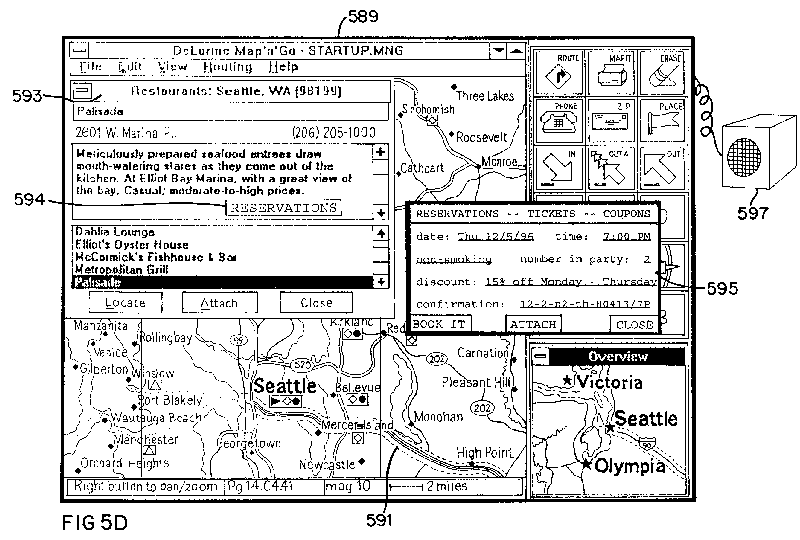
"The user executes or "books" the proposed reservation, pushing the "BOOK IT" button in the "RESERVATIONS--TICKETS--COUPONS" dialog box. The TRIPS technology communicates the reservation request and facilitates
its acceptance, rejection and/or alteration or a counteroffer from the participating provider e.g. the Palisade restaurant or its agent(s). Participating providers in TRIPS accept or confirm requested reservations
preferably by transmission of an alphanumeric and/or bar coded transaction or reservation confirmation code--shown within the transactional dialog box at 595 in FIG. 5D. The dialog box at 595 also provides an
"ATTACH" command or button to prompt inclusion of the resultant "map ticket" reservation in the TRIPS user's travel plan output. An example of a TRIPS "map ticket", attached to individual user travel plan output
in TRIPS, was pictured heretofore at 145, 147 and 149 in FIG. 1B. The TRIPS Accounting Subsystem "knows" the identities of the participating provider (e.g. the restaurant) and the registered TRIPS user--such that
the restaurant name and address, and identity of the party entitled to the dinner reservations are included on the "map ticket" output. FIG. 8B hereinafter outlines the preferred TRIPS "map ticket" data structure
and details typical data relations or links between the Geographic Subsystem and the other TRIPS Subsystems involved in "map ticket" generation."
"TRIPS output also includes the online transmission of the user's reservation requests, ticket purchases, changes, credit/payment arrangements, and so forth, directly to third-party providers participating in TRIPS."
"TRIPS output is further capable, at 147, of including an airline reservation or other transportation coupons or vouchers, and/or various special price discounts and/or extra services offered by an extensive range
of accommodation and goods or service providers that can participate in TRIPS e.g., hotels, banks, campgrounds, retail stores, hairdressers, gas stations, restaurants, taxis, video rental shops, tour guides, public
safety, or health facilities--among many others. Thereby, TRIPS output provides the advantages of "built-in" reservations, tickets and/or special offers."
| Limitation |
5,729,594 |
| under control of a client system (1) | Claim 1
reads:
"A travel reservation information and planning system (TRIPS) comprising:
- a computer;
- a TRIPS database of topical data and geographic data;
- means for a TRIPS user to relay via said computer one or more inputs related to travel, travel planning, activities
associated with travel, or any combination thereof;
- one or more subsystems couplable to said TRIPS database and constructed to process said one or more inputs from said
TRIPS user and to calculate one or more outputs responsive to said one or more inputs, wherein said one or more outputs
include information on options or a range of options corresponding to said travel, travel planning, activities associated
with travel, or any combination thereof; and
- a controller for regulating correspondence between said one or more inputs from said TRIPS user and said one or more
outputs from said one or more subsystems,
- wherein one of said one or more subsystems is a temporal subsystem including means to enable said TRIPS user to preview,
manipulate, and manage a chronological dimension associated with said travel, travel planning, activities associated with
travel or any combination thereof.
|
| displaying information identifying the item (2) |
See FIG. 5d. |
| in response to only a single action being performed (3) | "The user executes or "books" the proposed reservation, pushing the "BOOK IT" button in the
"RESERVATIONS--TICKETS--COUPONS" dialog box." |
| sending a request to order the item [...] to a server system (4) | "The TRIPS technology communicates the reservation request and facilitates its acceptance, rejection and/or
alteration or a counteroffer from the participating provider e.g. the Palisade restaurant or its agent(s). Participating
providers in TRIPS accept or confirm requested reservations preferably by transmission of an alphanumeric and/or bar coded
transaction or reservation confirmation code--shown within the transactional dialog box at 595 in FIG. 5D." |
| the request including the identifier so that the server system can locate additional
information needed to complete the order and so that the server system can fulfill the generated order to complete purchase
of the item (5) | "Hereinafter, for purposes of preferred online or Internet embodiments, FIG. 4 breaks down TRIPS retail output,
differentiating access by registered or enrolled users to VALUABLE OUTPUT 447 as opposed to FREE OUTPUT 445 which is made
available to anonymous Internet "surfers," as an enticement to become members or registered users. The retail consumer output
block as outlined at 227 in FIG. 2, however, generally includes both the "free" and "valuable" varieties of online output."
Valuable output is output that you have to pay. This payment includes payment to providers: "Setting up of an account in
TRIPS would typically be required to "book" tickets or reservations to insure payment and client identification."
This registration takes place on the internet site:
"Whenever desired, user registration is achieved through the "REGISTER NOW" prompt at 407 in FIG. 4. This leads to "Accts."
at 411 (i.e. "Accounts" abbreviated). Accts. corresponds to the Accounting Subsystem at 217 in FIG. 2 and the HOW? main input
menu at 163 in FIG. 1C. To receive membership privileges on a TRIPS Internet site, users enroll through the USER REGISTRATION
sub-menu, or by comparable means. Users register, "sign up" and/or set up an account by routine protocols for input of their
name, address, credit card numbers and other personal or business data required or requested by the TRIPS Internet site
proprietor. On account of such enrollment, or by user password entry, or by equivalent means, registered status is duly
entered within the ACCOUNTING DATA sub-structure of the standard TRIPS data structure that evolves as part and parcel of the
course of any TRIPS travel planning session." |
| a data storage medium storing information for a plurality of users (7) |
The database substructure ACCT depicted on FIG. 4 records users' "name, address, credit
card numbers and other personal or business data" to allow entering the registered user status "by user password entry, or by
equivalent means" |
| a receiving component for receiving requests to order an item [...], the request being
sent in response to only a single action being performed (8) | The TRIPS system |
| a request including an indication of one of the plurality of users (9) |
The order request is regarded as a valuable output which requires user sign-in or
registration. |
| an order placement component that retrieves from the data storage medium information
for the indicated user (10) | the TRIPS system needs to retrieve the name, and credit
card number from the ACCT substructure to The TRIPS technology to communicate the reservation request and facilitates its
acceptance, rejection and/or alteration or a counteroffer from the participating provider. |
| uses the retrieved information to place an order for the indicated user for the item (11)
| The TRIPS system communicates the reservation request to the participating provider.
|
5,948,040 refers to 22 patents:
- 4,359,631 entitled "Self-service terminal"
filed by Lawrence B Lockwood on July 11, 1980;
- 4,862,357 entitled "Computer reservation
system with means to rank travel itineraries chosen in terms of schedule/fare data" filed by SystemOne on November 18, 1988;
- 4,926,336 entitled "Route searching system
of navigation apparatus" filed on December 27, 1988 and whose priority date is December 28, 1987;
- 5,021,953 entitled "Trip planner optimizing
travel itinerary selection conforming to individualized travel policies" filed by Travelmation on March 12, 1990 and whose
priority date is Jan. 6, 1988;
- 5,172,321 entitled "Vehicle route planning
system" filed by Motorola on December 10, 1990;
- 5,191,523 entitled "System for synthesizing
travel cost information" filed on November 6, 1989;
- 5,208,756 entitled "Vehicle locating and
navigating system" filed on January 28, 1991;
- 5,231,584 entitled "Navigation apparatus
with non-volatile memory for return to initial departure point" filed on September 16, 1991 and whose priority date is
December 28, 1987;
- 5,237,499 entitled "Computer travel planning
system" filed on November 12, 1991;
- 5,243,528 entitled "Land vehicle navigation
apparatus with visual display" filed by Motorola on September 12, 1990;
- 5,253,166 entitled "Pre-ticket travel
reservation record keeping system" filed on March 29, 1991;
- 5,272,638 entitled "Systems and methods for
planning the scheduling travel routes" filed by Texas Instruments on May 31, 1991;
- 5,331,546 entitled "Trip planner optimizing
travel itinerary selection conforming to individualized travel policies" filed on June 3, 1991 and whose priority date is
March 12, 1990;
- 5,353,034 entitled "Position information
inputting apparatus for a vehicle travel guide system" filed on February 25, 1993 and whose priority date is February 25,
1992;
- 5,359,527 entitled "Navigation system for
vehicle" filed by Mitsubishi on October 19, 1992, whose priority date is November 06, 1991;
- 5,369,588 entitled "Navigation system for
motor vehicles" filed by Mitsubishi on August 7, 1992 and whose priority date is August 09, 1991;
- 5,422,809 entitled "Method and apparatus for
providing travel destination information and making travel reservations" filed on August 25, 1993;
- 5,444,618 entitled "Apparatus and method for
topographic processing" filed by Hitachi on July 24, 1992 and whose priority date is July 25, 1991;
- 5,519,619 entitled "Route planning method
for hierarchical map routing and apparatus therefor" by Motorola on March 14, 1994;
- 5,537,324 entitled "Navigation system" filed
on August 2, 1994 and whose priority date is August 07, 1993;
- 5,587,911 entitled "Navigation system with
selective intersection display" filed on December 1, 1995 and whose priority date is Jul 27, 1993;
- 5,724,520 entitled "Electronic ticketing and
reservation system and method" filed on November 21, 1994 and whose priority date is June 8, 1993;
5,948,040 is referenced by 197 patents, including:
- 6,507,823 entitled "System and method for
on-line purchasing of goods and services" filed on September 15, 1995 and whose priority date is September 23, 1993 or earlier
(there is a typo in the page);
- 6,381,583 entitled "Interactive electronic
shopping system and method" filed on June 24, 1999 but whose priority date is April 15, 1997;
OpenMarket used to market the following products:
- Open Market Transact, "a complete set of end-to-end commerce services including online customer authentication and
authorization; online order and payment processing; automated tax and shipping calculations; online order tracking and
status; and online customer service."
- Open Market LiveCommerce, an "enterprise catalog solution that enables companies to maximize revenues by creating
intuitive, personalized online catalogs."
- ShopSite, an "online store creation system that allows merchants to build and maintain catalogs of products or services
to sell over the Internet."
- OpenMarket SecureLink, a "client access to OpenMarket Transact servers."
Open Market initially released
Transact in 1995. Version 3 of Transact was released before
June 1997.
Open Market was bought by Divine, an enterprise application integration tools vendor.
Soverain Software bought OpenMarket patents in 2003 after Divine went bankrupt.
A news teaches us that:
- the USPTO and then the EPO granted "staggeringly broad e-commerce technology patents" to Open Market.
- Soverain [the owner of Open Market patents] filed suit in U.S. District Court against Amazon.com and Gap Inc. for patent
infringement in January 2004. On August 11, 2005 it was
reported that Amazon settled said patent infringement lawsuit on Thursday [August 10?], paying Soverain Software $40
million in third-quarter 2005.
No company probably contributed more than Netscape to the creation of the World Wide Web.
Netscape can be credited for the invention of:
- Netscape navigator, the first commercial browser with 50 millions users by 1997;
- JavaScript;
- cookies.
Netscape also introduced server-side Javascript and Java, SSL/HTTPS.
LivePayment was a commerce extension to the Netscape server platform, to support online payments over the Internet.
LivePayment is described in a white paper published before October 26, 1996.
LivePayment can be combined with Klingman-like solutions:
THE PROMISE OF ELECTRONIC COMMERCE section reads "Collecting money through an Internet application must be simple - as easy as embedding a "pay now" tag in a World Wide Web document. "
The white paper further reads:
"Internet-Based Communication to Banking Network. Communication with the merchant's credit card processing institution (known as an Acquirer) is done over the Internet, providing a flexible and low cost method
for transmitting transactions. This eliminates the need for dial-up modems or leased lines."
that shows that LivePayment is something aiming to replace "retrieving telephone number to establish a telephone toll connection" as taught by Klingman.
The white paper teaches the following scenario:
"The consumer interacts with the application using a Web browser.
When he or she is ready to complete the purchase, the Web page prompts for the transaction information - name, shipping address, and credit card account information.
The consumer provides his or her payment information directly in response to the Web page prompts. The information is then transferred via SSL or within an encrypted and signed slip using the SET protocol.
The Netscape HTTP server receives the information from the browser and passes it to the LiveWire server extensions.
If the consumer's payment information is not already contained in a slip, the LiveWire JavaScript code puts it into one. The slip is one of the LivePayment JavaScript objects, and is used to communicate payment
information to the Card Processor.
When the LiveWire application has set up the consumer's payment information, it sends it to the Card Processor as part of a request for an authorization, capture, or credit action.
The Card Processor handles the actual transactions with the acquiring bank. It transparently maintains the Internet link to the banking network.
The Card Processor communicates with the Acquirer's gateway using the SSL protocols, and also uses certificates for mutual authentication between the merchant and the Acquirer.
When it receives results back from the Acquirer (transaction authorized or refused, capture succeeded, etc.), it communicates these back to the LiveWire application through the LivePayment objects.
The application, in turn, can communicate the results back to the consumer."
The white paper further reads:
"LivePayment enables an online publisher to collect fees for electronic content using a variety of payment models. For example, an application might levy a subscription fee, and then aggregate usage fees.
It could also charge by time (by the minute or hour) or by the item accessed" because technically one click is the same as "charge by the item accessed."
The SET protocol was defined by VISA and Mastercard. We include the SET protocol in the Netscape chapter because it was used by LivePayment. SET stands for Secure Electronic Transaction.
For a description of the functions provided by the SET protocol you may look at a SET Protocol Description by the University of
Cambridge.
We look for 1-click suggestions in SET documentation, articles and white papers. Relatively few documents are still available on Internet.
The setco.org site where specifications were stored was closed and poorly and lately indexed in archive.org. So we would be especially interested by copies of this site
in 1996 and early 1997.
One of the best papers is the Secure Electronic Transaction article by whatis.com.
The article teaches the following scenario:
- The customer opens a Mastercard or Visa bank account. Any issuer of a credit card is some kind of bank.
- The customer receives a digital certificate. This electronic file functions as a credit card for online purchases or other transactions. It includes a public key with an expiration date. It has been through a digital
switch to the bank to ensure its validity.
- Third-party merchants also receive certificates from the bank. These certificates include the merchant's public key and the bank's public key.
- The customer places an order over a Web page, by phone, or some other means.
- The customer's browser receives and confirms from the merchant's certificate that the merchant is valid.
- The browser sends the order information. This message is encrypted with the merchant's public key, the payment information, which is encrypted with the bank's public key (which can't be read by the merchant), and
information that ensures the payment can only be used with this particular order.
- The merchant verifies the customer by checking the digital signature on the customer's certificate. This may be done by referring the certificate to the bank or to a third-party verifier.
- The merchant sends the order message along to the bank. This includes the bank's public key, the customer's payment information (which the merchant can't decode), and the merchant's certificate.
- The bank verifies the merchant and the message. The bank uses the digital signature on the certificate with the message and verifies the payment part of the message.
- The bank digitally signs and sends authorization to the merchant, who can then fill the order.
This apparatus can be regarded as 1-click depending on how the user reads her private key. If the private key (stored on the PC or on a smart card) is password-protected then the user is prompted locally.
This prompt may be displayed when the user clicks on the "buy now" button or checks out or earlier.
The scenario departs from 1-click first claim in that the merchant does not necessarily know the customer (note that SET does not address the shipment issue - when the purchased item has to be shipped or has to
identify a customer (air ticket for instance) then the merchant must know the customer. The air ticket example illustrates that the non-repudiation feature used for payment may also be useful for other purposes such as
security.
"Netscape AppFoundry Online is the enterprise developers' source for starter applications,
technical information, tools, and expert forums for quickly building and dynamically deploying open intranet applications." It included on February 20, 1887 customizable applications and development tools.
The Columbus State University put the documentation of the 1996 Netscape AppFoundry online. AppFoundry contained a
number of examples to teach people how to write web applications. Code can still be downloaded. They contain links to URLs of Netscape and others pages in 1996 that can be viewed with the wayback machine.
Two examples are relevant:
- Internal Purchasing that provides an internal purchasing application.
I downloaded the code that I was able to inflate with winzip. However the help page (supplies/help.html) teaches a shopping basket similar to the system taught in the article of Dr Dobbs,
September 1996, Volume 21, Issue 9, page 64 by Chris Baron and Bob Weil, entitled "Implementing a Web Shopping Cart."
- Travel and Expense Reimbursement Form (TERF) that teaches a method of submitting a travel expense report comprising:
- under control of a client system,
- displaying information helping entering reimbursement data [TextAreas - not buttons]; and
- in response to only a single action being performed, sending a request to submit a report along with an identifier of a employee of the item to a server system;
- under control of a single-action ordering component of the server system,
- receiving the request;
- retrieving additional information previously stored for the employee identified by the identifier in the received request; and
- generating an order to reimburse the employee identified by the identifier in the received request using the retrieved additional information; and
- fulfilling the generated reimbursement order to complete reimbursement of employee expenses
- whereby the reimbursement is ordered without using a shopping cart ordering model.
There were also articles in Javaworld about the AppFoundry:
- in October 1995;
- in October 1996.
5,826,242 is entitled "Method of on-line shopping utilizing persistent client state in a hypertext transfer protocol based client-server
system." It was filed by Netscape on August 27, 1997. This was a divisional of 5,774,670 that was filed on filed on October 6, 1995.
"In accordance with the present invention, the server can send state information to the client when a document is sent. The client then stores the state information, which is typically in the form of a state object.
In a subsequent request for documents to the server, the client can send the stored state information to the server."
| Limitation |
5,729,594 |
| under control of a client system (1) | Claim 1
reads:
"A method of on-line shopping by a customer using a browser running on a client computer, said method comprising the steps
of:
- sending a first request by said browser to a merchant server for a first HTML document describing a product;
- displaying said HTML document on said client computer, said displayed HTML document describing said product;
- selecting, by said customer, said product;
- sending a second request by said browser to said merchant server in response to said selection made by said customer;
- sending a state object from said merchant server to said browser, said state object identifying said product; and
- storing said state object on said client computer by said browser.
|
| displaying information identifying the item (2) |
"displaying said HTML document on said client computer, said displayed HTML document describing said product" [claim 1] |
| sending a request to order the item [...] to a server system (3) | "sending a second request by said browser to said merchant server in response to said selection made by said customer"
[claim 1] |
| the request including the identifier so that the server system can locate additional
information needed to complete the order and so that the server system can fulfill the generated order to complete purchase
of the item (4) | "In accordance with the present invention, the server can send state
information to the client when a document is sent. The client then stores the state information, which is typically in the
form of a state object. In a subsequent request for documents to the server, the client can send the stored state information
to the server." and "A user of the information service may browse the different publications by making http requests, from
the client's/user's computer system, to the publisher's Web server which responds with the requested publication and state
information specifying the user's identification, and other subscription information (e.g., user registration and billing
information) which allows the user to view the contents of the publication; this information is typically provided by the
user at least once in a conventional log-on process." |
| a shopping cart ordering component and a single-action ordering component (6) |
"The merchant server then sends an HTML form document that requests the customer to send
necessary details for the purchase (step 218). For example, the customer may select a quantity, a desired style, and size of
the product as requested by the form document. The browser then sends a POST command under HTTP, which transmits the data
entered into the form to the merchant server (step 222)." and "The customer can also select products to be placed in a
virtual shopping basket. The server then sends state information related to the selected products to the browser on the
client for storage. When the customer wants to purchase the products in the virtual shopping basket, the browser sends the
corresponding state information to a specified check-out Web page for processing." |
| a data storage medium storing information for a plurality of users (7) |
Following from "Thereafter, this information is included in the state information which is
exchanged between the client and the server in the process of the invention. Accordingly, when the user, during the browsing
process, desires to view another publication (e.g., from the same or different publisher) this state information will be
transmitted back to the Web server to provide the necessary subscription information (thereby entitling the user to view the
publication) without requiring the user to re-enter the necessary subscription information." The invention teaches a use of
cookies for identifying and not describing resources. A product identifier allows retrieving the corresponding row in the
inventory. This implies a user database storing user data (user registration and billing information). It is also apparent
that these data have to be stored in a permanent data storage medium. Otherwise users would have to register each time the
server is restarted. |
| a receiving component for receiving requests to order an item [...], the request being
sent in response to only a single action being performed (8) | "For example, the customer
may select a quantity, a desired style, and size of the product as requested by the form document. The browser then sends a
POST command under HTTP, which transmits the data entered into the form to the merchant server (step 222). The data on the
submitted form (e.g., quantity, size, style, etc.) is analyzed by the server and the transaction is processed." |
| a request including an indication of one of the plurality of users (9) |
See analysis of limitation 4. |
| an order placement component that retrieves from the data storage medium information
for the indicated user (10) | Inherent from analysis of limitation 7 and from "The data
on the submitted form (e.g., quantity, size, style, etc.) is analyzed by the server and the transaction is processed." |
| uses the retrieved information to place an order for the indicated user for the item
(11) | Inherent from analysis of limitation 7 and from "The data on the submitted form
(e.g., quantity, size, style, etc.) is analyzed by the server and the transaction is processed." |
| fulfilling the generated order to complete purchase of the item whereby the item is
ordered without using a shopping cart ordering model (12) | Inherent from analysis of
limitation 7 and from "The data on the submitted form (e.g., quantity, size, style, etc.) is analyzed by the server and the
transaction is processed." |
5,826,242 was considered in the prosecution of 09/151,617, a continuation in part of
1-click. The main difference between 1-click and 09/151,617 is that 09/151,617 adds a ""receiving from a user an indication
of a recipient to whom the ordered item is to be delivered." This limitation addresses the need of people making gifts. Then
the billing data (known by the user) do not relate to shipment data (not necessarily known by the user). The user just needs
to provide the mail address of the recipient and the system of the invention sends a mail asking the recipient for the
shipment address.
Despite the additional limitation the examiner made a non-final rejection. He found that 09/151,617 was obvious over
5,826,242.
The Amazon attorney replied that:
- claims are "directed to techniques in which a user orders an item (eg., a gift) that is to be sent to a recipient,"
- claims "make it clear [/recite] that additionnal information is collected from sources other than the user who orders the
item."
To summarize the attorney found that 5,826,242 does not teach the limitation that was added to 1-click.
However the examiner made a final rejection on the same ground.
The Amazon attorney filed an appeal in which he wrote that the invention relates to a technology allowing a user to place a
purchase order with a vendor over a network without providing complete delivery information (eg., a delivery address) for a
recipient of the order.
Then, in a non-final rejection, the examiner found that 09/151,617 was obvious over 5,826,242 in view of 5,870,717.
You can also read the 5,826,242 section of the 1-click family page.
1-click does not reference 5,826,242.
5,826,242 refers to nine patents:
- 5,710,887 entitled "Computer system and
method for electronic commerce" filed by Broadvision on August 29, 1995;
- 5,721,832 entitled "Method and apparatus for
an interactive computerized catalog system" filed on May 12, 1995;
- 5,740,425 entitled "Data structure and
method for publishing electronic and printed product catalogs" filed on September 26, 1995;
- 5,745,681 entitled "Stateless shopping cart
for the web" filed by Sun on January 11, 1996
- 5,754,656 entitled "Electronic shopping
method, electronic shopping system and document authenticating method relating thereto" filed by Hitachi on August 1, 1996,
whose priority date is August 4, 1995;
- 5,757,917 entitled "Computerized payment
system for purchasing goods and services on the internet" filed on November 1, 1995;
- 5,758,327 entitled "Electronic requisition
and authorization process" filed on November 1, 1995;
- 5,760,771 entitled "System and method for
providing structured tours of hypertext files" filed on July 17, 1996;
- 5,761,649 entitled "Method for updating a
remote computer" filed on June 5, 1995 and whose priority date is April 10, 1992;
5,826,242 is referenced by 94 patents including:
- 6,016,504 entitled "Method and system for
tracking the purchase of a product and services over the Internet" filed by InfoSpace on August 28, 1996;
- 5,905,973 entitled "Shopping basket
presentation method for an online shopping system" filed by Hitachi on September 29, 1997 but whose priority date is
September 30, 1996.
I reported in the end notes of A business view of software and business method patents that
Google and Yahoo settled out of court, Google giving shares to Yahoo, for a license to use notably the patent portfolio of a
company bought by Yahoo, Overture (goto.com).
Said patent portfolio allegedly anticipated
AdWords.
This prior art is of interest here because in 1-click the buy now buttons are displayed once the user signed in and behave in
the same way as ads.
Only 6,269,361 is assigned to GoTo.com.
6,269,361 is entitled "System and method for influencing a position on a search result list generated by a computer network
search engine." It was filed on May 28, 1999, too late to be considered as 1-click prior art. However the patents cited by
6,269,361 are of interest:
- 5,659,732 entitled "Document retrieval over
networks wherein ranking and relevance scores are computed at the client for multiple database documents" filed by InfoSeek
on May 17, 1995;
- 5,717,923 entitled "Method and apparatus for
dynamically customizing electronic information to individual end users" filed by Intel on November 3, 1994;
- 5,724,424 entitled "Digital active
advertising" filed by OpenMarket on November 29, 1995 and whose priority date is December 16,
1993;
- 5,724,521 entitled "Method and apparatus for
providing electronic advertisements to end users in a consumer best-fit pricing manner" filed by Intel on November 3, 1994;
- 5,724,524 entitled "Method and system for
listing, brokering, and exchanging carrier capacity" filed by Pitney Bowes on December 15, 1995;
- 5,748,954 entitled "Method for searching a
queued and ranked constructed catalog of files stored on a network" filed by Carnegie Mellon on June 5, 1995;
- 5,752,238 entitled "Consumer-driven
electronic information pricing mechanism" filed by Intel on November 3, 1994;
- 5,768,521 entitled "General purpose
metering mechanism for distribution of electronic information" filed by Intel on February 2, 1996 and whose priority date is
May 16, 1994;
- 5,794,210 entitled "Attention brokerage"
filed on December 11, 1995;
- 5,826,241 entitled "Computerized system for
making payments and authenticating transactions over the internet" filed on September 16, 1994;
- 5,848,397 entitled "Method and apparatus for
scheduling the presentation of messages to computer users" filed on April 19, 1996;
- 5,848,407 entitled "Hypertext document
retrieving apparatus for retrieving hypertext documents relating to each other" filed by Matsushita on May 22, 1997 and whose
priority date is May 22, 1996;
- 5,852,820 entitled "Method for optimizing
entries for searching an index" filed by Digital on August 9, 1996;
- 5,855,008 entitled "Attention brokerage"
filed on August 28, 1997 and whose priority date is Decembre 11, 1995;
- 5,864,845 entitled "Facilitating world wide
web searches utilizing a multiple search engine query clustering fusion strategy" filed by Siemens on June 28, 1996;
- 5,864,846 entitled "Method for facilitating
world wide web searches utilizing a document distribution fusion strategy" filed by Siemens on June 28, 1996;
- 5,903,882 entitled "Reliance server for
electronic transaction system" filed on December 13, 1996;
- 5,918,014 entitled "Automated collaborative
filtering in world wide web advertising" filed on December 26, 1996;
- 5,920,854 entitled "Real-time document
collection search engine with phrase indexing" filed by InfoSeek on August 14, 1996;
- 5,920,859 entitled "Hypertext document
retrieval system and method" filed on February 5, 1997
- 6,078,866 entitled "Internet site searching
and listing service based on monetary ranking of site listings" filed on September 14, 1998;
- JP11316764 entitled "METHOD AND DEVICE
FOR RETRIEVING STRUCTURED DOCUMENT AND COMPUTER-READABLE RECORDING MEDIUM WHERE STRUCTURED DOCUMENT RETRIEVAL PROGRAM IS
RECORDED" aka 6,496,820 entitled "Method and
search method for structured documents" filed by Hitachi on Apr 30, 1998;
- WO9948028 entitled "IMPROVED SEARCH
ENGINE" aka 6,421,675 entitled "Search engine"
filed on July 15, 1998;
- WO0041090 entitled "SEARCH ENGINE
DATABASE AND INTERFACE" filed on January 8, 1999.
The Wikipedia article about Prodigy reads:
"Prodigy Communications Corporation was a dialup service (a sort of "mega-BBS") for home computers in the United States
before the advent of the Internet. Prodigy claimed it was the first consumer online service, differentiating itself from the
leading service provider, CompuServe, which was used mostly by technophiles."
"Initially, Prodigy had hoped that its service would be much like today's Internet portals, offering news, weather, sports,
shopping for groceries or general merchandise, banking, brokerage services, and airline reservations."
"Prodigy retains the distinction of having launched ESPN's website and growing such firms as PC Flowers into some of the
online world's earliest success stories."
Prodigy was granted a number of patents including:
- 5,347,632 entitled "Reception system for an
interactive computer network and method of operation;" it was filed on July 28, 1989; the priority date of some parts is
July 15, 1988;
- 5,361,393 entitled "Method for improving
interactive-screen uploading of accounting data;" it was filed on January 28, 1992;
- 5,442,771 entitled "Method for storing data
in an interactive computer network; it was filed on November 26, 1993; this is a division of 5,347,632; the priority date of
some parts is July 15, 1988;
5,347,632 reads:
"This invention relates generally to a distributed processing, interactive computer network intended to provide very large
numbers of simultaneous users; e.g. millions, with access to a large number; e.g., thousands, of applications which include
pre-created, interactive text/graphic sessions; and more particularly, to a computer network in which the interactive
text/graphic sessions are comprised of pre-created blocks cf data and program instructions which may be distributed
downwardly in the network for use at a software enhanced user computer terminal that reduces processing demand on the
higher-level network elements, thus permitting the higher-level elements to function primarily as data supply and maintenance
resource, and, thereby, reduce network complexity, cost and response time."
So 5,347,632 describes a kind of applet or ActiveX control, the partioned application. A HTML similar feature can be the
frames: then each part of the window comes from a different URL (~addressable partitions.) The system similar to an ActiveX
container or to a browser is the Reception System (RS) 400.
"The transactional features of interactive network 10 saves the user time, money, and frustration by reducing time spent
traveling, standing in line, and communicating with sales personnel. The user may, through RS 400, bank, send and receive
messages, review advertisements, place orders for merchandise, and perform other transactions. In the preferred embodiment,
network 10 provides information and transaction processing services for a large number of users simultaneously accessing the
network via the public switched telephone network (PSTN), broadcast, and/or other media with their RS 400 units. Services
available to the user include display of information such as movie reviews, the latest news, airlines reservations, the
purchase of items such as retail merchandise and groceries, and quotes and buy/sell orders for stocks and bonds. Network 10
provides an environment in which a user, via RS 400 establishes a session with the network and accesses a large number of
services. These services are specifically constructed applications which as noted are partitioned so they may be distributed
without undo transmission time, and may be processed and selectively stored on a user's RS 400 unit."
So this invention applies to online sales.
"To initiate a session with network 10, objects representing the logon application are retrieved from the user's personal
diskette, including the R. S. application software, which was previously set up during a standard installation enrollment
procedure with network 10. Once communication between RS 400 and cache/concentrator layer 300 has been established, the user
begins a standard logon procedure by inputting a personal entry code. Once the logon procedure is complete, the user can
begin to access various desired services (i.e., partitioned applications) which provide display of requested information
and/or transaction operations."
The user sign-in first. FIG. 3b shows:
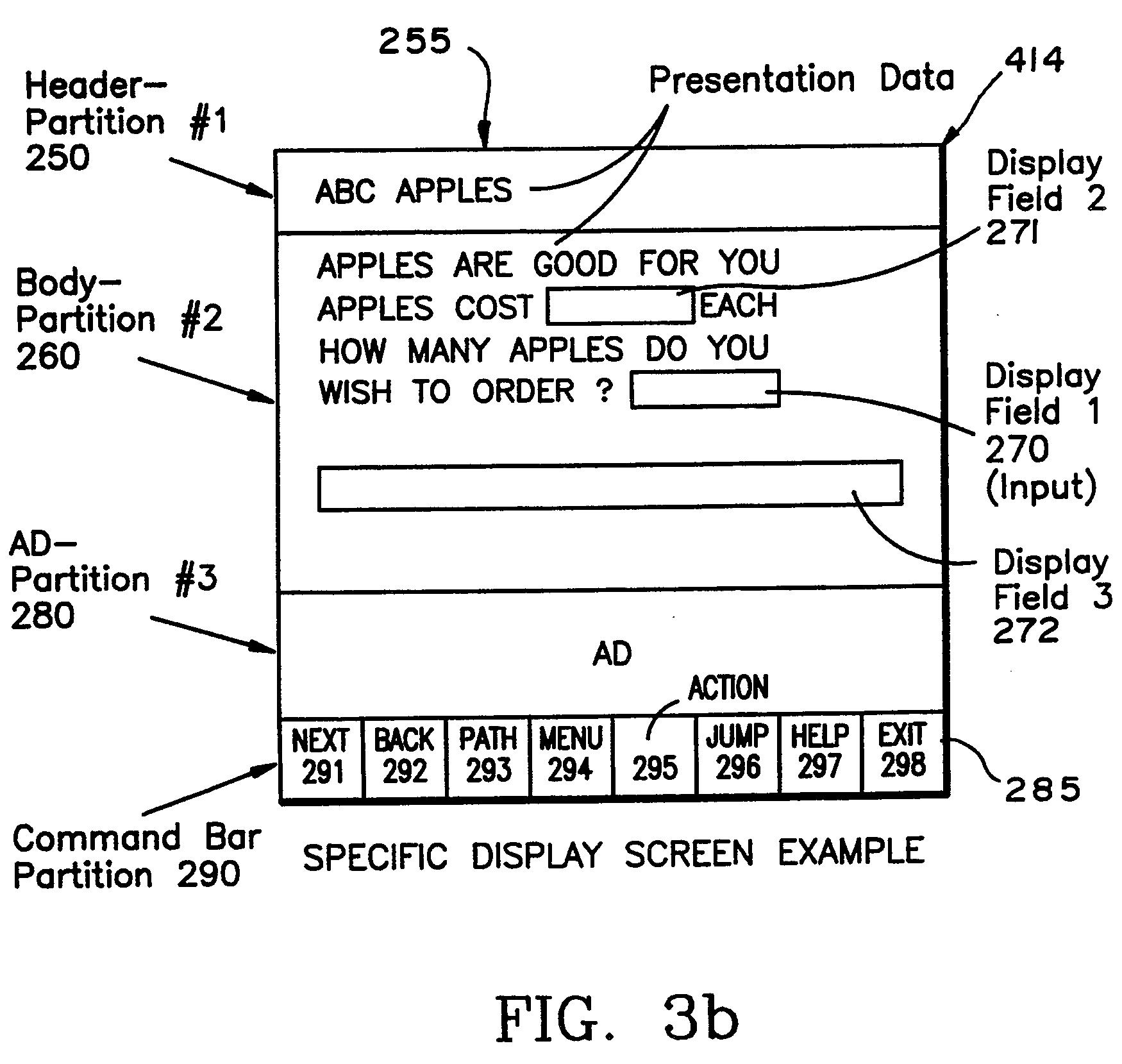
The description is detailed but does not state that 1-click was provided (that the user did not have to fill a checkout form
to order apples.) A written publication could complement this patent.
5,347,632 refers to:
- 3,653,001 entitled "Time-shared computer
graphics system having data processing means at display terminals" filed by Bell Labs on November 13, 1967;
- 4,091,448 entitled "Off-line,
one-level/on-line, two-level timeshared automated banking system" filed on October 29, 1976;
- 4,200,930 entitled "Adapter cluster module
for data communications subsystem" filed by Burroughs on August 10, 1978, the priority date of some parts being May 23, l977;
- 4,289,930 entitled "Electronic apparatus for
the display of information received over a line" filed by General electric on November 30, 1978;
- 4,319,336 entitled "Transaction execution
system with improved key function versatility" filed by IBM on February 2, 1979;
- 4,460,960 entitled "Transaction execution
system having keyboard and message customization, improved key function versatility and message segmentation" filed by IBM on
October 14, 1981 and whose priority date is February 2, 1979;
- 4,553,222 entitled "Integrated interactive
restaurant communication system for food and entertainment processing" filed on March 14, 1983;
- 4,575,679 entitled "Automatic load shed
control for spacecraft power system" filed by General Electric on May 10, 1983 [not relevant;]
- 4,691,340 entitled "Image information
accessing user terminal" filed by Sony on November 22, 1985, the priority date being Nov 28, 1984;
- 4,724,521 entitled "Method for operating a
local terminal to execute a downloaded application program" filed by Verifone on January 14, 1986;
- 4,751,669 entitled "Videotex frame
processing" filed by Wang on April 4, 1985, the priority date of some parts being March 30, 1984;
- 4,787,050 entitled "Apparatus for managing
software bending machines" filed by Brother on November 12, 1986, the priority date being November 12, 1985;
- 4,805,119 entitled "User terminal for
videotex" filed by Sony June 26, 1986, the priority date being June 27, 1985;
- 4,805,134 entitled "Electronic system for
accessing graphical and textual information" filed by IBM on January 9, 1986;
- 4,851,994 entitled "Data I/O terminal
equipment having mode setting functions for downloading various specified application programs from a host computer" filed by
Sharp on August 1, 1985, the priority date being August 03, 1984;
- 4,882,705 entitled "Data transmission system
including the downloading of a first program for the interruption of a second program" filed by NEC on August 2, 1988, the
priority date being December 07, 1984;
5,347,632 is referenced by 348 patents including:
- 6,029,182 entitled "System for generating a
custom formatted hypertext document by using a personal profile to retrieve hierarchical documents" filed on October 4, 1996;
- 6,026,376 entitled "Interactive electronic
shopping system and method" filed on April 15, 1997; 6,026,376 teaches a shopping cart in which the user enters order
information at checkout time:
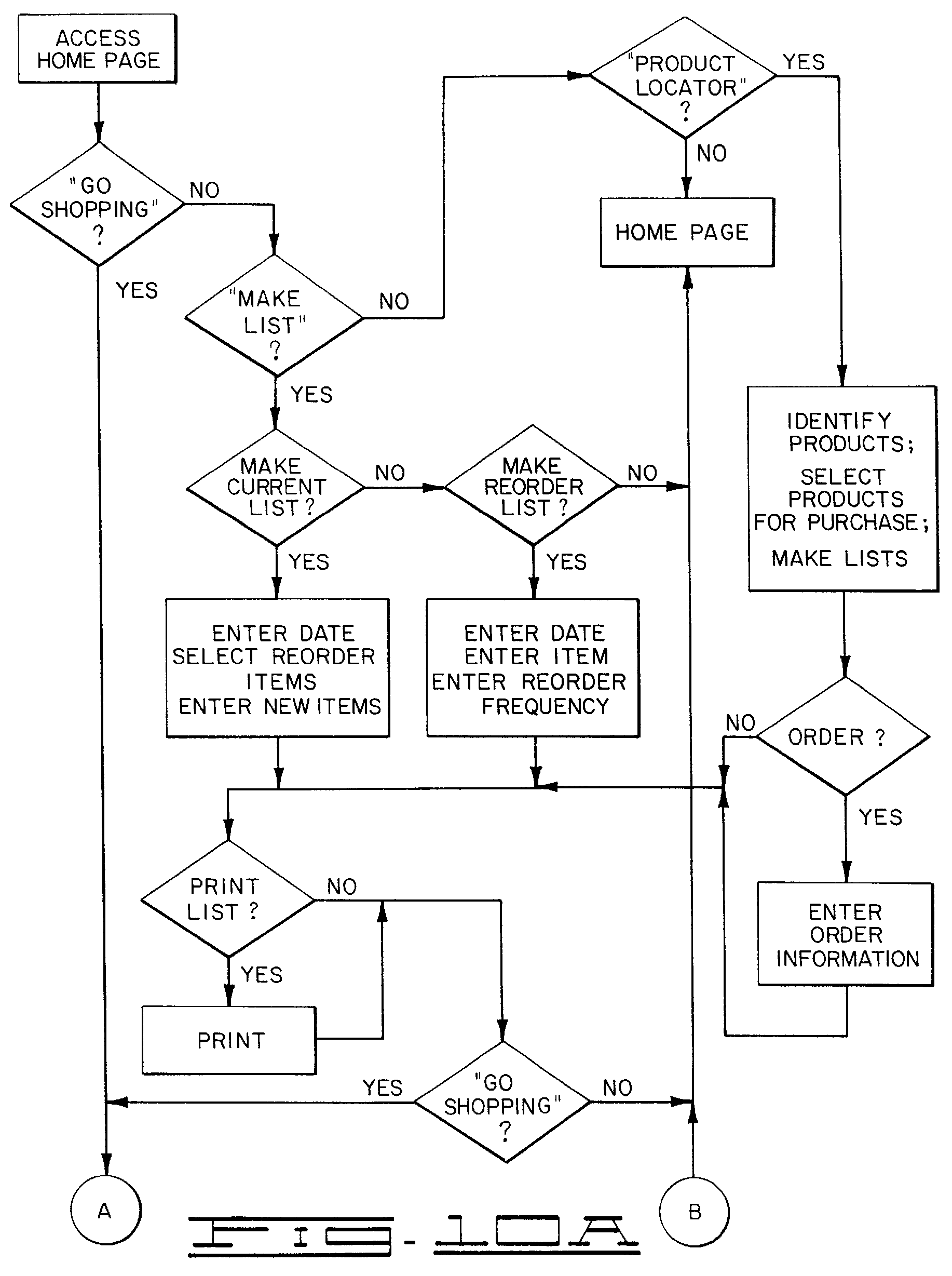
- 6,014,634 entitled "System and method for
providing shopping aids and incentives to customers through a computer network" filed on August 4, 1997 and whose priority
date is December 23, 1996; first claim reads:
A computer implemented method for determining purchasing incentives for consumers, comprising the steps of:
- storing in a purchase history database product data for products purchased in association with a unique identifier;
- transmitting a prompt for personal information from a main computer to a personal computer over a computer network;
- transmitting personal information data from said personal computer to said main computer over said computer network in
response to said prompt, said personal information data including an identity code;
- generating page data defining a personal web page that is accessible over said computer network, said personal web page
based at least in part on said personal information data transmitted from said personal computer to said main computer,
- assigning a web page address to said personal web page based upon said personal information data,
- storing said page data defining said personal web page in a personal page database;
- determining a purchase incentive depending on (1) said product data stored in said purchase history database or (2) said
page data stored in said personal page database; and
- updating said page data so that said personal web page will display said purchase incentive.
FIG. 4 shows:
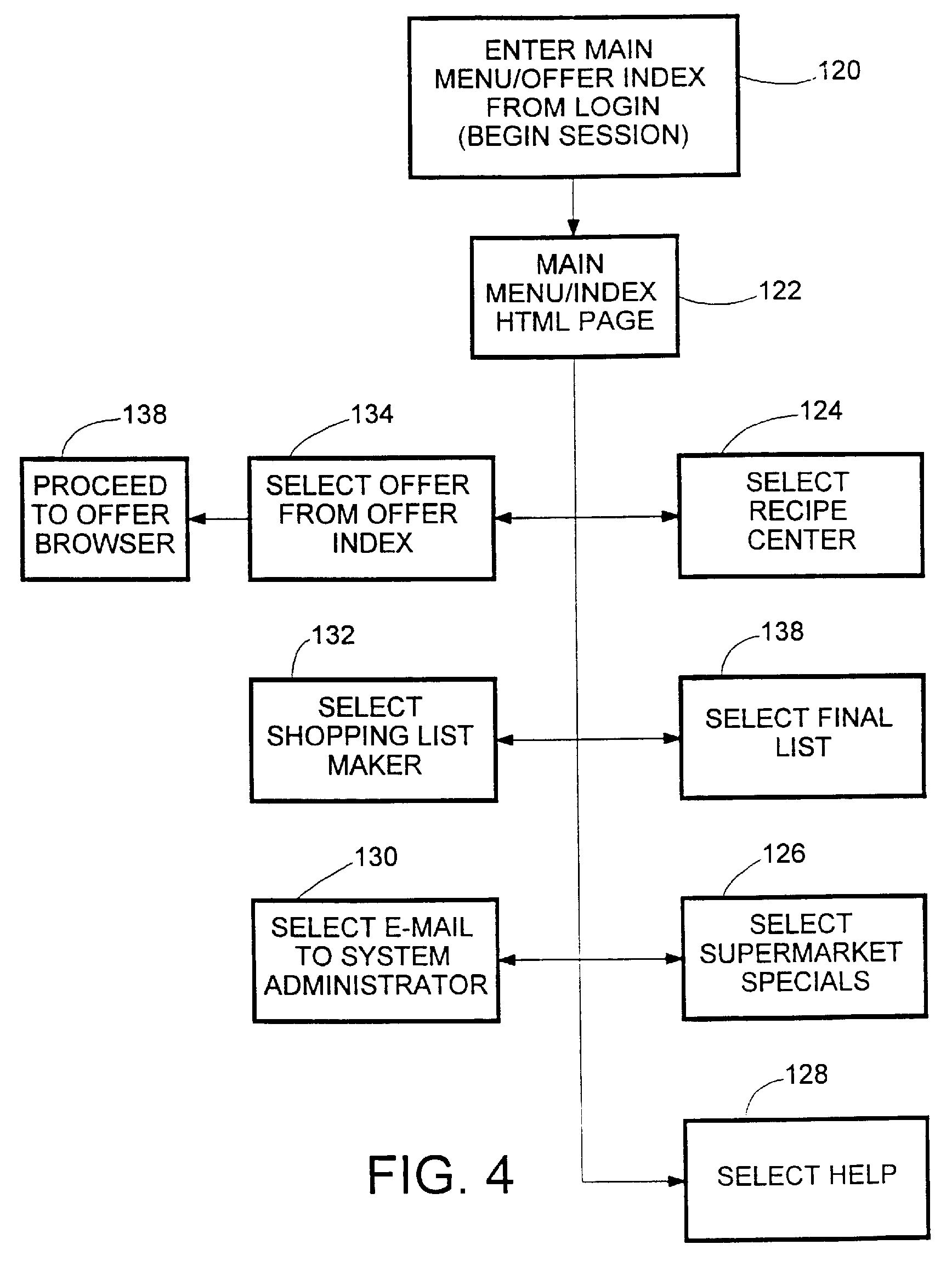
- 5,999,914 entitled "Electronic promotion
system for an electronic merchant system" filed by Microsoft on October 16, 1996; somewhat similar to the patent above.
Promotion is effective when the user signed in and 1-click can be construed as a kind of promotion (a facility provided to
registered users;)
- 5,970,471 entitled "Virtual catalog and
product presentation method and apparatus" filed on March 22, 1996;
- 5,870,724 entitled "Targeting advertising
in a home retail banking delivery service" filed on June 6, 1995 and whose priority date is December 10, 1990;
- 5,710,887 entitled "Computer system and
method for electronic commerce" filed by Broadvision on August 29, 1995.
6,014,634 is entitled "System and method for
providing shopping aids and incentives to customers through a computer network." It was filed by Supermarkets Online on August
4, 1997 and its priority date is December 23, 1996. Supermarkets Online was a subsidiary of "Catalina Marketing Corp" that was also
assigned a number of patents.
An article of InternetNews published on November 25, 1999 reports
that Supermarkets Online had the following products:
- ValuPage has several opt-in options including e-mail addresses and the use of frequent shopper card numbers for maximum targeting, the
company said. There was a http://www.valupage.com/ site
including a guided tour and a
help recorded by the Wayback machine on May 30, 1998.
- ValuPageE-mail, which recently reached its 2 million subscriber mark, features a targeted weekly e-mail based on purchase behavior data
that delivers the coupons and other consumer packaged goods promotions found on ValuPage directly to consumers' e-mail in-boxes.
- ValuBanner provides manufacturers with advertising banners, posted on allied Internet sites, that are tied to the coupons and promotions
delivered by the ValuPage service.
- ValuPage Sample supports the targeted delivery of sample offers to consumers, Catalina Marketing provides strategic targeted marketing
solutions for consumer goods companies and retailers using in-store incentives, loyalty programs, sampling and advertising messages; and at
home, through direct mailings and online.
| Limitation |
6,014,634 |
| under control of a client system (1) | at least one personal computer
coupled to said main computer via said computer network [claim 14] |
| displaying information identifying the item (2) | "transmitting back to
the registered customer a plurality of incentive offers", "incentives are presented to the customer in the form of a convenient index that the
customer can browse through and select from" |
| a data storage medium storing information for a plurality of users (7) |
- Database of customer purchase histories. "The customer id. may be a check-cashing card number, or other form of identification
that allows the system to access the customer's purchasing history, and then select a purchasing incentive based on some aspect of the customer's prior
shopping history." "Customers who volunteer the necessary linkage in the form of their customer id. may be rewarded in some manner. The customer id.
may be requested only once and then used for all subsequent sessions in which the customer logs in to the system."
- "Consumer database 506, which identifies consumers by their E-mail addresses." "Alternatively, the consumer database 506 may be integrated with the
consumer purchase history database 502."
- Personal page database containing "personal preferences." "demographics, personal purchase preferences."
|
| a request including an indication of one of the plurality of users (9) |
"generating page data defining a personal web page that is accessible over said computer network, said personal web page based at least in part on said
personal information data transmitted from said personal computer to said main computer" [claim 1]; the URI being part of the request the request contains
an indication of one of the plurality of users. |
| an order placement component that retrieves from the data storage medium information for the indicated user (10) |
"determining a purchase incentive depending on (1) said product data stored in said purchase history database or (2) said
page data stored in said personal page database" [claim 1] |
| uses the retrieved information to place an order for the indicated user for the item (11) |
"The step of generating a purchase incentive includes converting numeric and textual information provided by the customer
to graphical form; converting other numeric and textual information to graphical form; and merging the converted information with other graphical information
defining the incentive, to form a composite graphical incentive image for transmission to the customer." The incentive (~order) combines user and item data.
|
| fulfilling the generated order to complete purchase of the item (part of 12) |
"The customer id. may be a check-cashing card number or other customer loyalty card number, or may be some other form of
identification used to pay for purchases." "For delivery of a product sample, the customer's name and address must be supplied." 6,014,634 teaches a
fulfillment that involves shipment and closely relates to purchasing. |
6,014,634 is interesting because though there is no checkout form where the user enters her shipping and payment data (the user sign-in first) it
implements a shopping cart as shown on the figures:
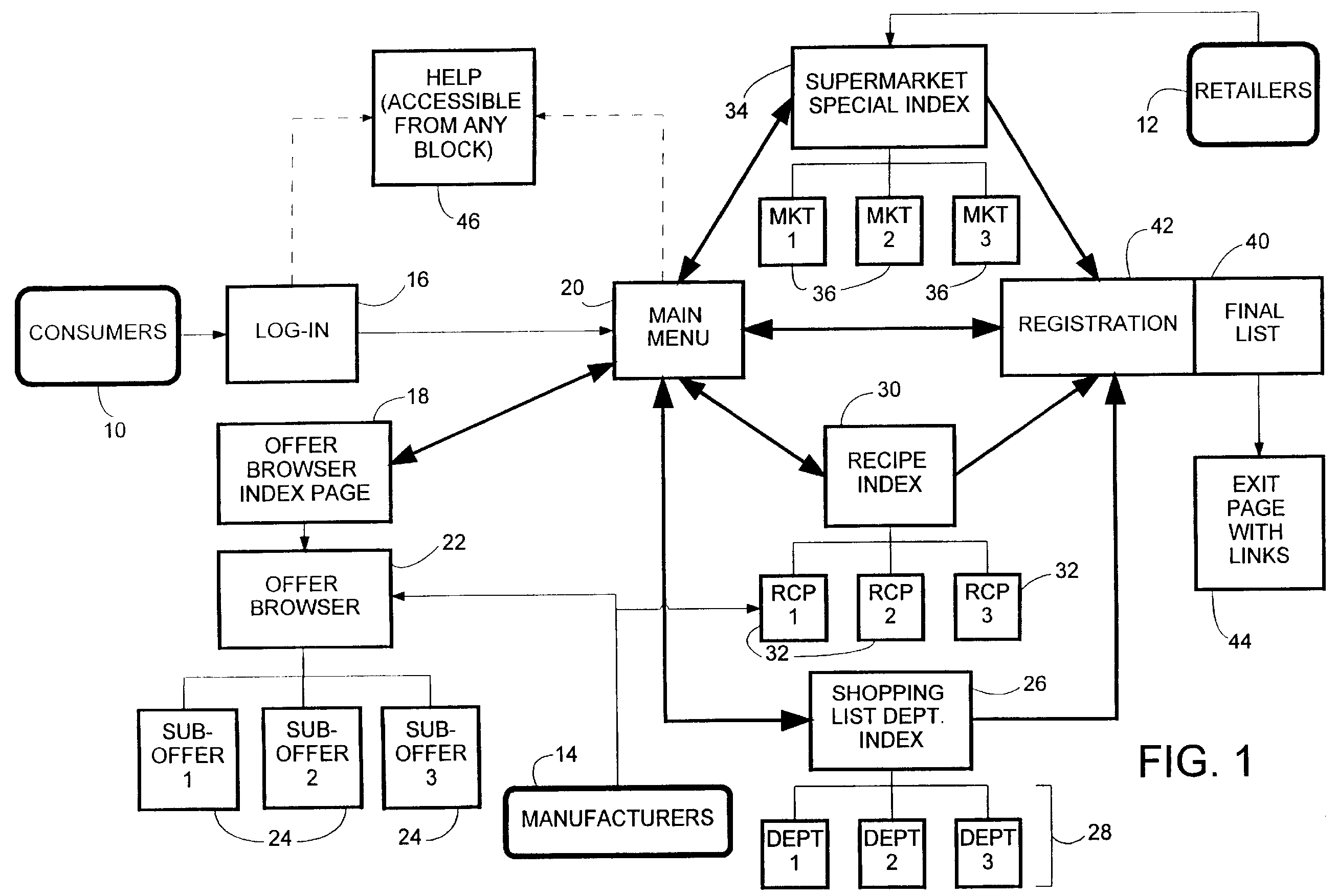
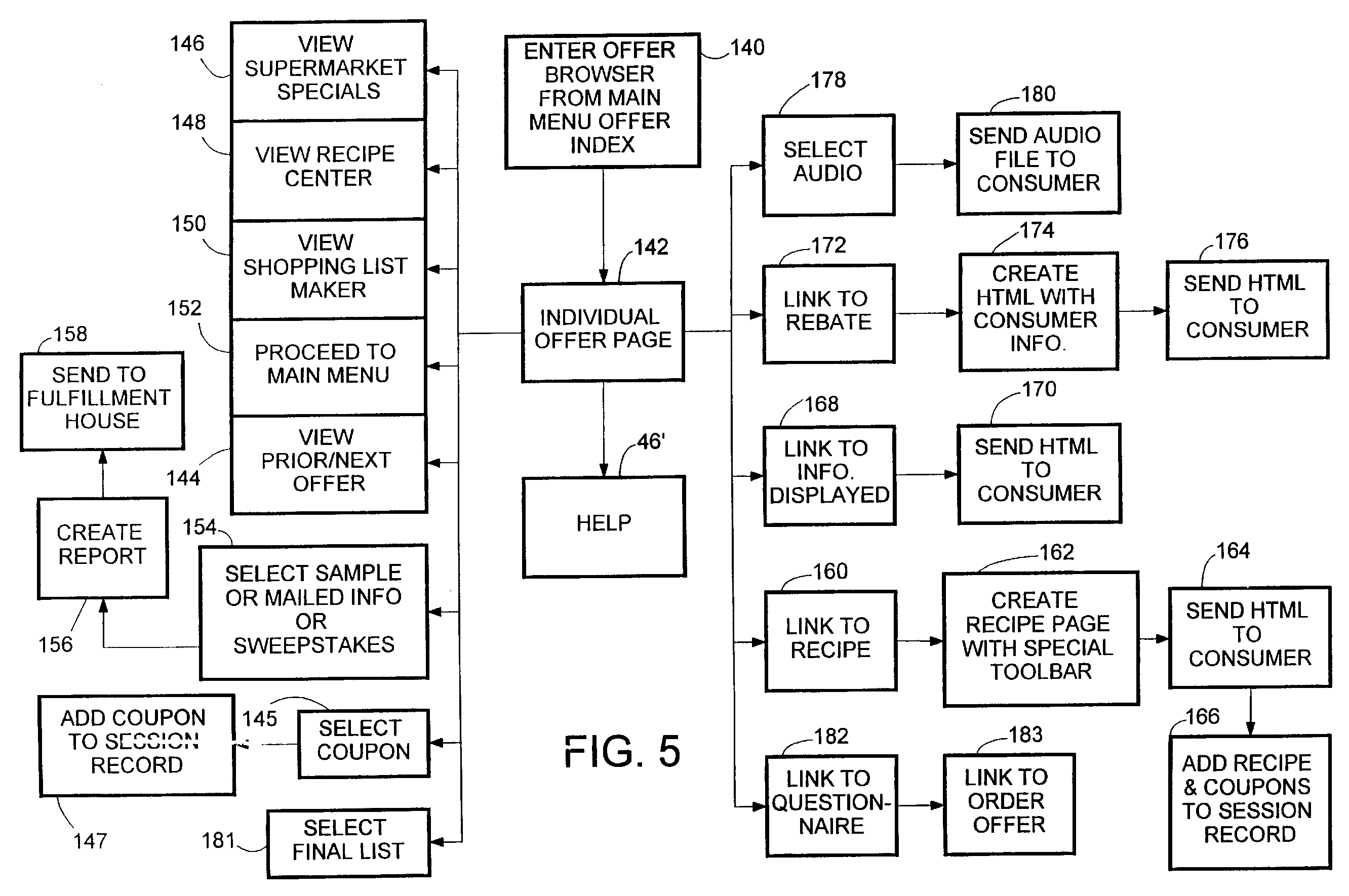
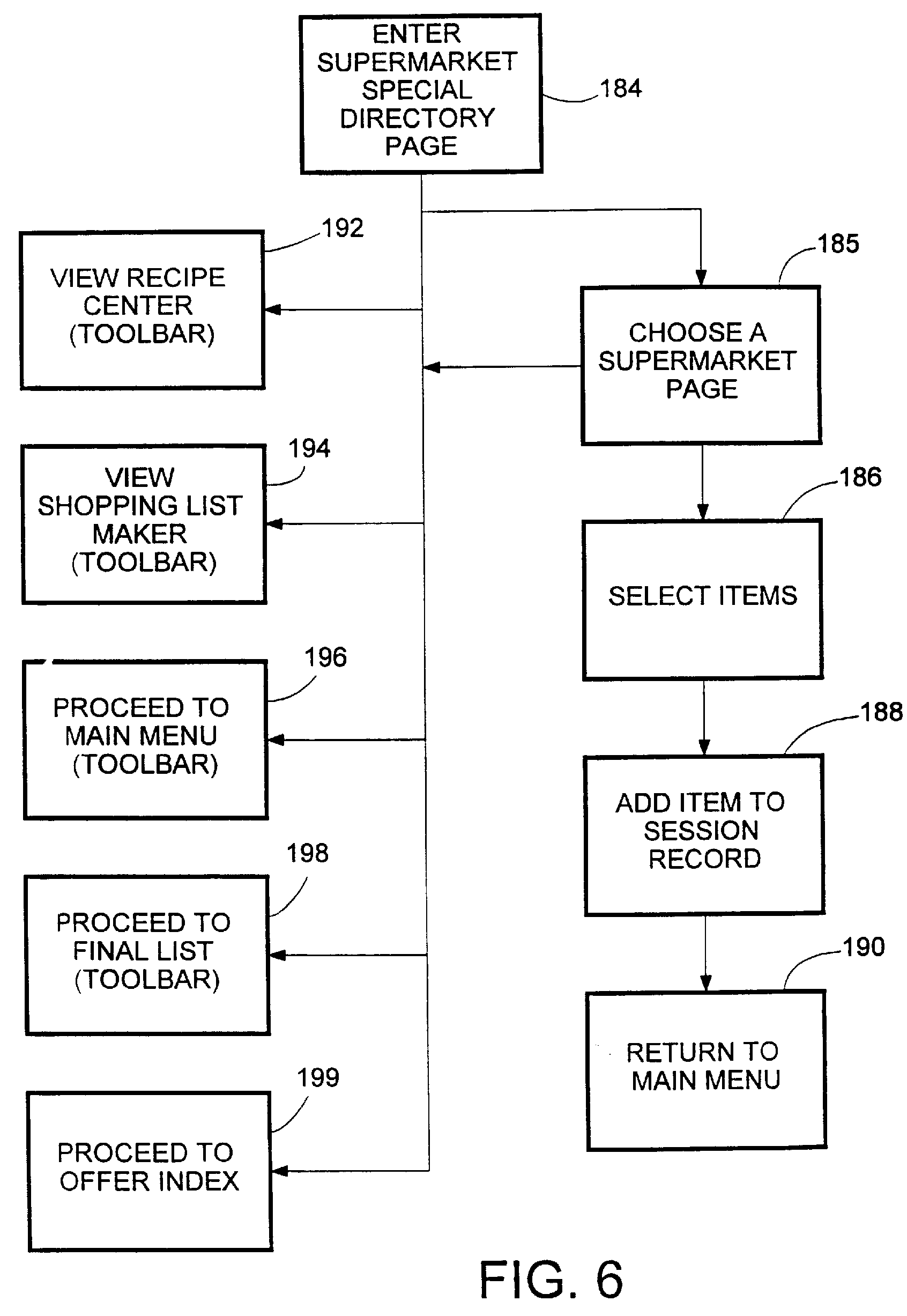
Coupons, incentives and recipes are added to the session record. There is a checkout apparently (1) to display a questionnaire (2) to stimulate coupons,
incentives and recipe selection. 6,014,634 disables one click because in this context it would probably cut profits.
CompuServe was granted a number of patents including:
- 5,619,559 entitled "Financial card
authorization system" filed on July 25, 1995 and whose priority date is June 25, 1992;
- 5,761,425 entitled "System for facilitating
data transfers between host computers and workstations by having a first, second and third computer programs communicate in a
matching application-level protocol" filed on December 2, 1994.
1-click is likely to have been practiced first for sales for which it does not make sense to add items to a shopping cart.
Examples are:
- Collectibles, used items, auctions.
- Perhaps computers. End consumers usually do not buy computers by numbers. They are not necessarily interested in buying printers, scanners, modems... from the same provider.
However computer sales are not necessarily of 1-click nature because (to a lesser extent for laptops and PDAs) there is a configuration step in which the user may select options such as amount of memory,
screen size, operating system and so forth. The best example is Dell whose pages looked like this.
- Airline sites. The first airlines to have practiced Web sales are likely to be Alaska Airlines in USA and British Midland whose story is
reported by Wikipedia. This is confirmed by several sources including answer.com.
Northwest can have anticipated 1-click as suggested in this
Reservation page of June 5, 1997.
United airlines provided United Connection that was using a piece of software to download from their site.
GDSs were created to serve travel agents. They were not necessarily in the position of providing end-consumers the means to bypass travel agents.
Their business model was to provide sale engines to travel agencies and to companies like Expedia (whose URL was originally www.expedia.msn.com - Expedia was then
a Microsoft subsidiary) who were acting as travel agents. This was probably the case of
Worldspan (partly owned by Northwest).
The exception can be Sabre whose Travelocity was providing online sales on October 17, 1996
and before Travelocity Sabre had a EasySabre product.
I found conference documents about the British Midland implementation. They were using a http://www.iflybritishmidland.com/ URL to provide a Cyberseat service.
The most interesting conference transcript reads:
"You flag for the country you wish to depart from, for the purposes of today we will go from the UK. We particularly like the departure map. Again you could have a drop-down box but you've also got a map.
In the Quickbook you don't get the maps so it saves you time. You might be happier with the drop-down box. So you can either click on one of the diamonds for the airport you wish to depart from or you can go
to the drop-down box. And again you get a map for destination as well. We'll go to Amsterdam and you can see from the map that all the red areas are faded out and that was because when I picked London Heathrow
you couldn't go to those areas. So now you have a fill-in form for your outward flight date, month and time.
There is a default time setting going at 10.00 in the morning returning 16.00 but of course you can change that. You can fill in adults, children, infants and you've got your cabin types which is the last time
you will see it like this due to us changing cabin types as of next Monday. From this you can choose the option of showing flights with cheapest fares or just showing fares. So if you choose flights with cheapest
fares you are going to get real time availability from our own host system, direct into our reservations system. This is transferring data from our reservation system so it takes a little longer than any of the
other pages have."
"Now it comes back in a table format. The flights that are actually in bold there are the nearest to the actual options that you requested. You can go for more flights or you can see certain flight details.
This is real time availability that's come across from the host system.
[Here the speaker clicks on a button corresponding to a flight.]
"Now you have details of your full itinerary and you have restrictions associated with this booking, so there are no changes permitted, and its the media payment required, and tax is on there as well. You have
the option to go back for the feedback form from here as well but we'll continue with the booking."
Multiple items are displayed. The user selects one of them. There is no shopping cart because of security:
"There are a couple of security measures we have in place for the credit card as well, which I may as well tell you. You can only make 2 flights in any one day with the same credit card."
The problem is that the user enters then its payment and shipping data. It has to be the case except if she is registered.
The form used by Alaska Airlines on May 28, 1997 confirms that they were not using a shopping cart.
The user entered a request and was returned a list. Then she selected an entry in the list. But then the user had to enter her shipping and payment data after selecting flights because there was no way to
sign-in. Sign-in was added later but not necessarily in 1997.
There were articles about travel implementations:
- THE PC TRAVEL AGENT TAKES OFF published by Business Week in July 1997
- Reservations Online published in 1998 by H.B. Koplowitz
1997 is probably too early for PHP implementations. Web sale systems were using:
- CGI - written in Perl or in C (marginally in tcl) and perhaps partly in shell;
- Java and server-side Javascript in case of the Netscape server;
- Server-Side Include (SSI) that anticipated JSP and ASP.
|
